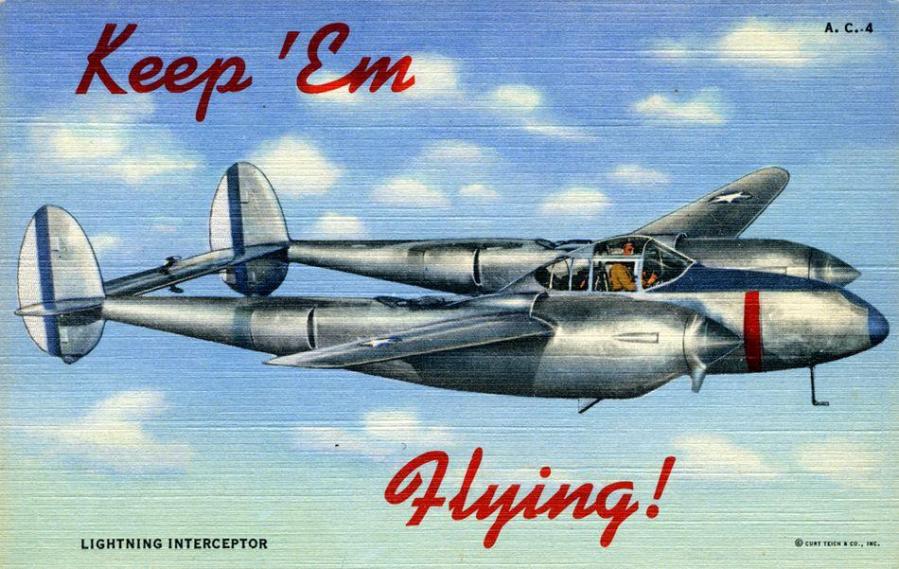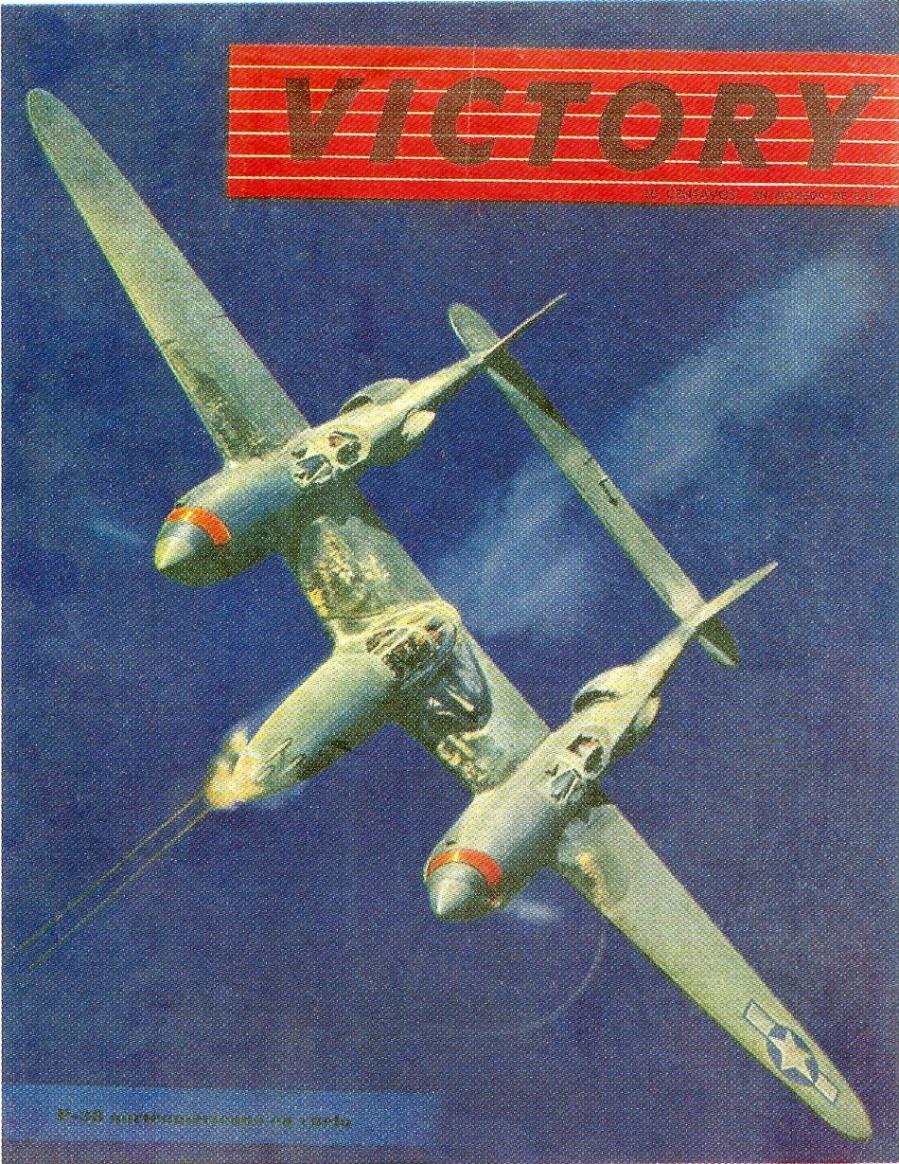Lockheed P-38 Lightning
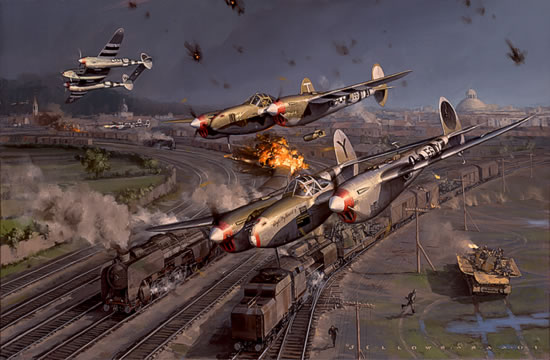
© Jack Fellows - www.jackfellows.com - En savoir plus sur Jack Fellows : cliquez ici - To know more about Jack Fellows: click here
Développement - Development
A partir de 1935, face à la menace de l'Allemagne nazie, les États-Unis lancent un projet de développement d'un intercepteur bimoteur, à long rayon d’action, capable d'emporter un armement important à haute altitude et qui pourrait être équipé de moteurs turbocompressés (encore en cours de développement).
In 1935, facing the threat of the Nazi Germany, the United States launched a development project of an interceptor twin-engine, with long operating range, able to carry an important armament at high-altitude and which could be fitted with two turbo compressed engines (still under development).
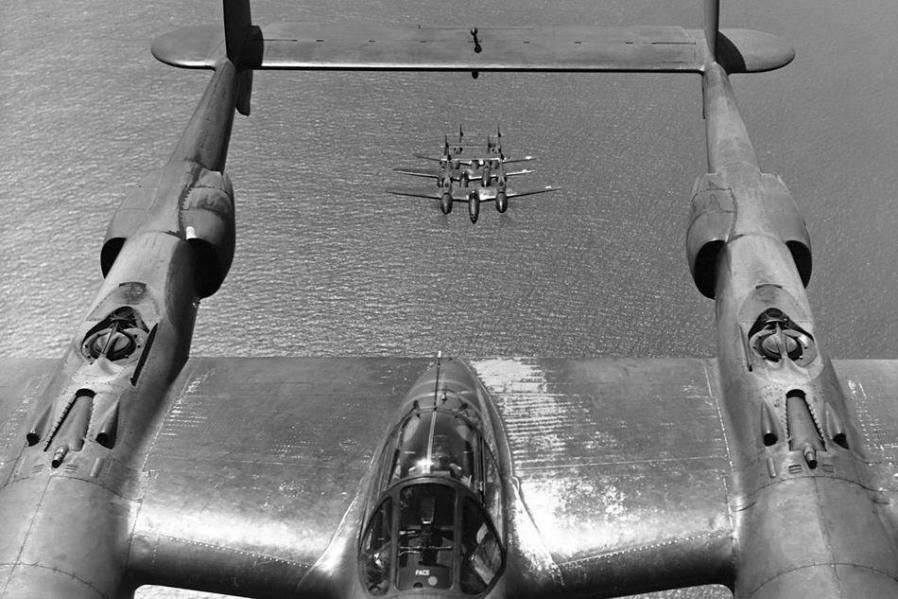
© USAF (domaine public - public domain)
Pour faciliter les manutentions au sol, cet intercepteur devrait en outre être tricycle. Toutes ces caractéristiques sont alors regroupées dans un document dit « Specification X-608 », envoyés à tous les constructeurs américains d’avions.
To facilitate handling on the ground, this interceptor should moreover be three-wheeled. All these characteristics are then gathered in a document called “Specification X-608”, sent to all American aircraft manufacturers.
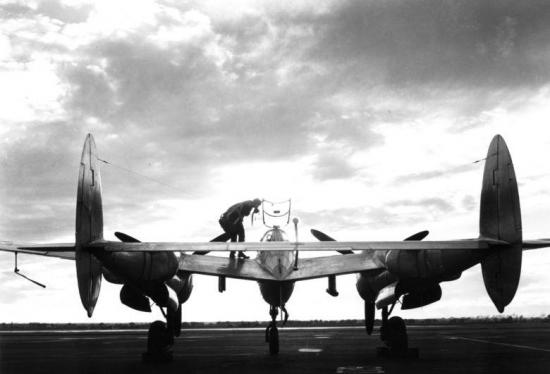
© USAF (domaine public - public domain)
À Burbank, en Californie, chez Lockheed, deux hommes prennent le dossier en main : Hall Hibbard, concepteur en chef, et Clarence L. “Kelly” Johnson, son assistant. Johnson jette son dévolu sur le moteur V12 Allison V-1710 qui lui semble prometteur en termes de puissance. Après avoir étudié différentes configurations, celle avec deux moteurs jumeaux sur un double fuselage attire leur attention. L'appareil qu'ils dessinent est un tricycle, conformément aux spécifications. Pour l'armement, le nez leur paraît être une excellente plate-forme de tir.
In Burbank, California, at Lockheed, two men are charged of the project : Hibbard hall, chief engineer, and Clarence L. “Kelly” Johnson, his assistant. Johnson chooses the engine V12 Allison V-1710 which seems promising in terms of power. After having studied various configurations, the one with two twin engines on a double fuselage keeps their attention. The aircraft that they design is a tricycle, in accordance with the specifications. For the armament, the nose appears to be an excellent gun platform.
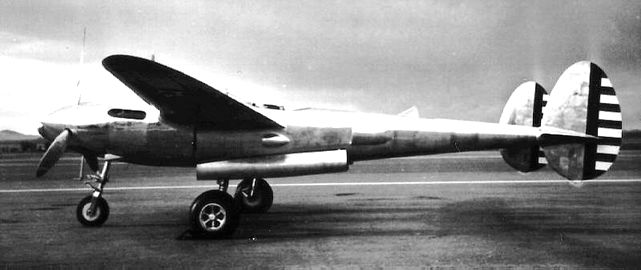
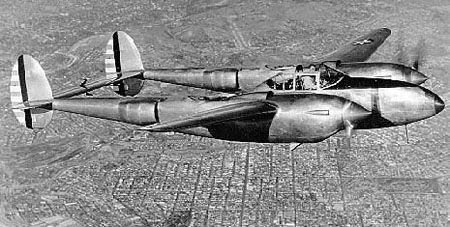
Lockheed XP-38 (s/n 37-457) © USAF (domaine public - public domain)

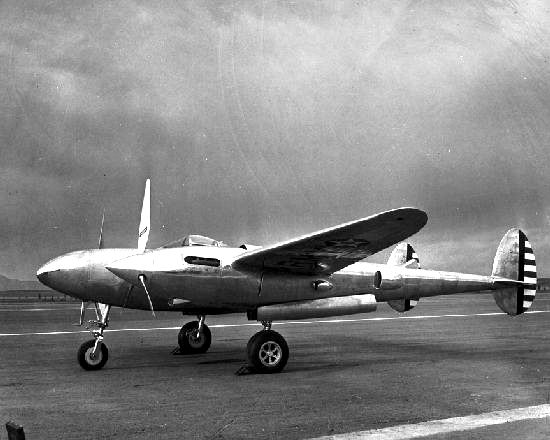
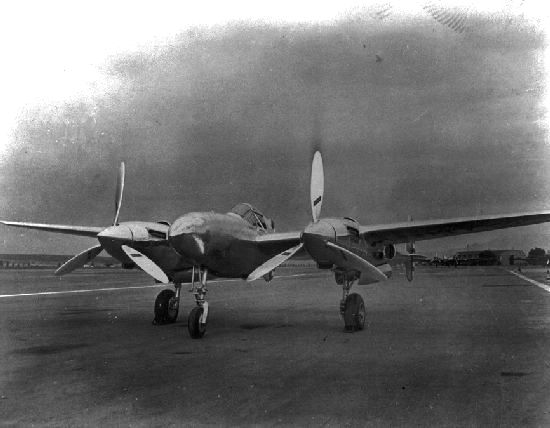
Lockheed XP-38 (s/n 37-457) © San Diego Air and Space Museum archives
Le nouvel appareil dérive dans sa géométrie du Lockheed L-12 Electra, lui aussi dessiné par Kelly Johnson. Un L-12 sera d'ailleurs modifié avec un train tricycle pour mener notamment des essais d'appontages, qui se révéleront concluants. Après de nombreux dessins et de nombreuses études, le travail présenté est assez convaincant pour l'armée, qui, le 23 juin 1937, attribue un contrat de 163 000$ pour la construction d'un prototype XP-38 (numéro de série 37-457).
The new aircraft comes in its geometry from the Lockheed L-12 Electra, also designed by Kelly Johnson. A L-12 will be even modified with a three-wheeled undercarriage in particular to carry out tests of landings on aircraft-carriers, which will appear conclusive. After many designs and studies, work presented is convincing enough for the army, which, on June 23, 1937, allots a contract of 163.000$ for the construction of a prototype XP-38 (serial number 37-457).
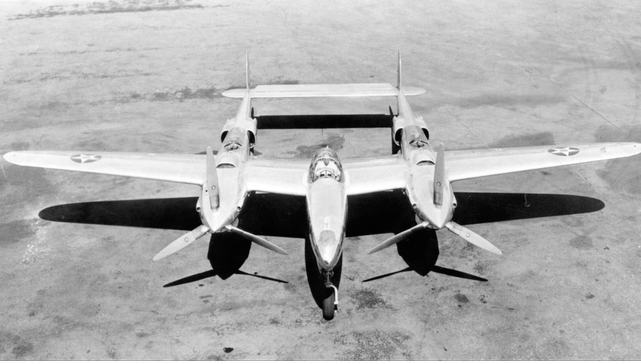
Lockheed XP-38 (s/n 37-457) © San Diego Air and Space Museum archives
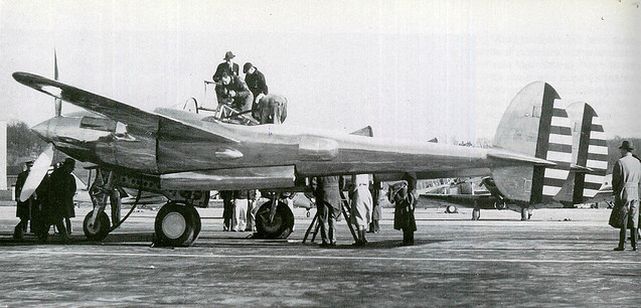
Lockheed XP-38 (s/n 37-457)
faisant le plein à Wright Field, Dayton, Ohio, le 11 février 1939 - being refueled at Wright Field, Dayton, Ohio, on 11th February, 1939
Photo : auteur et source inconnus - author and source unknown

1st Lt Benjamin Scovill Kelsey (ici dans un Curtiss P-36A - here in a Curtiss P-36A)
© USAF (domaine public - public domain)
Le prototype du P-38 effectue son premier vol le 27 janvier 1939 aux mains de Marshall Headle. Le 11 février 1939, le 1er Lieutenant Benjamin Scovill (“Ben”) Kelsey, tenta sur le XP-38 un record de vol transcontinental depuis March Field, Riverside, California, à Mitchel Field, Long Island, New York.
The prototype of P-38 makes its first flight on January 27th, 1939 in the hands of Marshall Headle. On 11th February, 1939, 1st Lieutenant Benjamin Scovill (“Ben”) Kelsey, attempted with the XP-38 a record-breaking transcontinental flight from March Field, Riverside, California, to Mitchel Field, Long Island, New York.
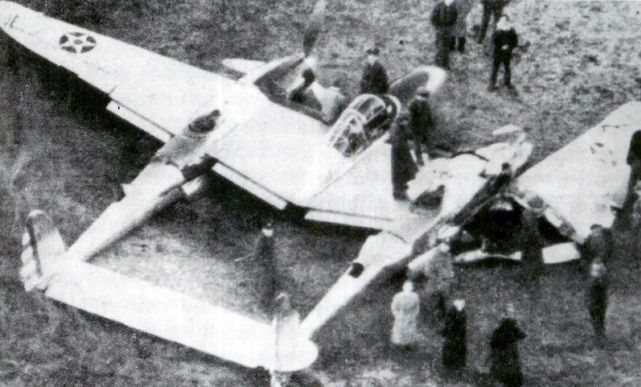
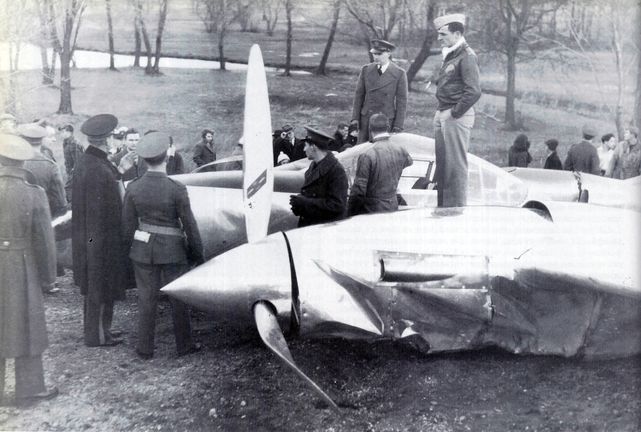
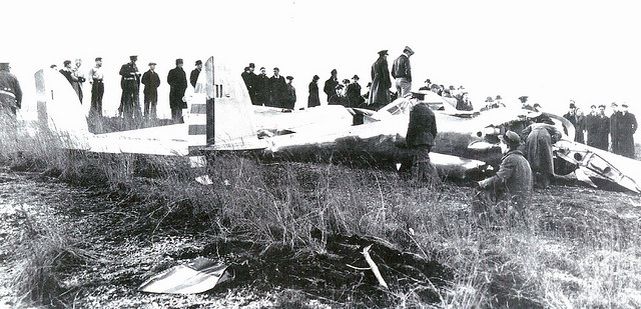
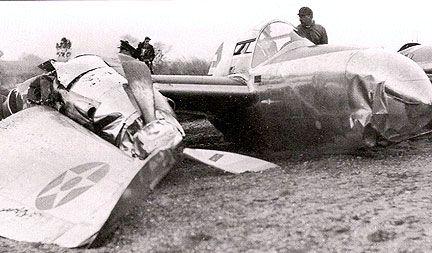
Lockheed XP-38 (s/n 37-457)
crashé près de New-York, le 11 février 1939 - crashed near New-York, on 11th February, 1939
Photos : auteur et source inconnus - author and source unknown
Le vol comprenait deux étapes pour refaire le plein à Amarillo, Texas et Wright Field, Dayton, Ohio. Mais à l'arrivée à New-York, le carburateur de l'avion givra et Kelsey se crasha dans un terrain de golf proche de l'aéroport.
The flight integrated two refueling stops at Amarillo, Texas and Wright Field, Dayton, Ohio. But when approaching New-York, the carburator iced and Kelsey had to crash the aircraft on a golf course short of the airport.
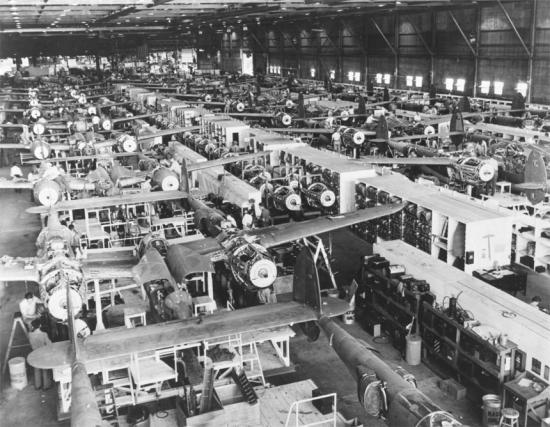
Ligne d'assemblage de P-38 -P-38 assembly line.
© USAF (domaine public - public domain)
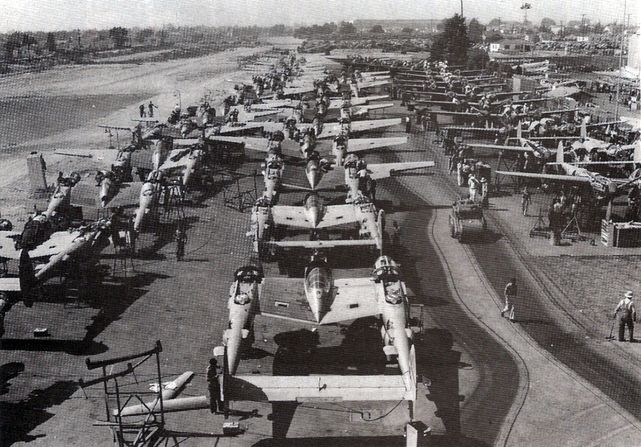
Ligne d'assemblage de P-38 en plein air, Burbank (Californie) - Open air P-38 assembly line, Burbank (California).
photo : auteur inconnu - author unknown
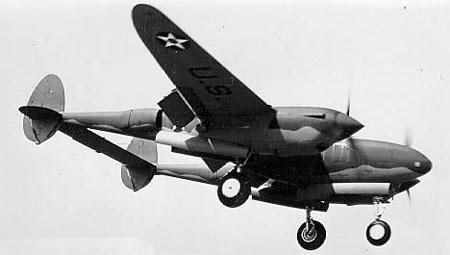
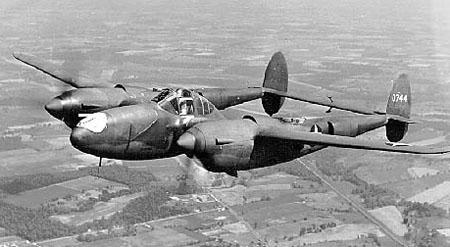
Lockheed P-38 (s/n 40-747) - 4e P-38 de production - 4th production P-38.
© USAF (domaine public - public domain)

Versions - Variants
Versions sandard - Standard variants
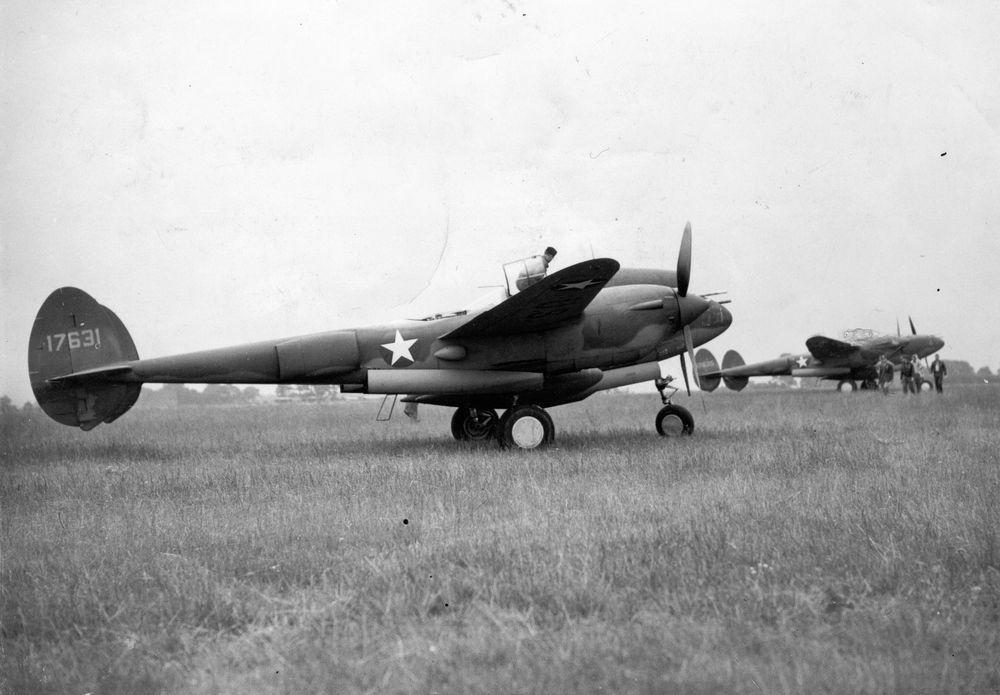
Lockheed P-38 (S/N 41-17631)
© IWM (Roger Freeman Collection - FRE 10029) - www.americanairmuseum.com
XP-38
Prototype équipé de deux moteurs Allison V12, de deux mitrailleuses Browning de 12,7 mm, deux Browning de 7.62 mm et d’un canon de calibre 23 mm (jamais installé). L'appareil bat de nombreux records mais est détruit le 11 février 1939 lors d'un atterrissage d'urgence.
Prototype fitted with two engines Allison V12, two 12.7 mm Browning machine-guns, two other 7.62 mm Browning and a 23 mm gun (never installed). The aircraft beats many records but is destroyed on February 11, 1939 during an emergency landing.
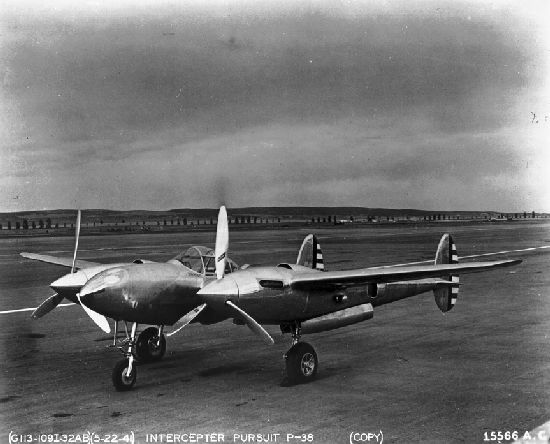
XP-38 © San Diego Air and Space Museum archives
YP-38-LO
(13 exemplaires pour les tests - 13 units for tests)
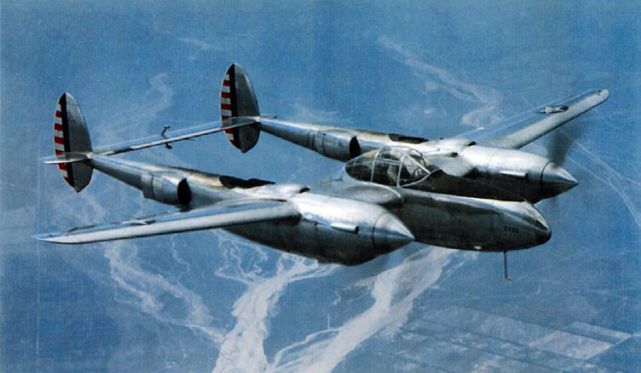
YP-38 © Lockheed Martin
Appareils semblables au prototype, à l'exception des hélices et du canon (37 mm au lieu du 23 mm). Ces appareils furent utilisés pour de nombreux tests, en parallèle de la production en série du P-38.
Aircrafts similar to the prototype, except for the propellers and the gun (37 mm instead of the 23 mm). These aircrafts were used for various tests, all along the P-38's series production.
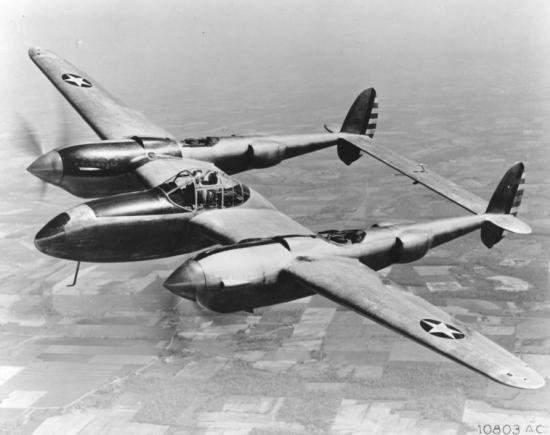
YP-38 - Avion d'essai - Evaluation plane
© USAF (domaine public - public domain)
Le prototype (s/n 39-689 - Lockheed s/n 122-2202) se crasha lors d'un test à grande vitesse, dans la cuisine d'une maison de Glendale, Californie, le 4 novembre 1941. Le pilote, Ralph B. Virden, fut tué.
The prototype (s/n 39-689 - Lockheed s/n 122-2202) crashed during a fast speed test, in the kitchen of a house at Glendale, California, on 4th November, 1941. The pilot, Ralph B. Virden, was killed.
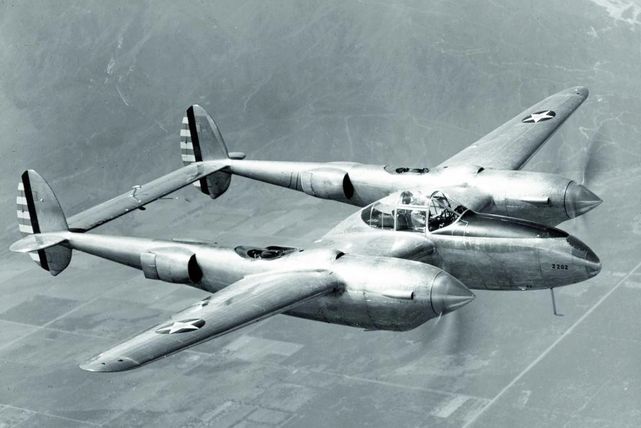
YP-38 © Lockheed Martin
Le YP-38 s/n 39-689 avait fait son premier vol le 16 septembre 1940, piloté par le pilote d'essai Marshall Headle.
Le YP-38 s/n 39-689 made its maidden flight on 16th September, 1940, flown by test pilot Marshall Headle.
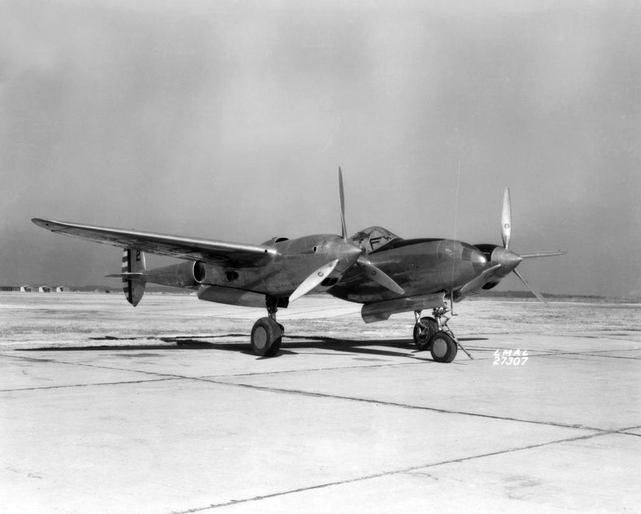
YP-38 - 39-690 © NASA
Après le vol tragique de Virden, un second YP-38 s/n 39-690 fut fabriqué et envoyé à NACA Langley Research Center, Langley Field, Virginie pour divers tests.
After Virden's tragical flight, a second YP-38 s/n 39-690 was manufactured and sent to NACA Langley Research Center, Langley Field, Virginia for various tests.
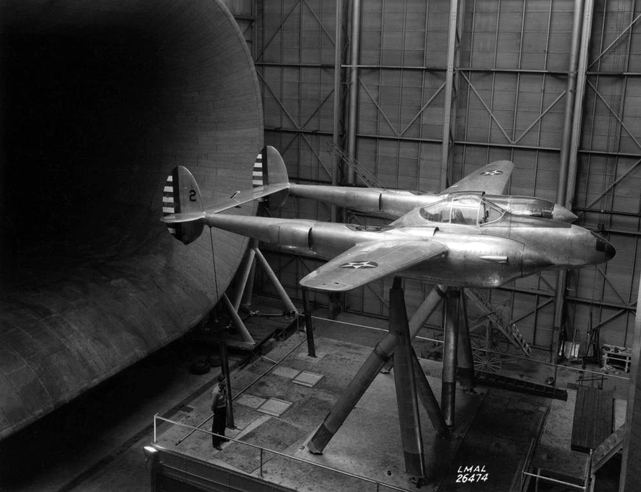
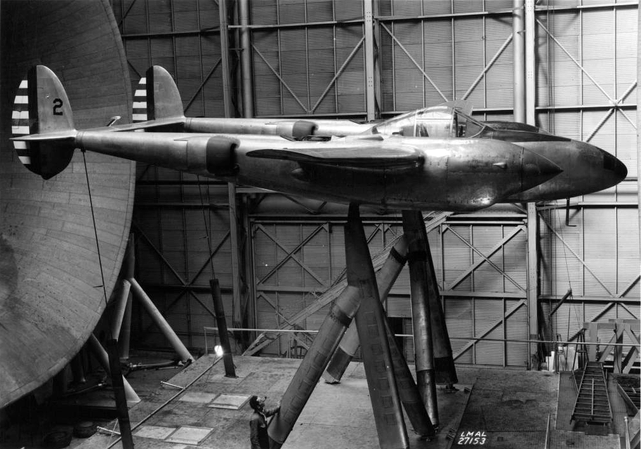
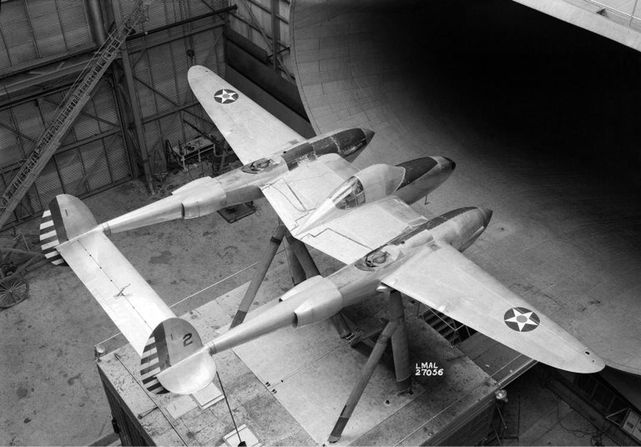
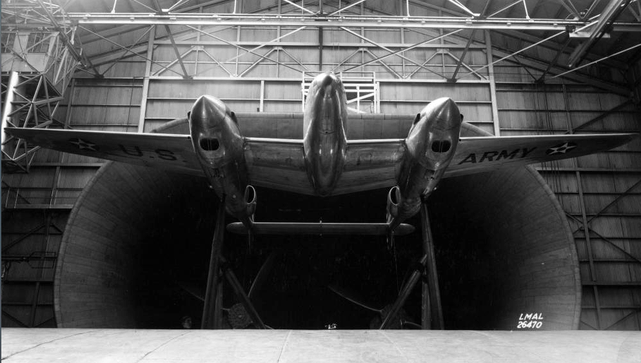
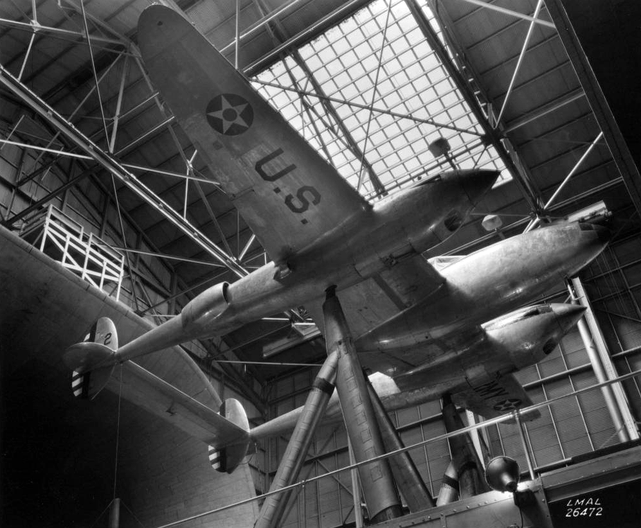
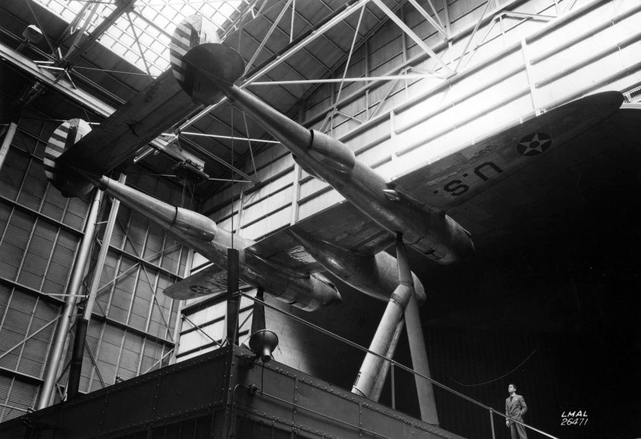
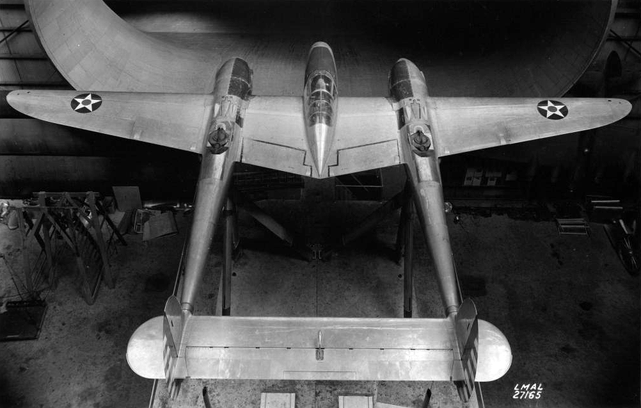
YP-38 - 39-690 © NASA
Parmi les différents modèles de YP-38, le s/n 39-692 fut modifié au niveau des masselottes d'équilibrage externes sur la gouverne de profondeur.
Among the various models of YP-38, the s/n 39-692 was modified at the level of the external balance weights on the elevator.
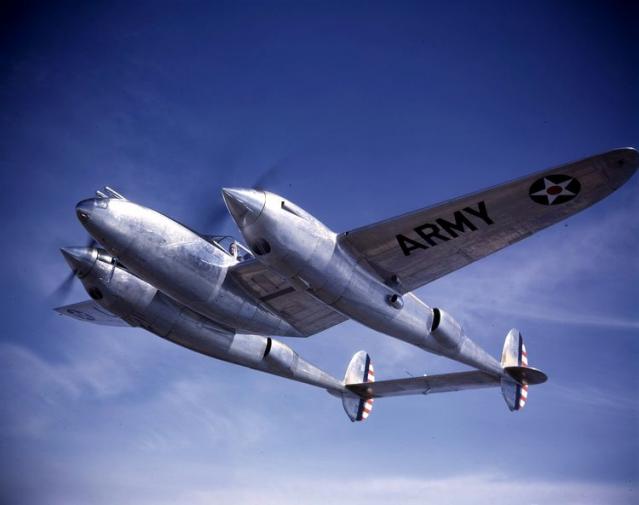
YP-38 - 39-692
© USAF (domaine public - public domain) - source : National Museum of USAF - www.nationalmuseum.af.mil
P-38-LO
(30 exemplaires - 30 units)

Lockheed P-38-LO, 1st FG, Selfridge Field, Michigan (USA), 1940.
© Thomas A. Tullis - TULLIS AVIATION ART Ltd - www.tullisart.com
Première production de série. Appareils utilisés pour les tests et l'entraînement. Blindage très limité. Quatre mitrailleuses de calibre 0.50 et un canon de 37 mm.
First units to be manufactured. Aircrafts used for tests and trainings. Very limited shielding. Four 12.7 mm machine-guns and one 37 mm gun
XP-38A-LO
Prototype destiné à tester le cockpit pressurisé.
Prototype developed to test the pressurized cockpit.
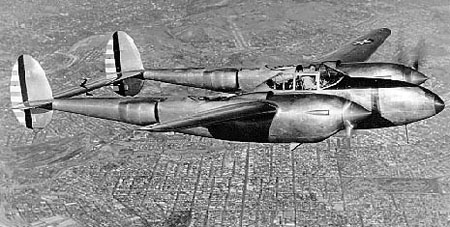
XP-38A - (s/n 40-762) - YP-38 modifié, modified YP-38)
© USAF (domaine public - public domain) - source : National Museum of USAF - www.nationalmuseum.af.mil
P-38D-LO
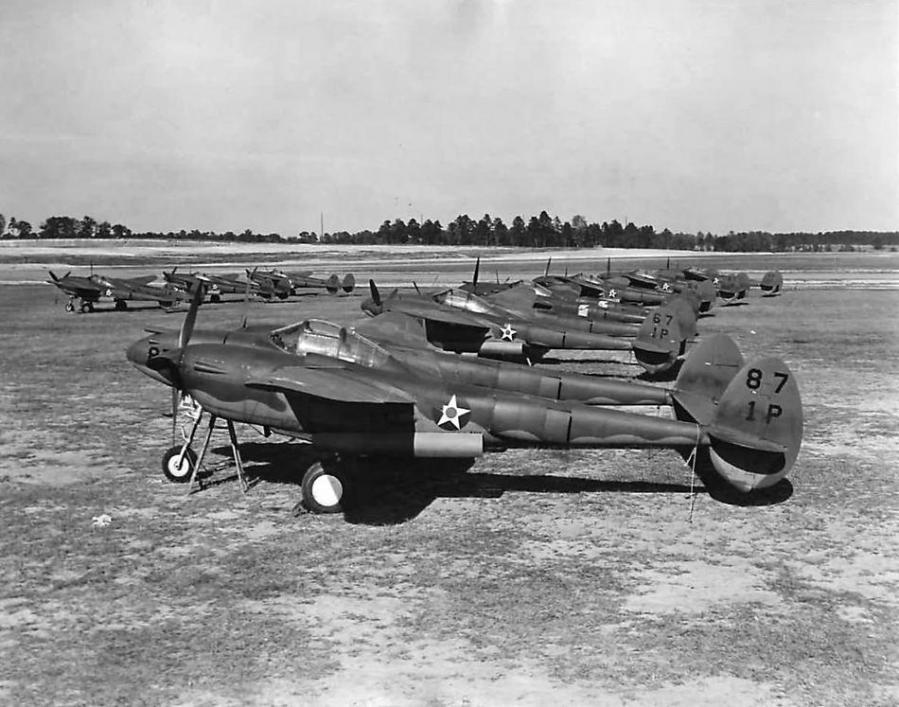
Lockheed P-38D - 1st Pursuit Group, 1941 - Photo : auteur inconnu - author unknown
Presque identique au P-38-LO, mais avec des réservoirs auto-obturables, blindage plus épais. Ajout des phares et d'un système d'oxygène basse-pression.
Almost identical to the P-38-LO, but with self-sealing tanks and a thicker shielding. Addition of headlights and a system of low pressure oxygen.
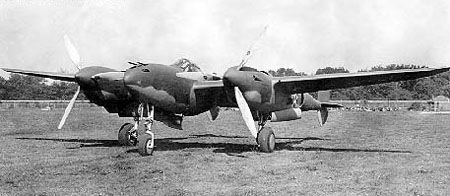
P-38D - (s/n 40-774 - Premier P-38D de production, first production P-38D)
© USAF (domaine public - public domain) - source : National Museum of USAF - www.nationalmuseum.af.mil
P-38E-LO
(210 exemplaires – 210 units)
Semblable au P-38D. Système hydraulique modifié. Canon de 37 mm remplacé par un canon de 20 mm. La plupart des exemplaires sont équipés d'une radio SCR274N. Quelques exemplaires sont convertis en F-4-I-LO. Quelques exemplaires spéciaux.
Similar to the P-38D. Modified hydraulic system. Canon of 37 mm replaced by a gun of 20 Misters the majority of the specimens are equipped with a radio SCR274N. Some specimens are converted into F-4-I-LO. Some special units.
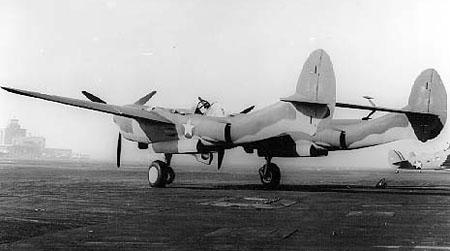
P-38E avec queue relevée, with upswept tail
© USAF (domaine public - public domain) - source : National Museum of USAF - www.nationalmuseum.af.mil
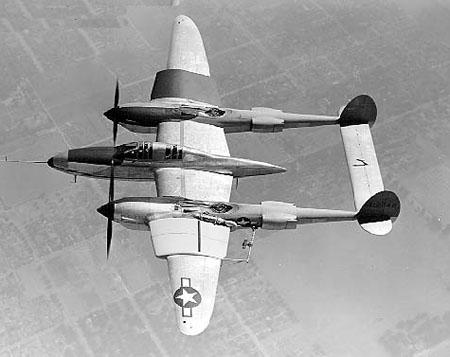
P-38E "Swordfish" avec aile laminaire spéciale, with special laminor flow wing
© USAF (domaine public - public domain) - source : National Museum of USAF - www.nationalmuseum.af.mil
P-38F-LO
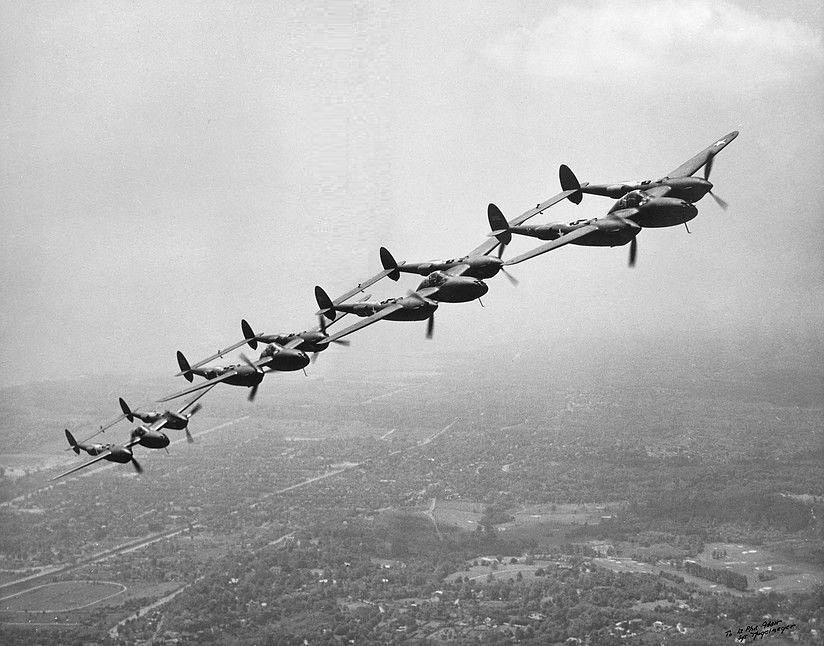
4 x Lockheed P-38F - Californie / California (USA) - Photo : auteur inconnu - author unknown
Ajout de pylônes pour installer des bombes de 2000 livres ou des réservoirs largables. Modification des volets.
Addition of pylons to install bombs of 2000 lbs or droppable tanks. Modification of the flaps.
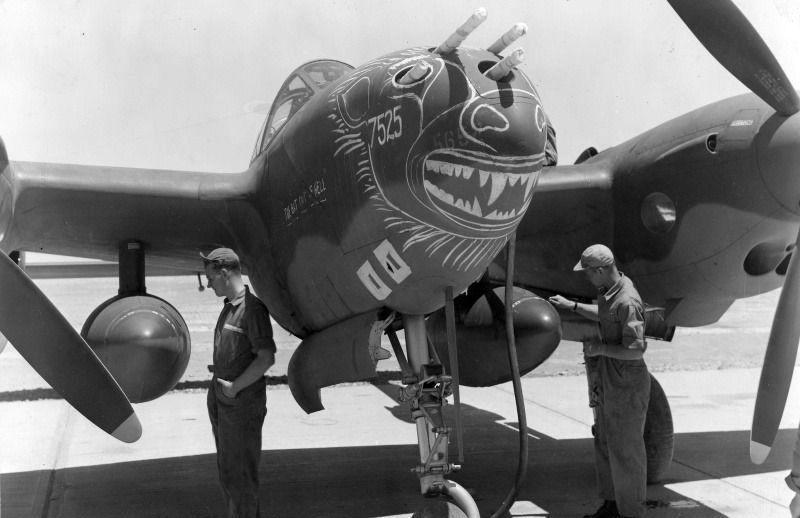
Lockheed P-38F Lightning “Bat out of Hell”, 94th FS, James J. Hagenback - Tunisie / Tunisia
© USAF (domaine public - public domain)

Lockheed P-38F Lightning, 5th AF, 339th FS - 347th FG, Thomas Lamphier
Henderson Field, Guadalcanal, 1943
© Jean-Jacques PETIT
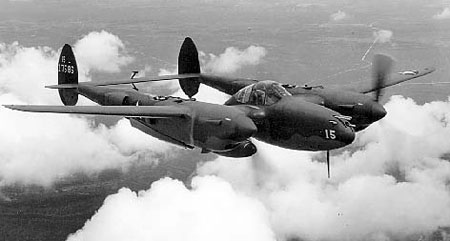
Lockheed P-38F-1-LO (S/N 41-7583)
© USAF (domaine public - public domain) - source : National Museum of USAF - www.nationalmuseum.af.mil
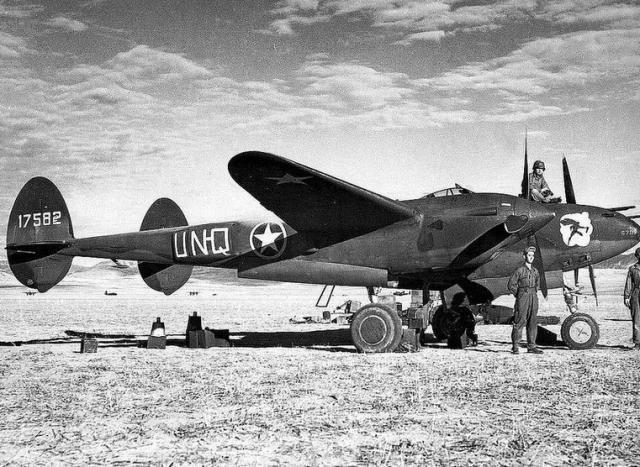
Lockheed P-38F Lightning - s/n 41-7582, 94th FS, 1st FG -Afrique du Nord, 1942 / Northern Africa, 1942
© USAF (domaine public - public domain)
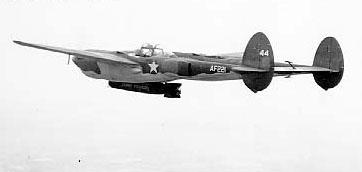 Lockheed P-38F-13-LO (S/N 43-2035)
Lockheed P-38F-13-LO (S/N 43-2035)
en vol avec une torpille factice à Muroc base - in flight ready to drop dummy torpedo at Muroc base.
© USAF (domaine public - public domain) - source : National Museum of USAF - www.nationalmuseum.af.mil.
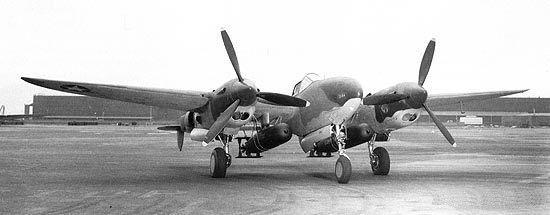
Lockheed P-38F avec 2 torpilles - with 2 torpedoes
© USAF (domaine public - public domain)

Lockheed P-38F Lightning, 5th AF, 433rd FS - 475th FG, Lt Carroll Robert Anderson (pilot), Sgt Tom Ruiz (mechanic)
Mokmer (Biak), Indonésie automne 1944 - Indonesia Autumn 1944
© Jean-Jacques PETIT
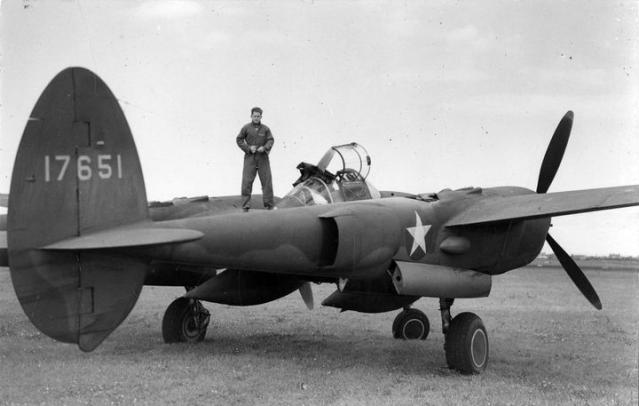
Lockheed P-38F (S/N 41-17651) - 14th FG
© IWM (Roger Freeman Collection - FRE 10033) - www.americanairmuseum.com

Lockheed P-38F 48th FS - 14th FG
Auteur et source inconnus - Author and source unkown
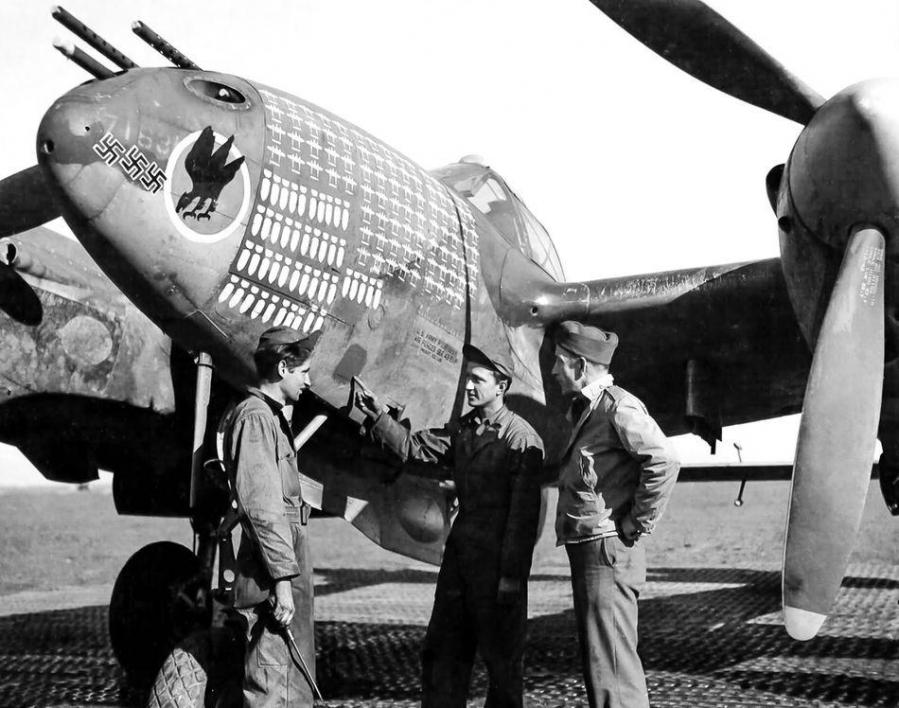
Lockheed P-38F-15-LO Lightning (s/n 43-2136) 27th FS 1st FG
© IWM (UPL 24471) - www.americanairmuseum.com
P-38G-LO
Semblable au modèle F, mais avec une nouvelle motorisation (V-1720-51/55).
Similar to model F, but with a new engine (V-1720-51/55).
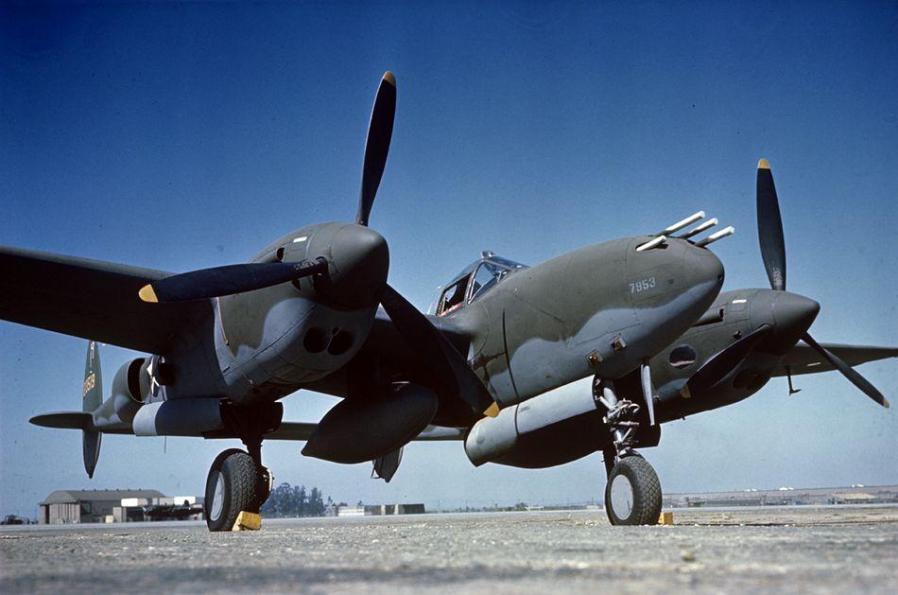
Lockheed P-38G-10-LO (s/n 41-13519) 332nd FS, 329th FG, Orange County Airport, CA (USA) - Février/February 1943
Photo FRE 7579 © IWM - www.americanairmuseum.com
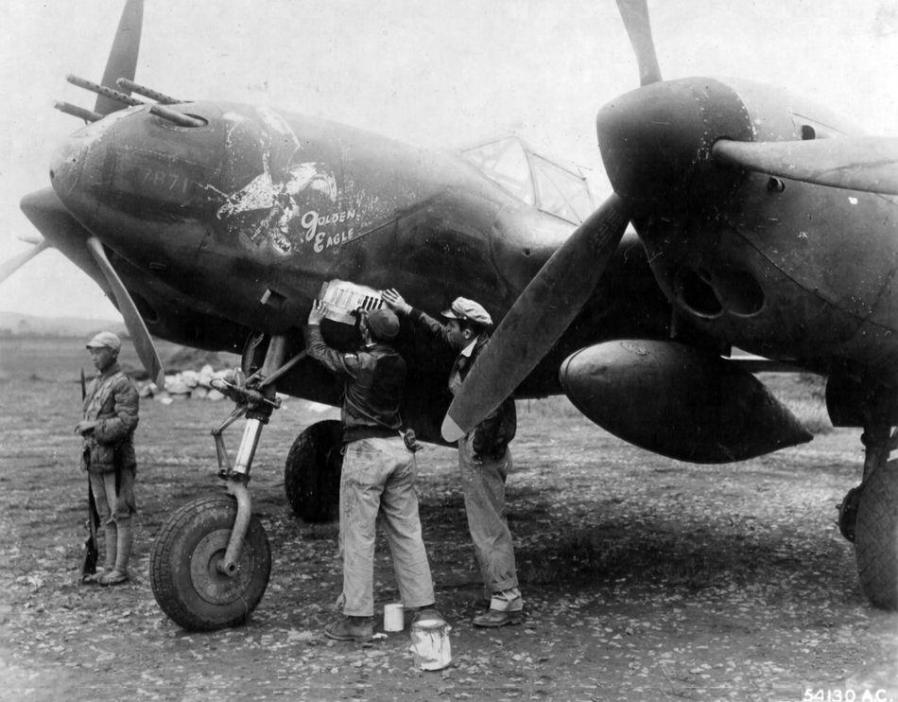
P-38G (s/n 42-13437) - 449th FS, 51st FG
© USAF (domaine public - public domain) NARA 342-FH-3A01506-54130AC

Lockheed P-38G-13-LO (ex. Lightning Mk II) (s/n 43-2312), 55th FG (USAAF)
McChord Field (état de Washington - été 1943 - McChord Fiel (Washington State), Summer 1943
© Pierre-André Tilley
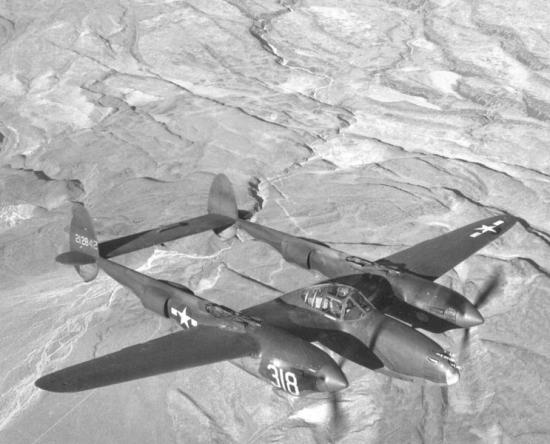
P-38G - Un P-38F amélioré - An improved P-38F.
© USAF (domaine public - public domain)
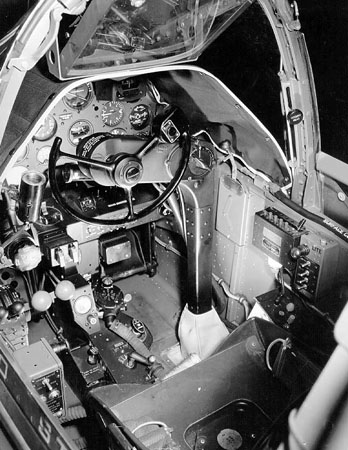
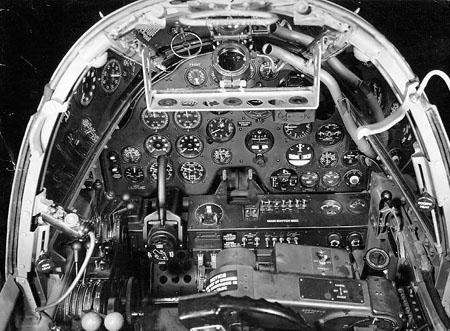
Cockpit du P-38G - Cockpit of the P-38G
© USAF (domaine public - public domain) - source : National Museum of USAF - www.nationalmuseum.af.mil
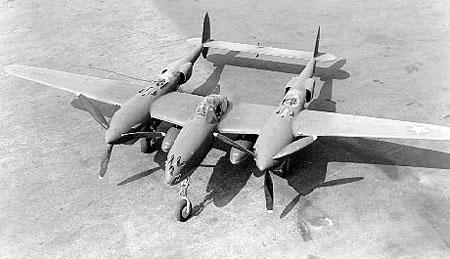
Lockheed P-38G
© USAF (domaine public - public domain) - source : National Museum of USAF - www.nationalmuseum.af.mil.
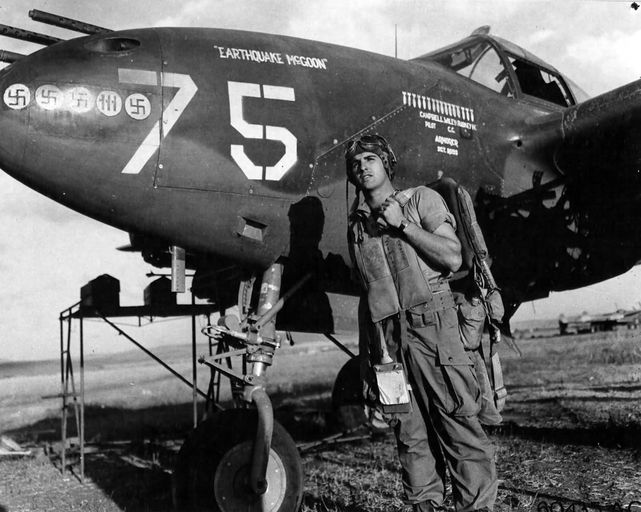
P-38G-15-LO "Earthquake McGoon", 37th FS, 14th FG, 1st Lt Richard A. Campbell
© US National Archives (domaine public - public domain)
P-38H-LO
(601 exemplaires dont 128 terminés ou convertis en F-5C-LO - 601 units including 128 completed or converted in F-5C-LO)
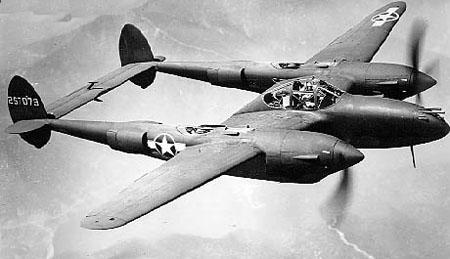
Lockheed P-38H-5-LO (s/n 42-67079)
© USAF (domaine public - public domain) - source : National Museum of USAF - www.nationalmuseum.af.mil.
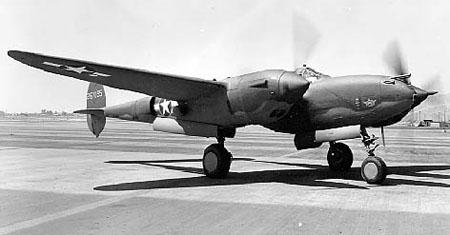
Lockheed P-38H (s/n 42-67095)
© USAF (domaine public - public domain) - source : National Museum of USAF - www.nationalmuseum.af.mil.
Motorisation par deux V-1710-51/55 à refroidissement liquide. Renforcement de la structure pour emporter une charge de 3.200 livres.
Motorized by two V-1710-51/55 with cooling liquid. Reinforcement of the structure to carry a load of 3.200 pounds.
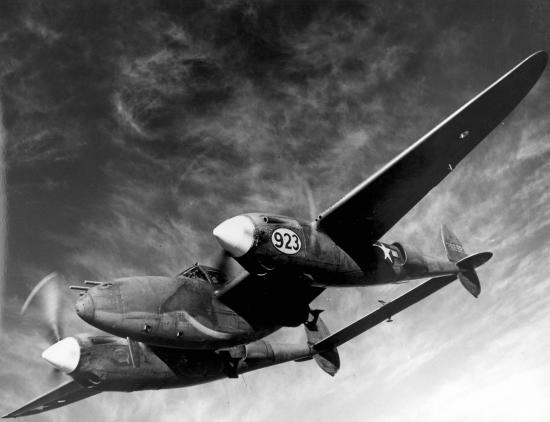

P-38H-5-LO (s/n 42-66923)
Centre Tactique de l'AAF, Orlando, Floride, portant 2 bombes de 1000 livres pendant des test, mars 1944.
AAF Tactical Center, Orlando, Florida, carrying two 1,000 lb. bombs during capability tests, March 1944.
Photo © USAF (domaine public - public domain) - Profil - Profile © F3V Factory http://profilavions.canalblog.com
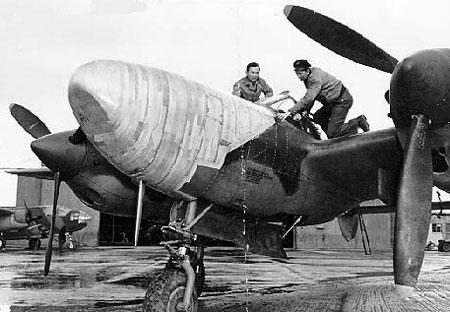
P-38H "Droopsnoot" (s/n 42-67086) prototype - prototype
© USAF (domaine public - public domain) - source : National Museum of USAF - www.nationalmuseum.af.mil
.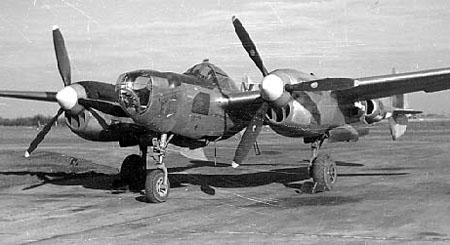
P-38H "Droopsnoot"
© USAF (domaine public - public domain) - source : National Museum of USAF - www.nationalmuseum.af.mil.
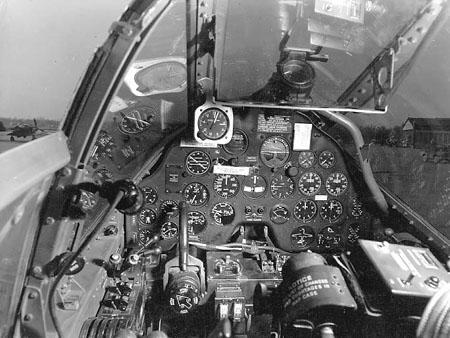
Cockpit P-38H
© USAF (domaine public - public domain) - source : National Museum of USAF - www.nationalmuseum.af.mil.
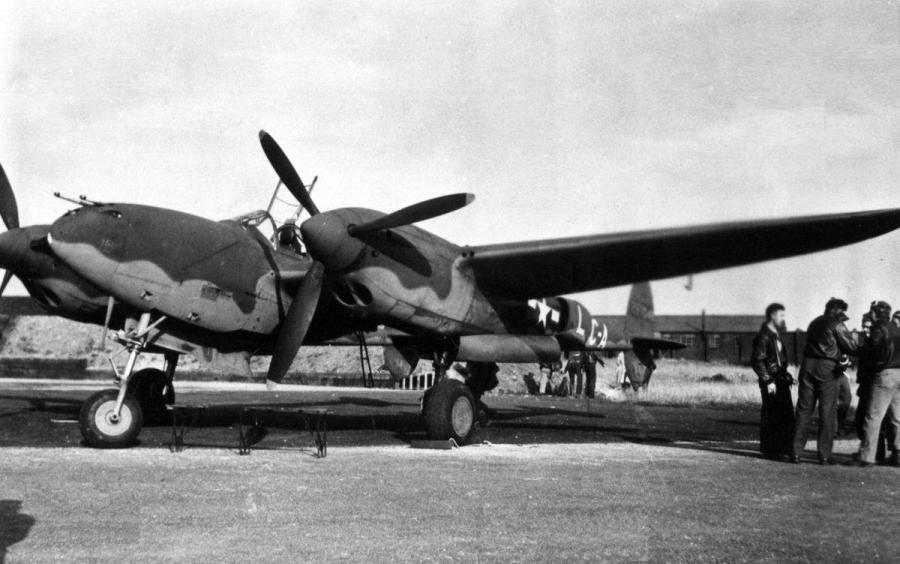
P-38H (s/n 42-67048) code LC-A
77th Fighter Squadron, 20th Fighter Group, Angleterre.
77th Fighter Squadron, 20th Fighter Group, England
Photo IWM © American Air Museum - Roger Freeman Collection FRE 2409
P-38J-LO
(2970 exemplaires dont variantes F-5E et F-
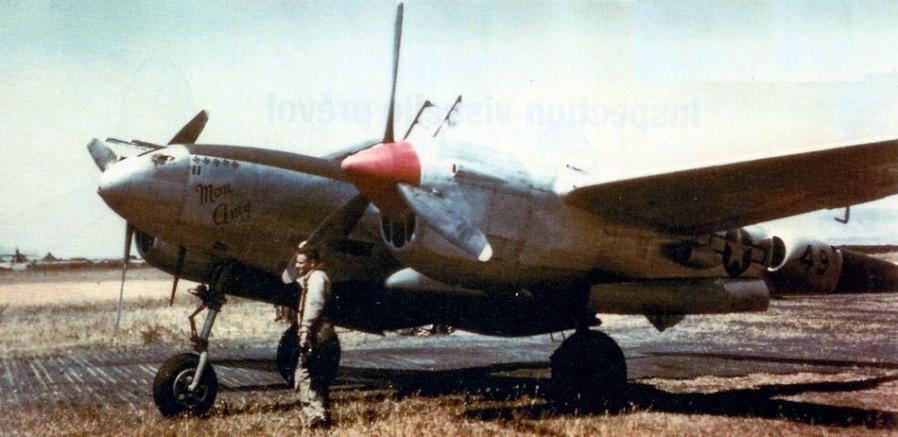
Lockheed P-38J Lightning 'Mon Amy', 71st FS 1st FG - 'Stub' Hatch.
Hatch devint as en un jour en abattant cinq IAR 80 lors d'une mission sur Ploesti (Roumanie)
Hatch became ace in one day by shooting down five IAR 80s during a mission over Ploesti (Romania)
© USAF (domaine public - public domain)

Lockheed P-38-J-15-LO (s/n 44-23156), 36th Bomb Squadron, 1st Air Division.
Royaume-Uni, 1945 - United-Kingdom, 1945.
© Thomas A. Tullis - TULLIS AVIATION ART Ltd - www.tullisart.com
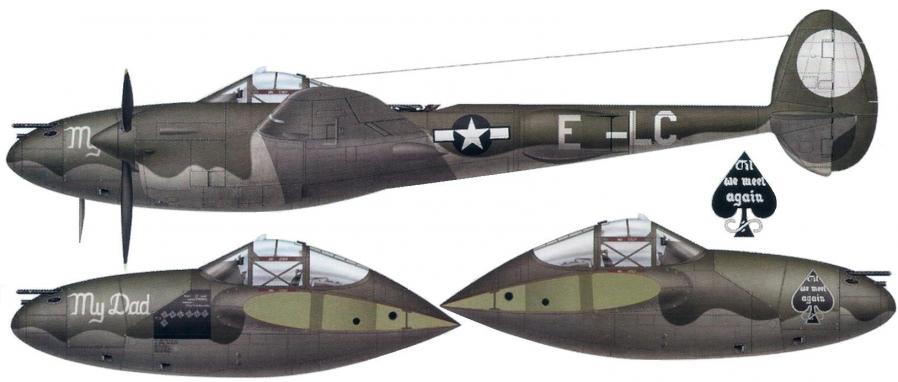
Lockheed P-38J (code LC-E), 77th Fighter Squadron, 20th Fighter Group, 1st Lt. James M. Morris
Kingscliffe, Angleterre, février 1944 - Kingscliffe, England, February 1944.
© Jean-Marie Guillou - Target for today
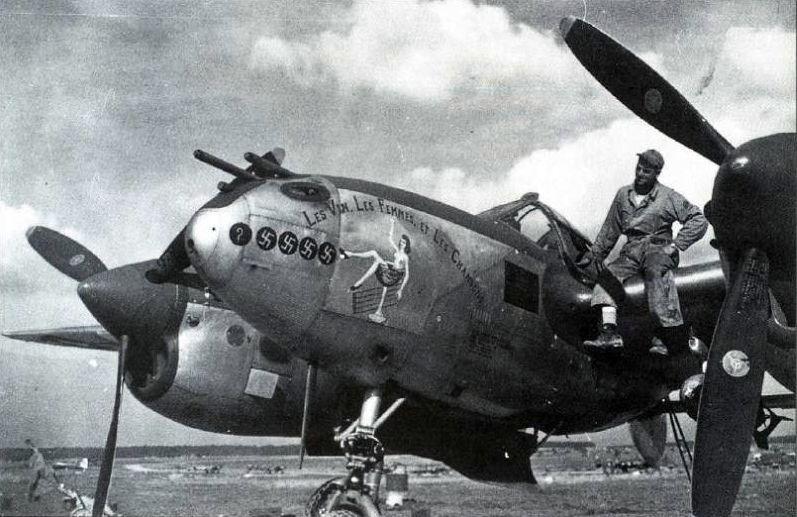
Lockheed P-38J Lightning, 485th FS, 379th FG - 'Les Vin, Les Femmes et les Chansons', Cap. Paul Sabo.
© USAF (domaine public - public domain)

Lockheed P-38-J-15 (s/n 43-28746), 27th FS, 1st FG, Captain Thomas E. Maloney
Salsola, Italie, 15 août 1944 - Italy, 15th August, 1944.
© Srecko Bradic - www.sreckobradic.com
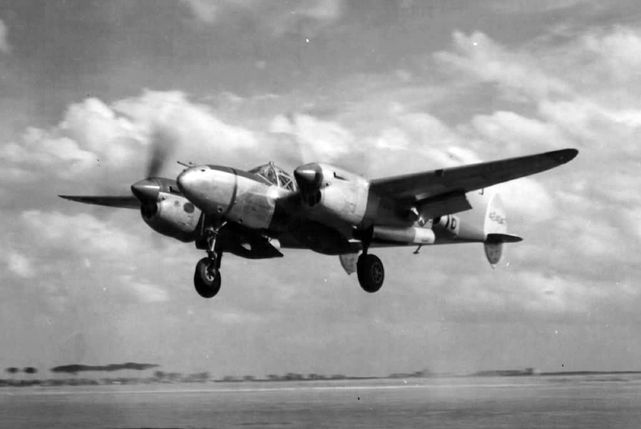
P-38J, 27th FS - 1st FG
Aghione (Corse) ou Foggia (Italie) suivant les sources
Aghione (Corsica) or Foggia (Italy) according to various sources
© US National Archives (domaine public - public domain)

Lockheed P-38J-5 Lightning, 5th AF, 6th NFS - 18th FG,
Dobodura, Papouasie Nouvelle-Guinée été 1943 - Papua New-Guinea Summer 1943
© Jean-Jacques PETIT
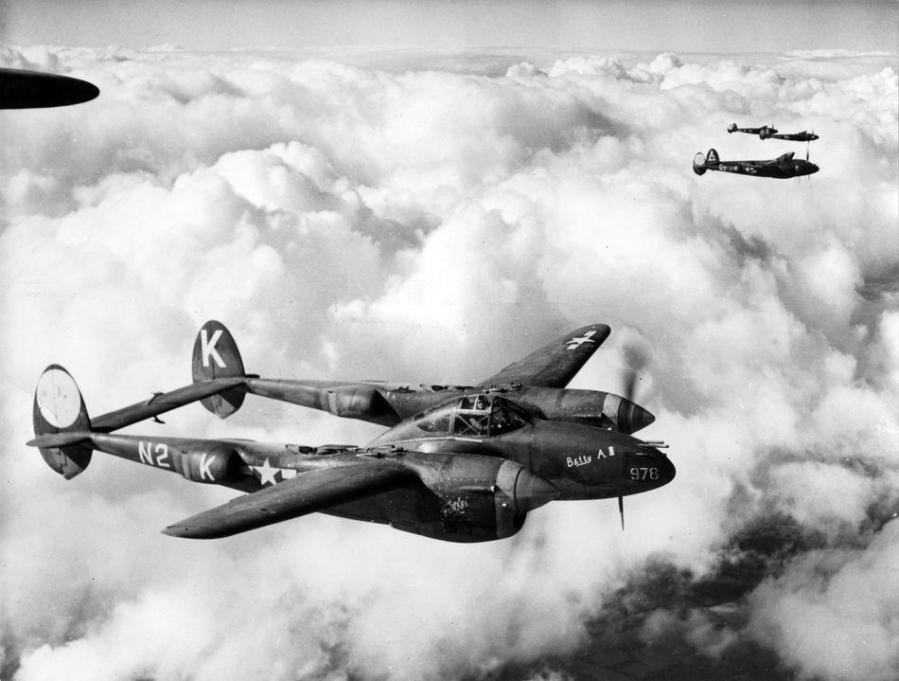
Lockheed P-38J Lightning - Au premier plan/In the forefront : P-38J (s/n 42-67978) 383rd FS - 364th FG
Photo FRE10101 © IWM - www.americanairmuseum.com
Changements physiques importants sur cette version, avec notamment de gros radiateurs pour un meilleur refroidissement. Capacité des réservoirs plus importante. Verrière plus résistante aux balles et avec une meilleure visibilité. Nouveaux volets de descente et ailerons assistés hydrauliquement.
Important physical changes on this version, with in particular large radiators for a better cooling. More important tanks capacity. Canopy more resistant to the bullets and with a better visibility. New flaps of descent and hydauliccaly boosted ailerons.
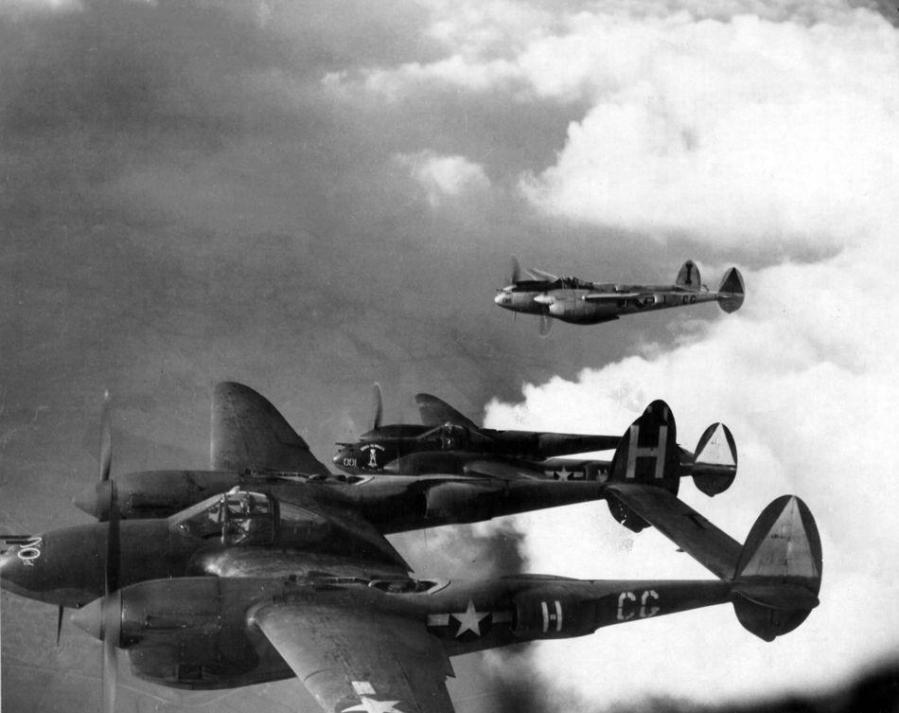
P-38J 'CG-H' (s/n 42-67811) - 'CG-U' (s/n 42-68001) - 'CG-I' (s/n 42-68132)
© USAF (domaine public - public domain) NARA 342-FH-3A16251-50665AC
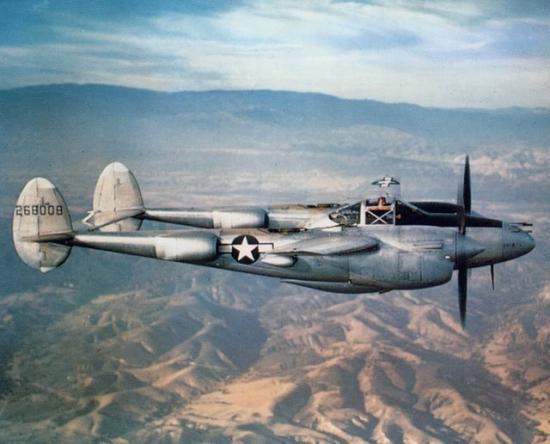
P38-J-10-LO (s/n 42-68008) survolant la Californie - flying over Southern California.
© USAF (domaine public - public domain)
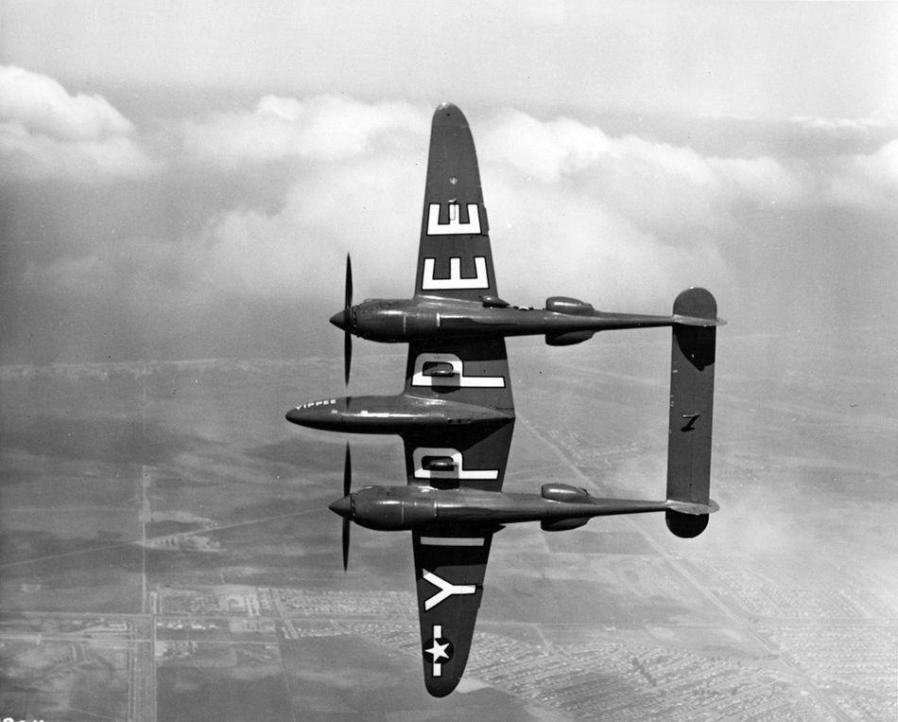
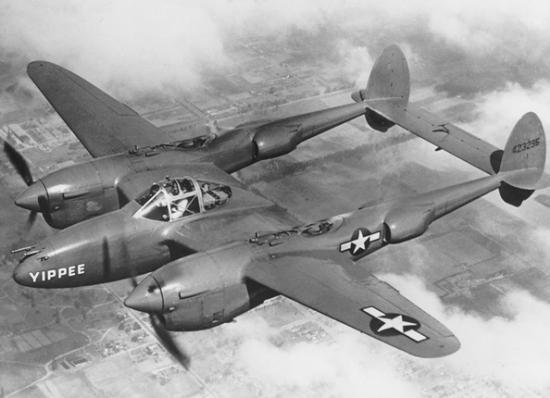

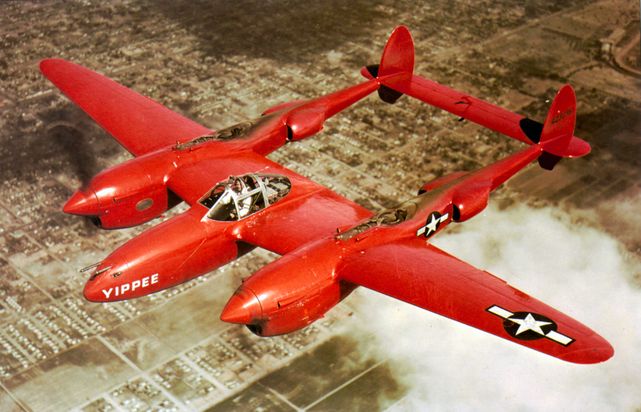
P38-J-20-LO, (s/n 44-23296) 'YIPPEE' - 5000e Lightning a être fabriqué - 5,000th Lightning to be manufactured.
Photos © USAF (domaine public - public domain) - source : National Museum of USAF - www.nationalmuseum.af.mil
Profil - profile © Herbert Ringlstetter - www.aviaticus.com
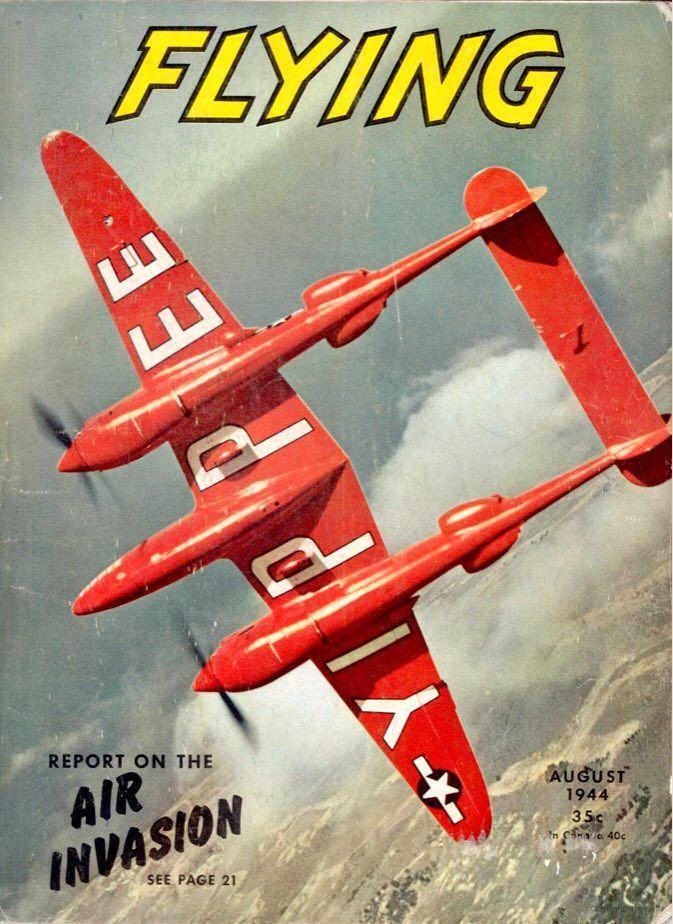
P38-J-20-LO, (s/n 44-23296) 'YIPPEE'
En couverture du magazine 'Flying' en août 1944 - On the front cover of the magazine 'Flyoing' in August 1944.
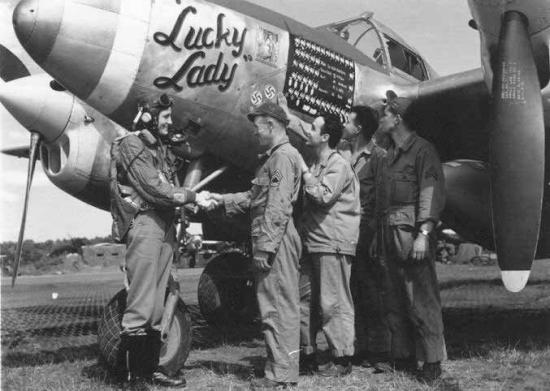
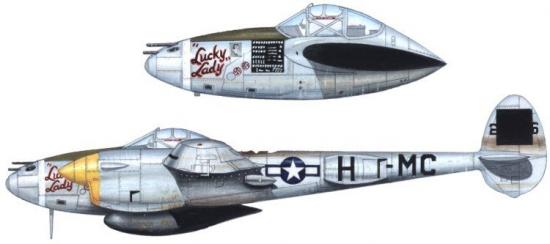
P38-J, (s/n 42-104086) 'Lucky Lady'.
Lt. Arthur W. Heiden Burton (pilot), 79th FS, T/Sgt. Max Pyles, Sgt. Cavalier, S/Sgt. Birdwell & Sgt. Fink.
© Jack Cook (photo - picture) and Nick King (profil - profile) - with courtesy of http://www.littlefriends.co.uk
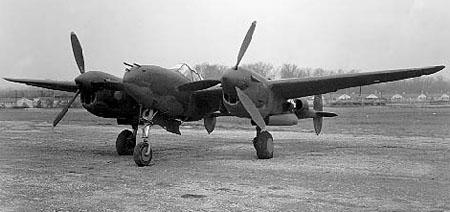
P-38J
© USAF (domaine public - public domain) - source : National Museum of USAF - www.nationalmuseum.af.mil.
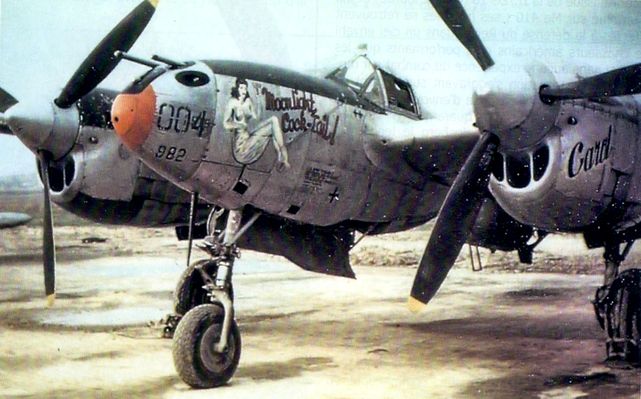
P-38J-10LO (s/n 42-68004), 2nd Lt. Clarck "Doc" Livingston, 393rd FS - 367th FG
© USAF (domaine public - public domain)
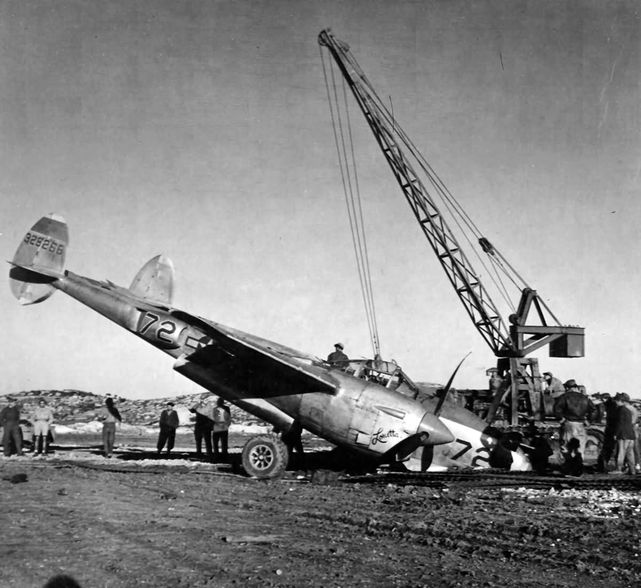
P-38J (L ?) (s/n 43-28266), 48th FS (49th ?), 14th FG, Dalmatie, Dalmatia.
© US National Archives (domaine public - public domain)
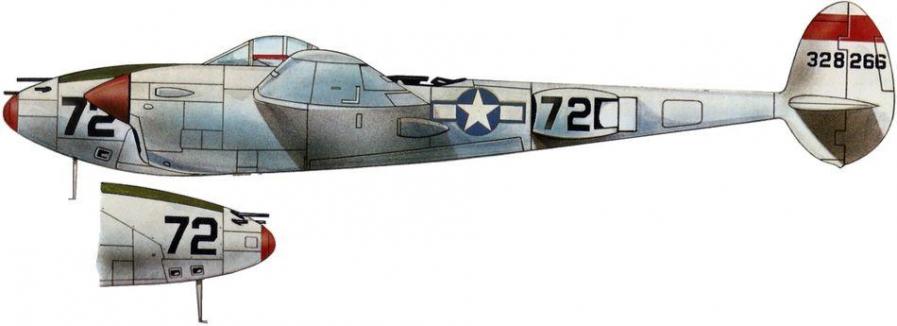
Lockheed P-38J 48th FS - 14th FG
Auteur et source inconnus - Author and source unkown
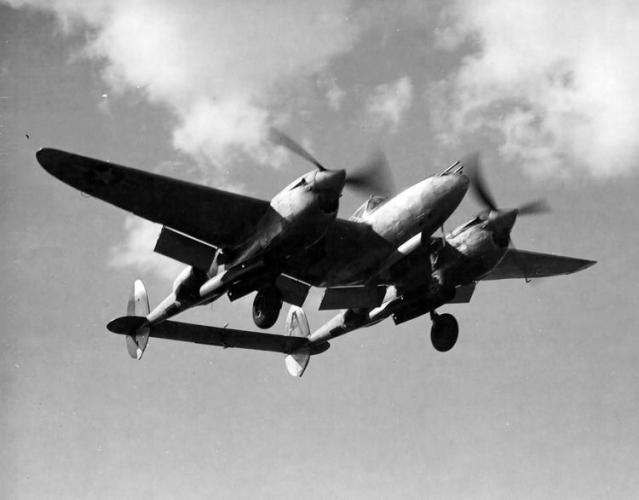
P-38J, 434th FS, 479th FG
De retour en Angleterre après une mission en Allemagne, Back in England after a mission over Germany.
© USAF (domaine public - public domain)
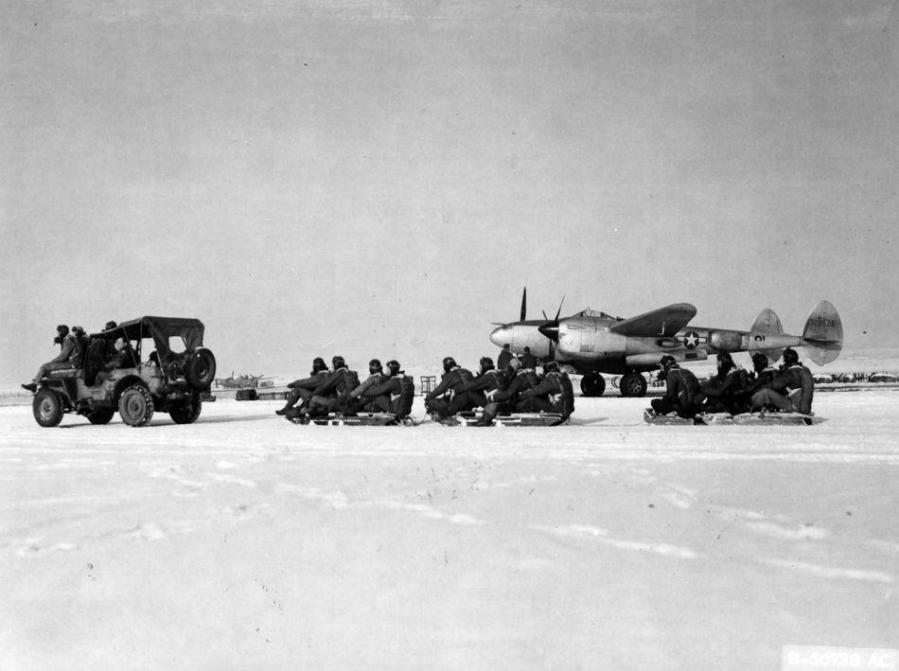
P-38J 'Val' (s/n 43-28528), 393rd FS, 367th FG, Juvincourt, France
Un moyen original de rejoindre les avions ! An original mean to reach the aircrafts !
© USAF (domaine public - public domain) NARA 342-FH-3A17048-B50738AC
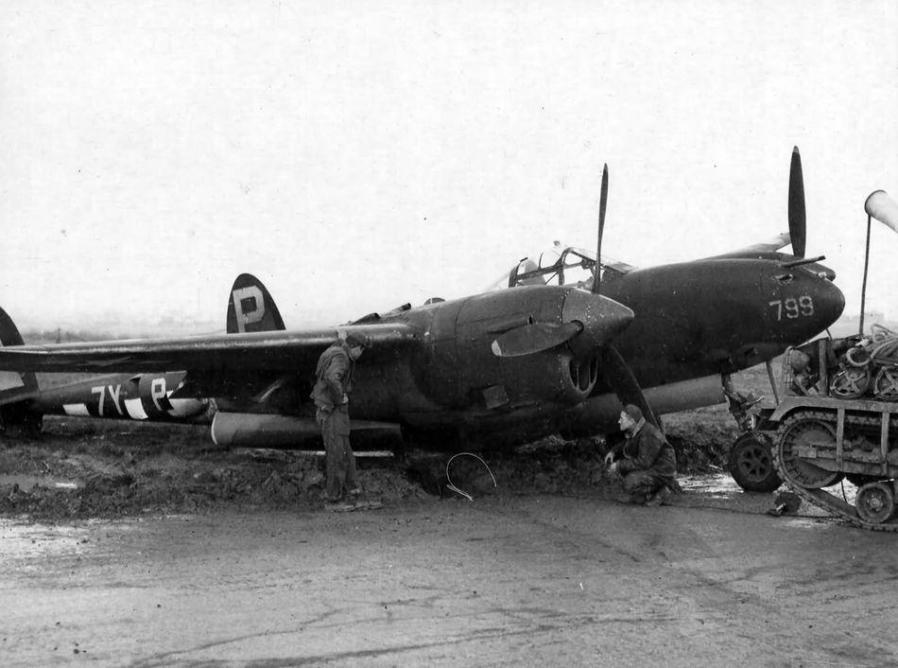
P-38J (s/n 42-67799), 429th FS, 474th FG, Embourbé quelque part en Belgique / Stuck in the mud somewhere in Belgium
© USAF (domaine public - public domain)
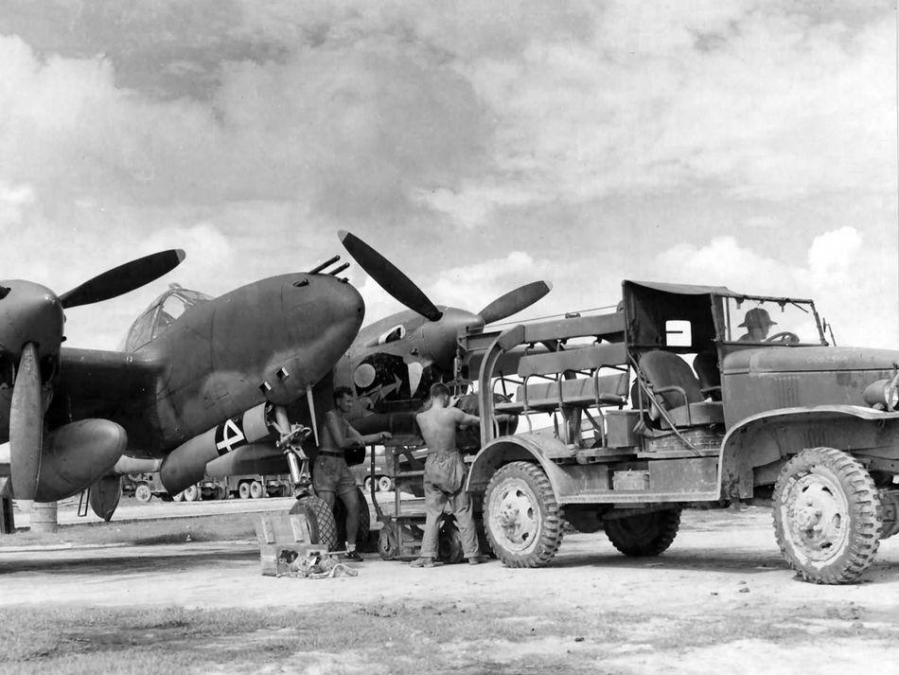
P-38J-10-LO (s/n 42-67842), 459th FS, 80th FG, Des mécaniciens installent une charge de profondeur / Mechanics install a depth load
© USAF (domaine public - public domain)
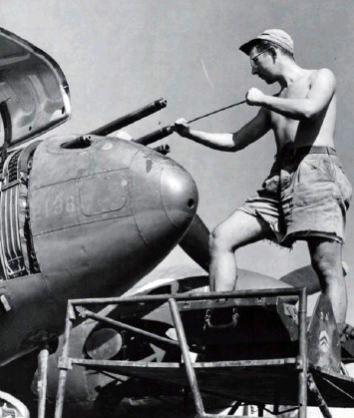
P-38J (s/n 42-67628), 459th FS, 80th FG, Nettoyage des mitrailleuses / Machine guns cleaning
© USAF (domaine public - public domain)
P-38K-LO
(1 seul exemplaire - 1 only unit)
Identique au P-38J mais avec une modification au niveau des hélices et un moteur V-1710-75/77.
Similar to the P-38J but with modified propellers and a V-1710-75/77 engine.
P-38L-LO/VN
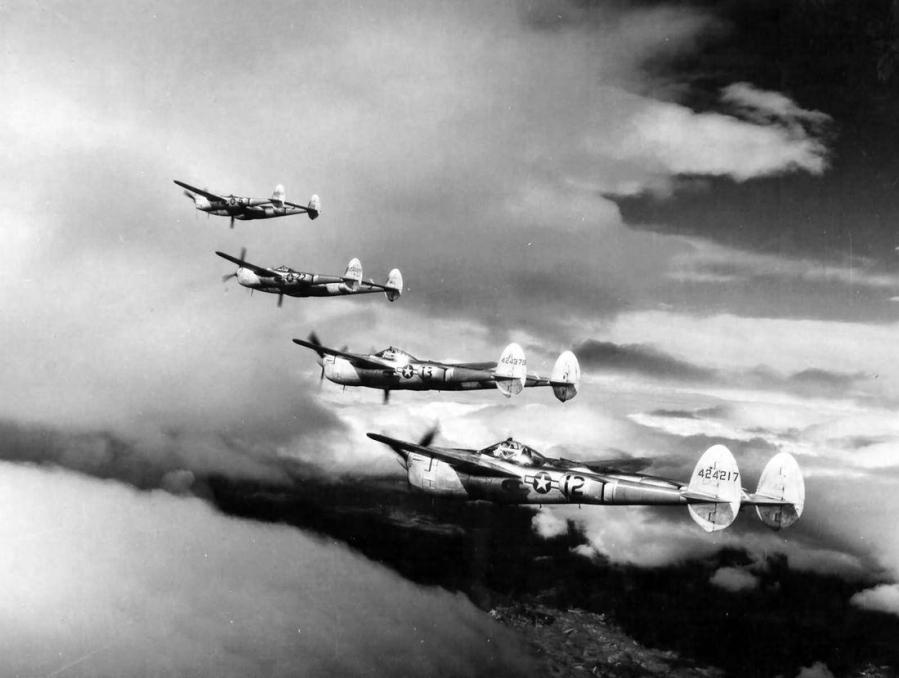
Lockheed P-38L & J Lightning - 27th FS, 1st FG,
Du plus près au plus loin - From nearest to farthest :
P-38L-1-LO (s/n 44-24217) - P-38L-1-LO (s/n 44-24379)
P-38J-15-LO (s/n 42-104428) - P-38J-15-LO (s/n 43-28650)
Photo UPL 24472 © IWM - www.americanairmuseum.com
3.810 exemplaires pour .
3,810 units for the LO version and 113 units L-VN built by Vultee
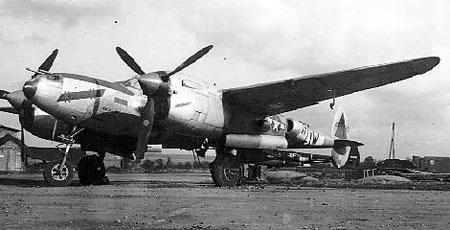
Lockheed P-38L , 370th FG, 401st FS
© USAF (domaine public - public domain) - source : National Museum of USAF - www.nationalmuseum.af.mil.

Lockheed P-38L-1-LO (s/n 44-23815), 24th FS, XXVI Fighter Command, Panama, 1945
© Thomas A. Tullis - TULLIS AVIATION ART Ltd - www.tullisart.com
Semblable au P-38J mais moteur V-1710-111/113. Phares d'atterrissage dans les ailes. Emplacements pour dix roquettes de
Similar to the P-38J but with a V-1710-111/113 engine. Landing lights in the wings. Sites for ten rockets of
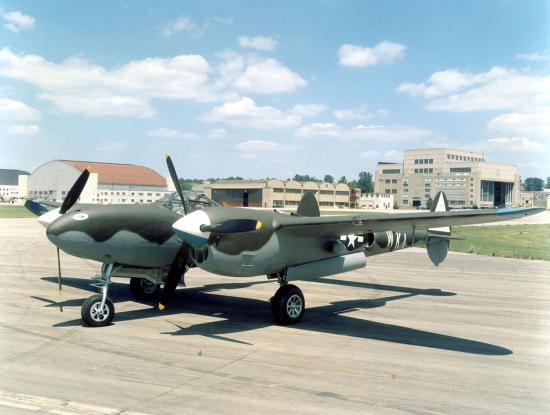
P38-L - Fabriqué par Vultee - Built by Vultee.
© USAF (domaine public - public domain)

Lockheed P-38L-1-LO, 94th FS, 1st FG, 2nd Lt Richard T. Sykes
Foggia, Italie, décembre 1944 - Italy, December, 1944.
© Srecko Bradic - www.sreckobradic.com
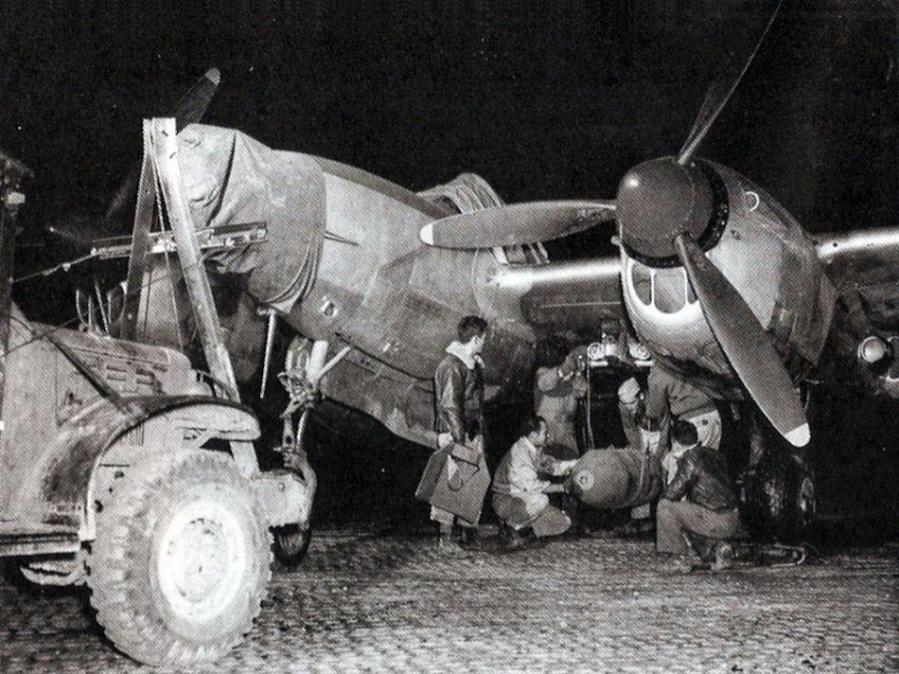
Lockheed P-38, 94th FS, 1st FG, Italie, chargement de bombe - Italy, bomb loading.
© USAF (domaine public - public domain)
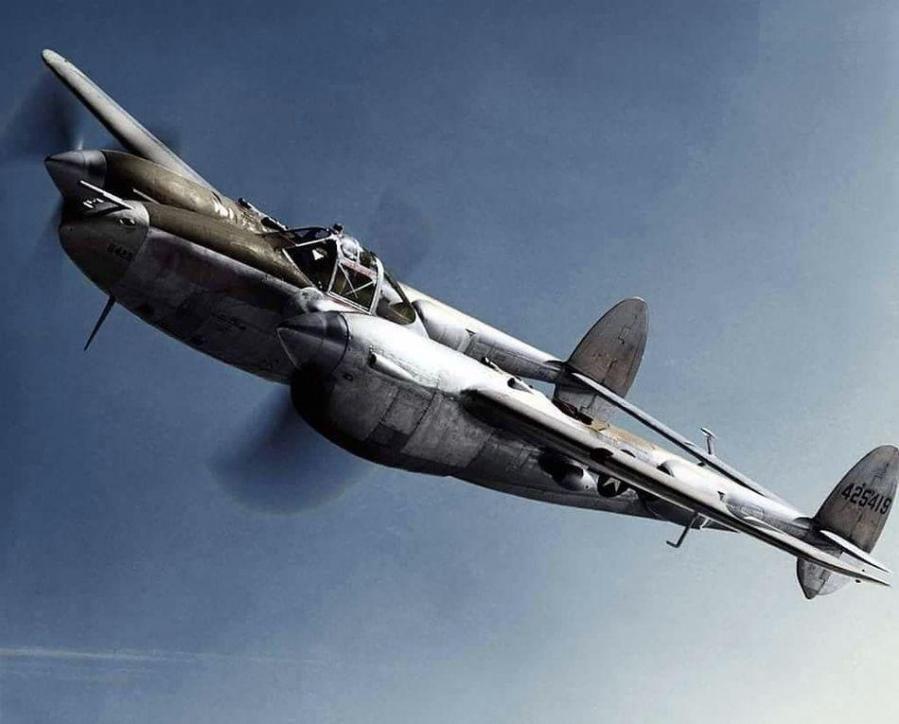
Lockheed P-38L-5 (s/n 44-25419) © USAF (domaine public - public domain)
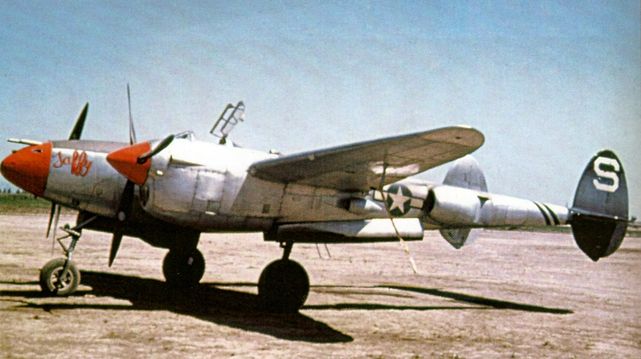
P-38L, 96th FS, 82nd FG, Lt Col. C.P. Hardy
© US National Archives (domaine public - public domain)
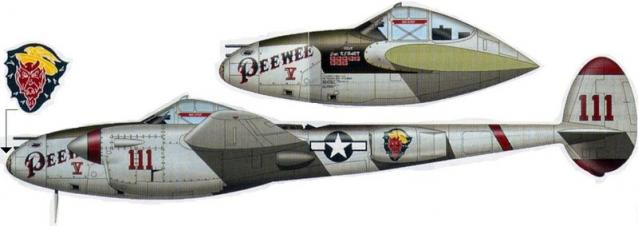
Lockheed P-38L-5, (44-25863) 431st FS, 457th FG, Captain Kenneth Hart
Lingayen, Philippines - juin 1945 - June, 1945 © P.A. Tilley
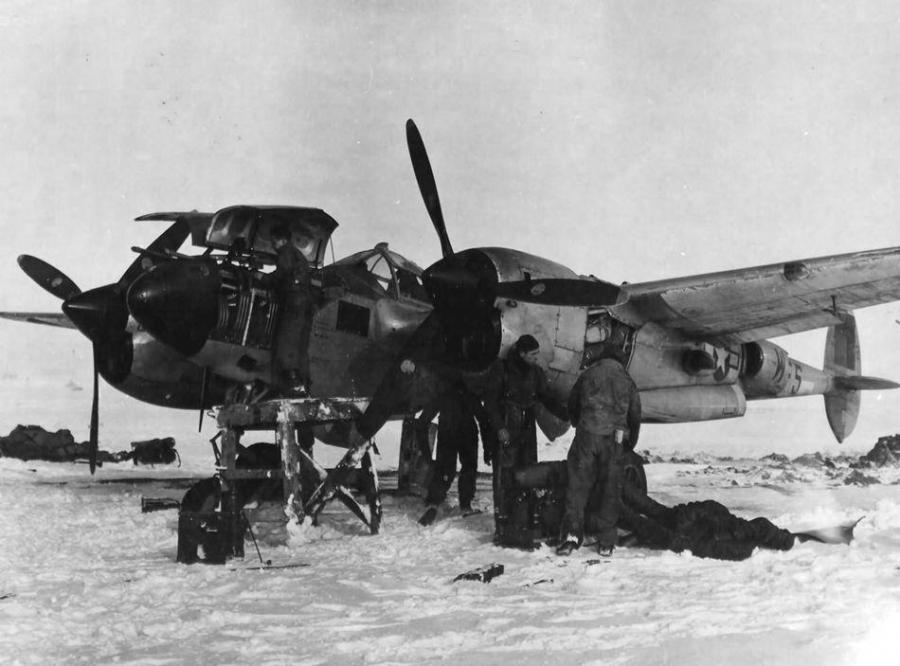
Lockheed P-38L - 428th FS, 474sh FG,
Florennes-Juzaine, Belgique, hiver 1944-1945 - Florennes-Juzaine, Belgium, winter 1944-1945
© USAF (domaine public - public domain)
P-38M-LO
(75 exemplaires - 75 units)
Conversion du P-38L en un chasseur nocturne biplace, avec radar monté dans une nacelle sous le nez. Peinture noire de rigueur.
Conversion of the P-38L into a two-seater night fighter, with radar assembled in a nacelle under the nose. Obligatory black painting.
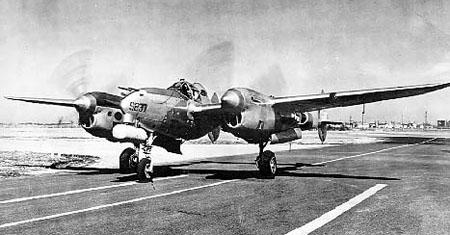
Lockheed P38-M - prototype
© USAF (domaine public - public domain) - source : National Museum of USAF - www.nationalmuseum.af.mil
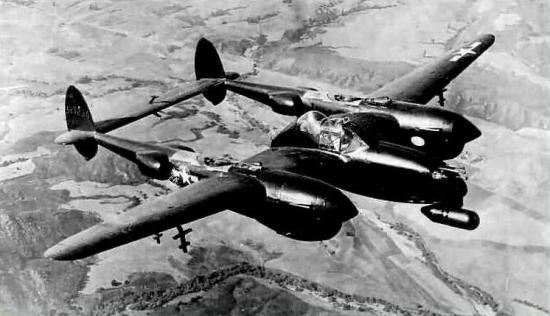
Lockheed Model 422 P38-M-6-LO (44-27234 - c/n 422-8238)
© USAF (domaine public - public domain) - source : National Museum of USAF - www.nationalmuseum.af.mil
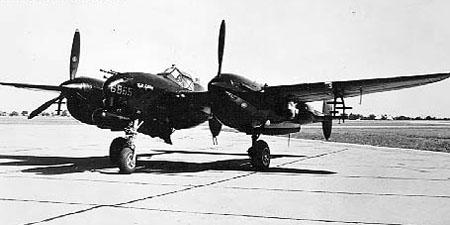
Lockheed P38 (s/n 44-26865) - P-38L-5-LO modifié - converted P-38-5-LO)
© USAF (domaine public - public domain) - source : National Museum of USAF - www.nationalmuseum.af.mil
P-38 "Droop Snoot"
Afin de pallier au manque de souplesse des formations classiques de bombardiers, deux officiers américains, les colonels Cass Hough et Don Ostrander, eurent l'idée de proposer un concept de bombardement par des groupes de "Lightnings bombardiers" guidés sur la cible par un P-38 "biplace" éclaireur, chargé d'effectuer la visée et d'ordonner le largage des bombes pour le groupe. Ce projet présentait l'avantage de la rapidité d'arrivée sur objectif (400 à 550 km/h contre 250-300 km/h pour des bombardiers classiques) et d'une meilleure capacité d'autodéfense après largage des bombes (sauf pour le P-38 éclaireur, qui lui, serait désarmé). Le projet fut accepté et les deux officiers furent chargés de le mener à bien (nom de code projet P.3819). Ils commencèrent par réaliser une maquette en bois pour tester l'aménagement intérieur pour un second homme.
In order to face the lack of flexibility of the classic boxes of bombers, two Americans officers, colonels Cass Hough and Don Ostrander, had the idea to propose a concept of bombardment by groups of "Lightnings bombers" guided on the target by a "two-seater" P-38 pathfinder, asked to make the sight and to order the dropping of bombs for the group. This project had the advantage of the speed of arrival on target (400 in 550 kph versus 250-300 kph with classic bombers) and of a better capacity of self-defence after dropping of bombs (except for the P-38 pathfinder which was disarmed). The project was accepted and both officers were in charge of it (code name P.3819 project). They began by making a wooden model to test the interior fittings for a second crew member.
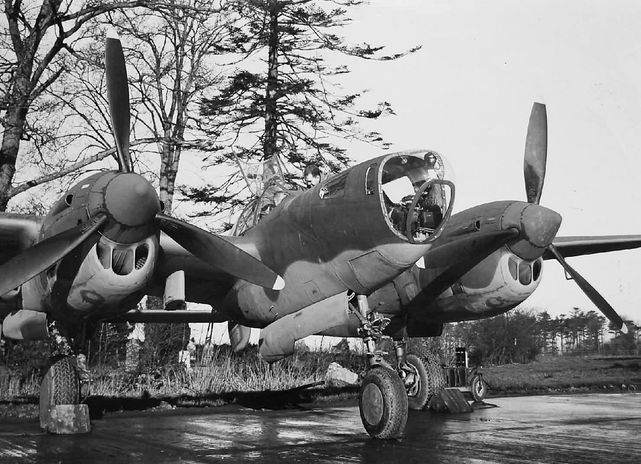
Lockheed P38 "Droop Snoot" - Langford Lodge
© USAF (domaine public - public domain)

Le P-38H-5-LO (s/n 42-67086) fut ainsi équipé d'un nez factice, d'où le surnom de "Droop Snoot" (Snoot = pif et to droop = baisser, laisser tomber). Les vols d'essai furent réussis et un vrai prototype fut réalisé sur la base du P-38J-10-LO s/n 42-68184. Le P-38 "Droop Snoot" fut donc équipé d'un nez vitré (en lieu et place de l'armement) accessible par une trappe sur le dessus et d'un viseur M-7 Norden. Le premier vol fut effectué en février 1944.
The P-38H-5-LO (s/n 42-67086) was then fitted with an artificial nose, where from the nickname of "Droop Snoot" (Snoot = nose and to droop = to fall, to drop). Test flights were successful and a real prototype was made on the basis of the P-38J-10-LO s/n 42-68184. The P-38 "Droop Snoot" was fitted with a glazed nose (instead of the armament) accessible by a trapdoor on the top and of a M-7 Norden sight. The first flight was made in February, 1944.
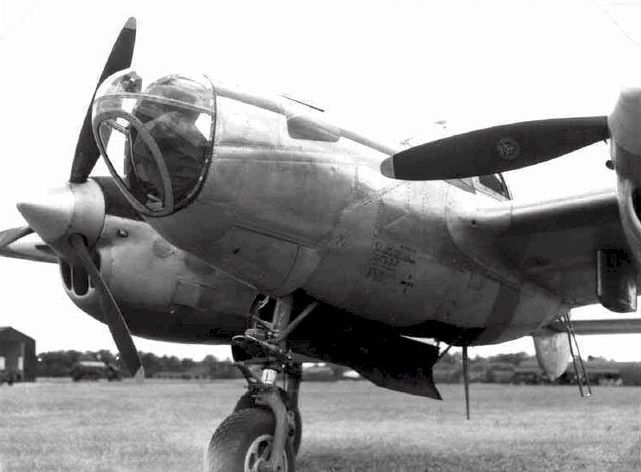
Lockheed P38 "Droop Snoot" © USAF (domaine public - public domain)
Le nombre exact de P-38 modifiés en "Droop Snoot" n'est pas certain : probablement entre 18 et 22. Les premiers "Droop Snoot" furent envoyés à la 8e Air Force. La première mission fut effectuée le 10 avril 1944 : 39 Lightning du 20th FG, dont 29 équipés de bombes, furent envoyés bombarder l'aérodrome de Florennes en Belgique. A cause de nuages masquant la cible, les P-38 firent demi-tour et larguèrent leur bombes dans la Manche.
The exact number of P-38 modified in "Droop Snoot" is not certain : probably between 18 and 22. The first "Droop Snoot" was sent in 8th Air Force. The first mission was made on April 10th, 1944 : 39 Lightning of the 20th FG, among whom 29 fitted with bombs, were sent to bomb the airfield of Florennes in Belgium. Because of clouds obscuring the target, P-38s turned back and dropped their bombs in the Channel.
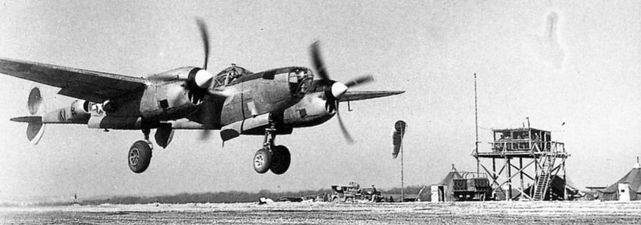
Lockheed P38 "Droop Snoot" (code K6-C) - 430th FS 474th FG, Luxembourg, 10 avril 1945 - 10th April, 1945
© USAF (domaine public - public domain)
L'après-midi, 28 P-38 du 20th FG furent envoyés bombarder l'aérodrome allemand de Gütersloh ; 27 avions réussirent la mission, le 28e, un P-38 du 55th FS, fut perdu. Le même jour, 51 P-38 du 55th FG, dont 34 bombardiers, furent envoyés pour bombarder St-Dizier. A cause de nuages, ils furent détournés sur Coulomiers où 28 bombes furent larguées sur la cible. 2 Lightning furent perdus lors de cette mission. Deux groupes de la 8e Air Force seulement (sur quatre initialement prévus) furent équipés de "Droop Snoot", les 20th et 55th FG.
The afternoon, 28 P-38s of the 20th FG were sent to bomb the German airfield of Gütersloh ; 27 aircrafts made the mission a success, the 28th, a P-38 of the 55th FS, was lost. The same day, 51 P-38s of the 55th FG, among which 34 bombers, were sent to bomb St-Dizier. Because of clouds, they were diverted to Coulomiers where 28 bombs were dropped on the target. 2 Lightnings were lost during this mission. Two groups of 8th Air Force only (out of four groups initially planned) were equipped with "Droop Snoot", the 20th and 55th FG.
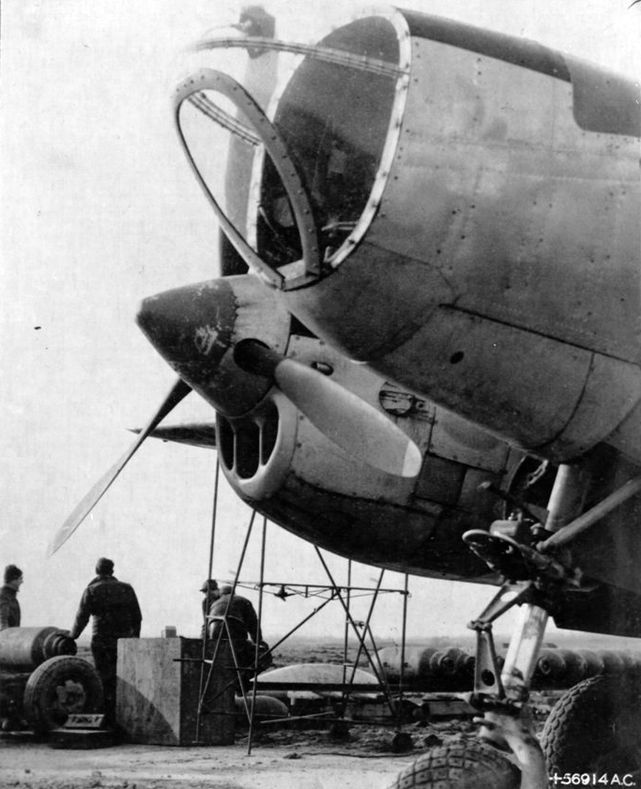
Lockheed P-38 "Droop Snoot", 428th FS, 747th FG (9th AF)
Belgique, 7 décembre 1944 - Belgium, 7th December, 1944
Photo UPL19777 © IWM - www.americanairmuseum.com
La 9e Air Force en fut également équipée : le 22 août 1944, des avions du 474th FG, 430th FS, attaquèrent un dépôt de carburant. Le lendemain surtout, des P-38 de ce même FG détruisirent ou endommagèrent 151 véhicules, touchèrent 2 ponts et coulèrent 2 barges. Un rapport de la 8e Air Force (rapport APO 634 du 11 mars 1945) révéla que l'efficacité et la souplesse du concept "Droop Snoot" n'était pas si évidente, par manque de souplesse réelle et par des capacités de bombardement plus faibles.
The 9th Air Force was also equipped : on August 22nd, 1944, aircrafts of the 474th FG, 430th FS, attacked a fuel depot. The next day above all, P-38s of the same FG destroyed or damaged 151 vehicles, hit 2 bridges and sunk 2 barges. A report of the 8th Air Force (report APO 634 dated March 11th, 1945) revealed that the efficiency and the flexibility of the concept "Droop Snoot" was not so obvious, due to the lack of real flexibility and by lower bombing capacities.
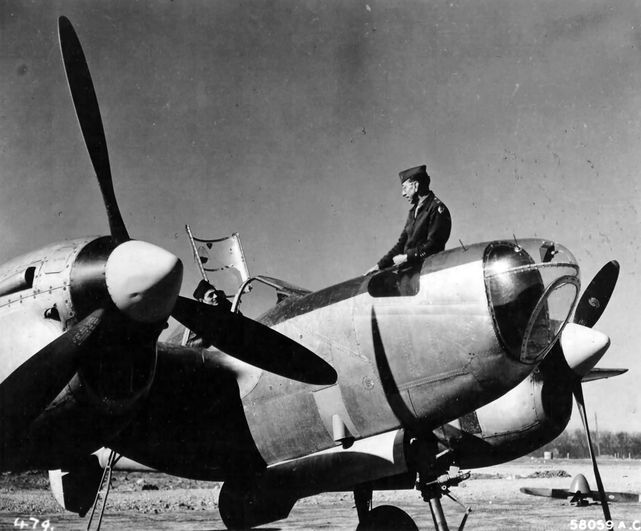
Lockheed P38 "Droop Snoot" - 430th FS ou/or 401st FS 370th FG
© USAF (domaine public - public domain)
La 15e Air Force fut également équipée (14th et 82th FG) et ses conclusions (rapport APO 520 de janvier 1945) furent plus positives, considérant les bombardements "Droop Snoot" comme complémentaires aux bombardement stratégiques. Mais les pilotes de la 15e Air Force n'appréciaient pas beaucoup le "Droop Snoot", jugé trop vulnérable face à la DCA (rapport APO 671 du 20 février 1945). Pour tromper les allemands sur cette vulnérabilité, de nombreux faux "Droop Snoot" furent fabriqués en polissant le nez pour simuler un vitrage.
The 15th Air Force was also equipped (14th and 82th FG) and its conclusions (report APO 520 dated January, 1945) were more positive, considering "Droop Snoot" bombings complementary to strategic bombings. But the pilots of 15th Air Forces did not appreciate the "Droop Snoot", considering it too vulnerable when facing the Flak (report APO 671 dated February 20th, 1945). To deceive Germans on this vulnerability, numerous false "Droop Snoot" were made by polishing the nose to imitate glazed nose.
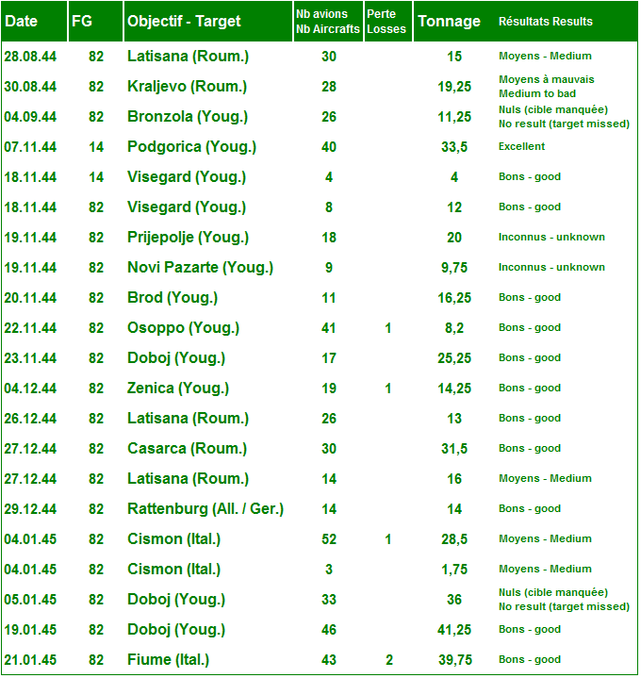
Résutats obtenus par les "Droop Snoot" de la 15th AIr Force
Results obtained by the "Droop Snoots" of the 15th Air Force
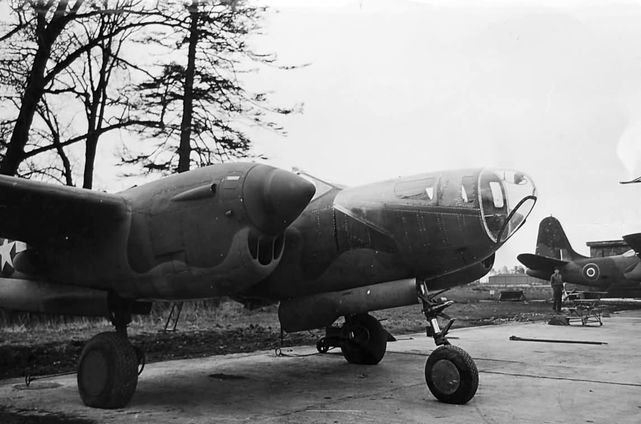
Lockheed P-38J "Droop Snoot" © USAF (domaine public - public domain)

En Asie également, des "Droop Snoot" furent modifiés : un premier avion fut envoyé à Barrackpore (Inde) le 15 février 1945. 10 P-38J-15 et -20-LO furent envoyés à Bangalore les 8 et 9 mars pour modification. Chaque unité de P-38 du théâtre d'opération Chine-Birmanie-Inde fut équipée de 2 "Droop Snoot". Le P-38 s/n 44-25606 fut utilisé comme avion de transport rapide par le général Geo Stratemeyer.
In Asia too, some "Droop Snoot" were modified : a first aircraft was sent to Barrackpore (India) on February 15th, 1945. 10 P-38J-15 and -20-LO were sent to Bangalore on March 8th and 9th for modification. Every P-38's unit of the theater of operation China-Burma-India was equipped with 2 "Droop Snoots". The P-38 s/n 44-25606 was used as fast transport aircraft by general Geo Stratemeyer.
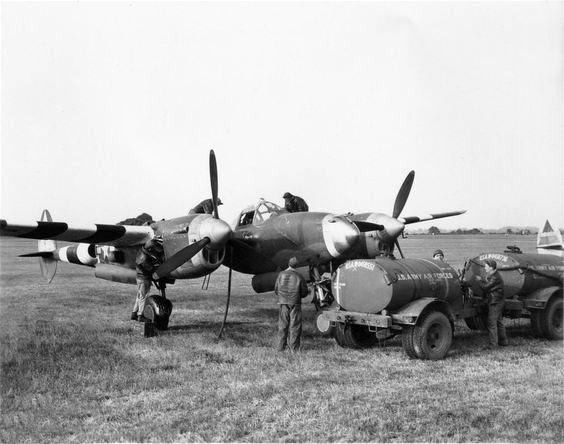
Lockheed P-38, 20th FG
Un faux "Droop Snoot" à nez poli, juin 1944 - A false "Droop Snoot" with polished nose, June 1944
© USAF (domaine public - public domain)
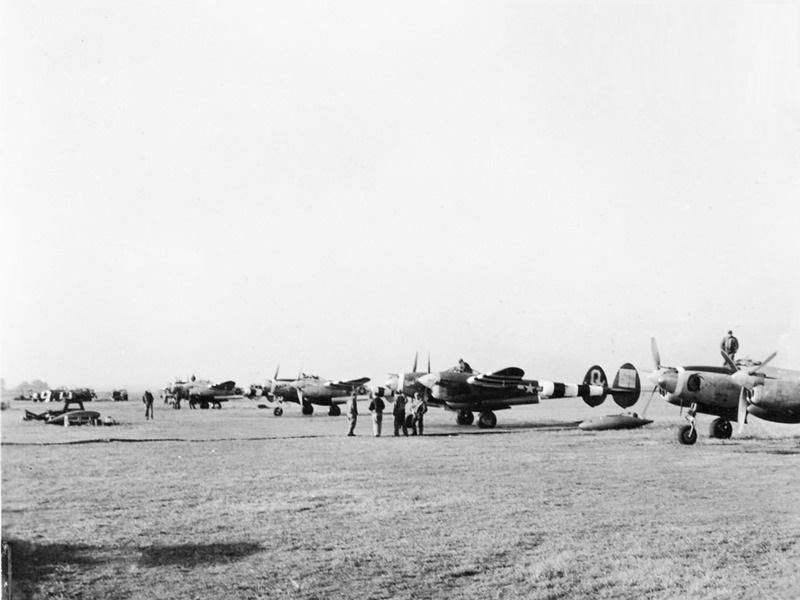
Lockheed P-38, 20th FG
Un groupe de faux "Droop Snoot" - A group of false "Droop Snoot"
© USAF (domaine public - public domain)
Les P-38L (radar) ont également été assimilés à des "Droop Snoot". Egalement biplaces, ils étaient équipés d'un radar H2X (AN/APS-15, surnommés "Mickey"). On sait que la 8e Air Force en reçut au moins 12. La 15e Air Force en fut également dotée. Après plusieurs mois d'essais, le projet fut abandonné : le balayage n'était pas suffisant (235° au lieu de 360°) et la maintenance pas facilitée par les accès exigus au radar.
The P-38Ls (radar) were also likened to "Droop Snoot". Also two-seaters, they were fitted with a radar H2X (AN/APS-15, nicknamed "Mickey"). It is said thatthe 8th Air Force received at least 12 units. The 15th Air Force was also equipped. After several months of tests, the project was ended : the sweep was not sufficient (235° instead of 360°) and the maintenance not easy due to the narrow accesses to the radar.
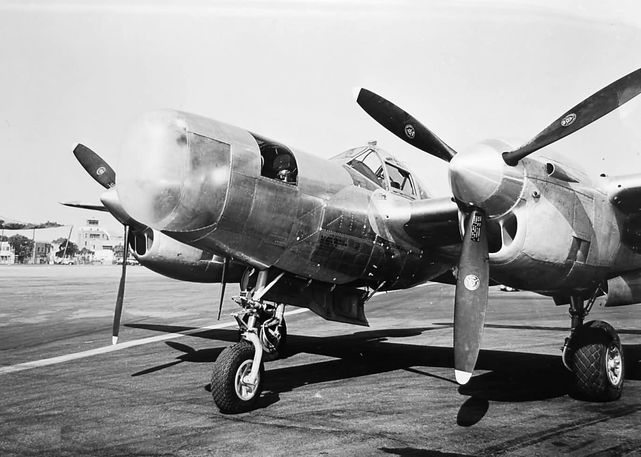
Lockheed P-38J-15-LO "Droop Snoot" (s/n 44-23139)
© Lockheed

Lockheed XF-5D (s/n 42-12975)
Prototype d'un avion de reconnaissance cousin du "Droop Snoot"
Prototype of a reconnaissance aircraft, cousin of the "Droop Snoot".
© Lockheed
Versions de reconnaissance - Reconnaissance variants
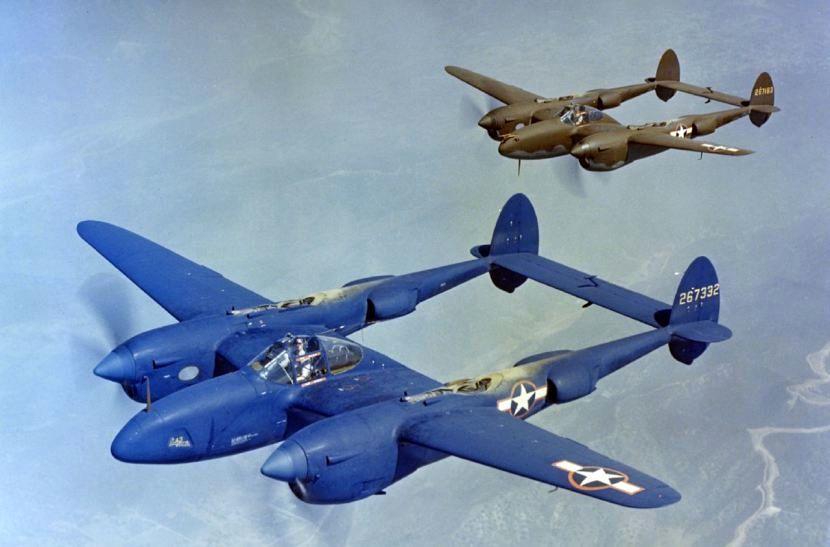
Lockheed P-38J-5-LO (s/n 42-67183) & Lockheed F-5B-1-LO Lightning, octobre 1943 - October 1943
© Lockheed
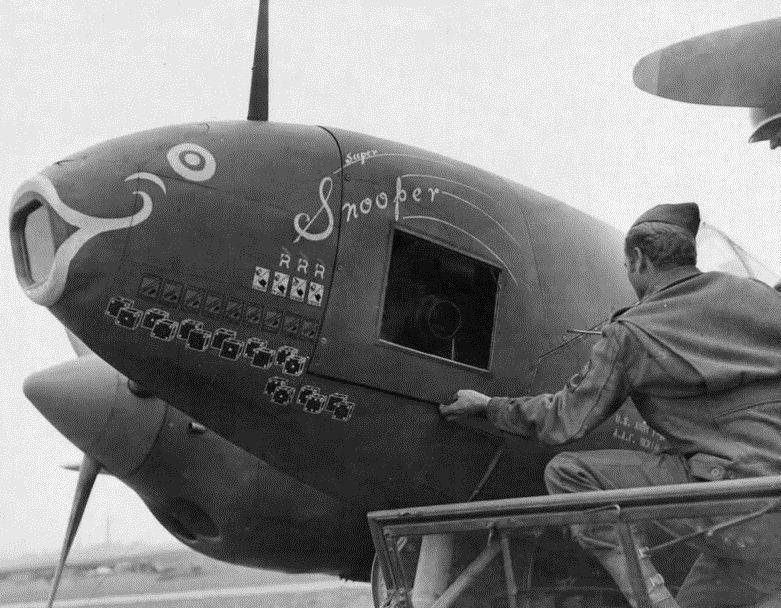
Lockheed F-5 Lightning “Super Snooper” - Eschwege, Allemagne, 14 avril 1945 - Eschwege, Germany, 14th April, 1945
© USAF (domaine public - public domain)
F-4-1-LO
s/n 41-2098, 41-2099, 41-2121 > 41-2156, 41-2158 > 41-2171, 41-2173 > 41-2218, 41-2220
(99 exemplaires – 99 units)
Version photo du P-38E. Pilotage automatique et 4 appareils photos K-17 en lieu et place des mitrailleuses et canon.
Reco. version of a P-38E. Automatic pilot and 4 K-17 cameras instead of machine guns and guns.
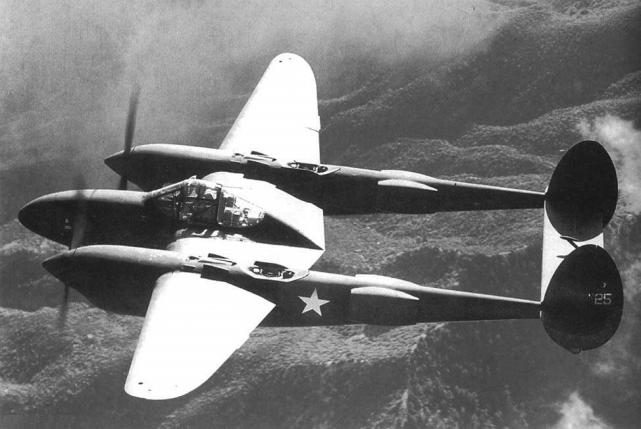
P-38 F-4-1-LO - Nouvelle Guinée - New Guinea, 1942
© USAF (domaine public - public domain)
F-4A-1-LO
(20 exemplaires –20 units)
s/n 41-2362 > 41-2381
Identique au F-4-I-LO, mais basé sur le P-

Lockheed Lightning F-4A-1-LO, GR 2/33 (3rd PRG)
© Jean-Jacques PETIT
F-5A-1-LO
(20 exemplaires – 20 units)
Version photo du P-38G. Reco. version of a P-38G.
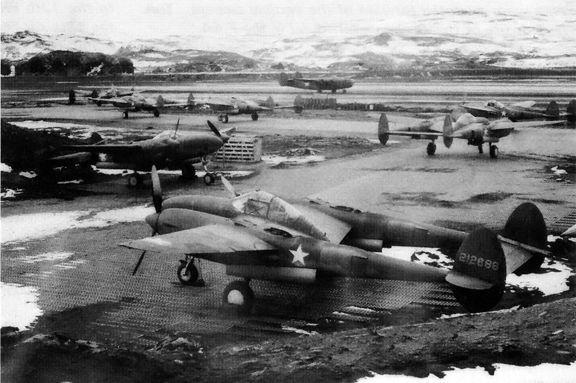
Lockheed P-38G & F-5A-1-LO (42-12686), 54th FS - Photo : auteur inconnu - author unknown
F-5A-10-LO
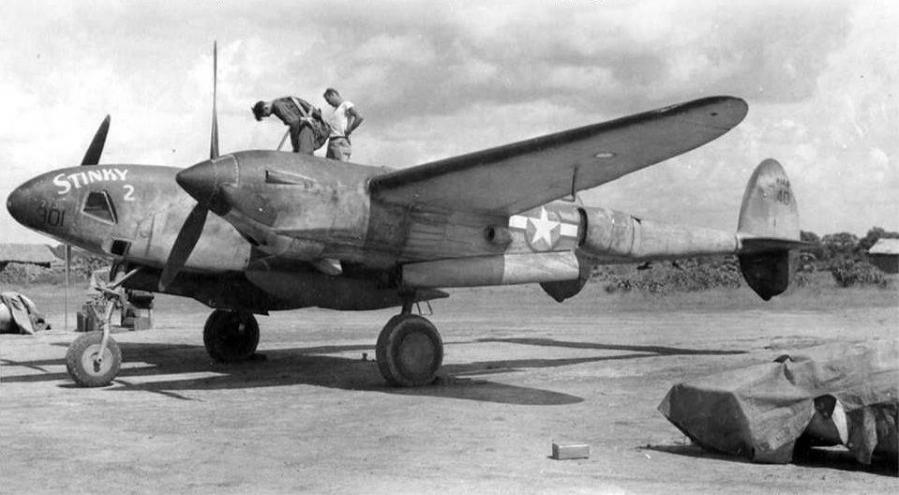
P-38 F-5A-LO - 42-13301 "Stinky 2" 9th PRS, 7th BG, Pandaveswar, Inde/India, 1943
© USAF (domaine public - public domain)
(140 exemplaires – 140 units)
Autre version photo du P-38G. Other reco. version of a P-38G.

F-5A-10-LO - 7th PRG, USAAF - s/n 42-13312
© Malcom Laird (source : Ventura Publications - http://www.thescale.info/news/publish/index.shtml)
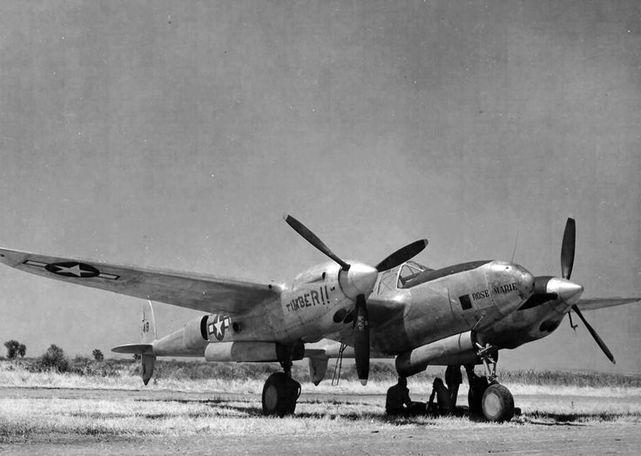
F-5A "Rose Marie Timber" - 90th Photo Reconnaissance Wing
© US National Archives (domaine public - public domain)
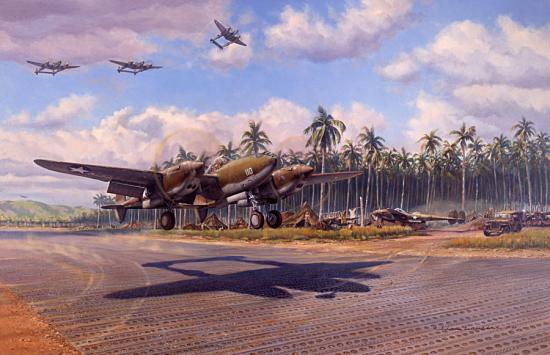
© Jim Laurier - www.jimlaurier.com - JIM LAURIER dans la galerie d'art - in the art gallery
En savoir plus sur Jim Laurier : cliquez ici - To know more about Jim Laurier click here
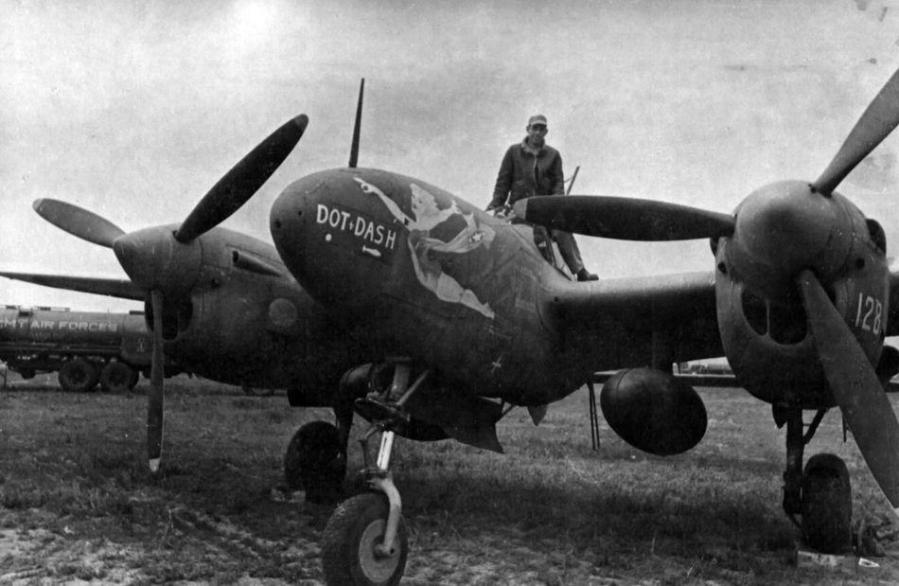
Lockheed F-5 Lightning “DOT °+ DASH", 7th PRG - Eurk, Union Soviétique, 1944 - Eurk, Soviet Union, 1944
© USAF (domaine public - public domain)
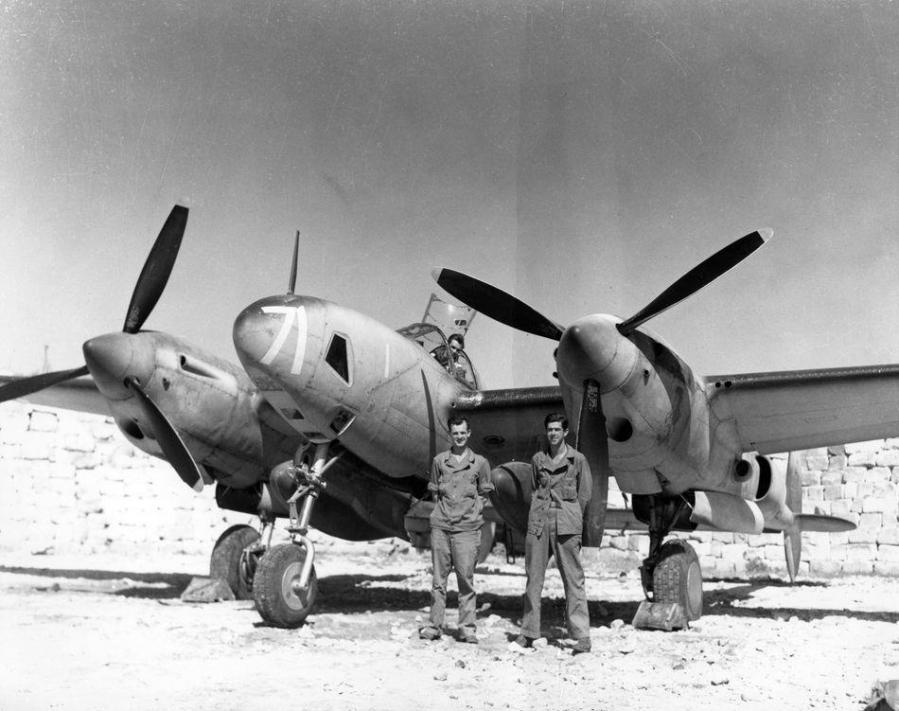
Lockheed F-5A Lightning (s/n 42-13071), 12th PRS, 3rd PRG, 90th Reconnaissance Wing, Afrique du Nord, North Africa
Photo FRE10099 © IWM - www.americanairmuseum.com
F-5A-2-LO
(1 exemplaire – 1 unit)
P-38E n°41-2157 transformé en version photo. P-38E n°41-2157 transformed in reco. photo.
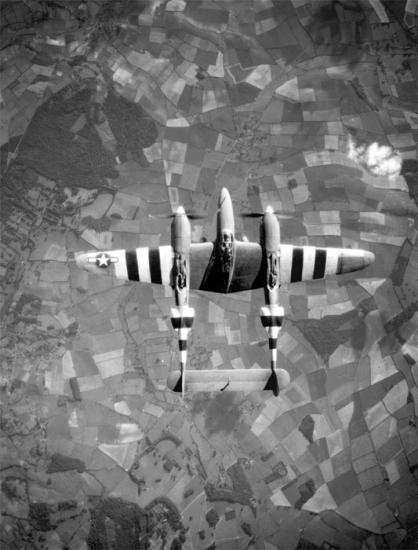
P-38 F-5 au dessus de la campagne anglaise, fin mai, début juin 1944.
P-38 F-5 over the englsih country, late May, early June 1944.
© USAF (domaine public - public domain)

F-5A - 34th Photo. Recon. Group
© F3V Factory http://profilavions.canalblog.com

F-5A - utilisé parfois par Antoine de St Exupéry.
F-5A - used sometimes by Antoine de St Exupéry.
© F3V Factory http://profilavions.canalblog.com
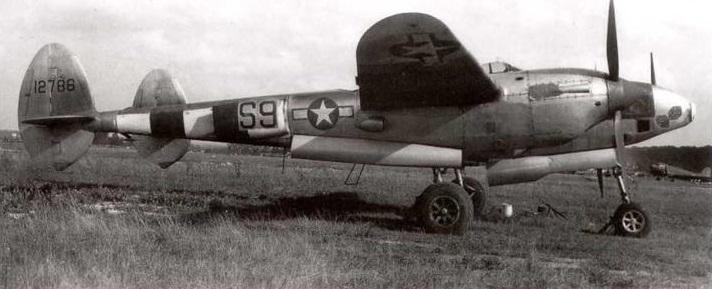
F-5A-3-LO "Dicer" (s/n 42-12786,) 34th PRS, 10th PG
Photo : auteur inconnu - author unknown
F-5B
(200 exemplaires – 200 units)
P-38-J-10-LO transformé en version photo. C'est à bord d'un F-5B-1-LO qu'a disparu Antoine de Saint-Exupéry en 1944.
P-38-J-10-LO transformed in reco. version. It’s in such a F-5B-1-LO that Antoine de Saint Exupéry disappeared in 1944.

Lockheed F-5B-1 (42-68229) - 34th Photo. Recon. Squadron
Chalgrove (Angleterre - England) - Juin 1944 - June 1944
© Pierre André Tilley
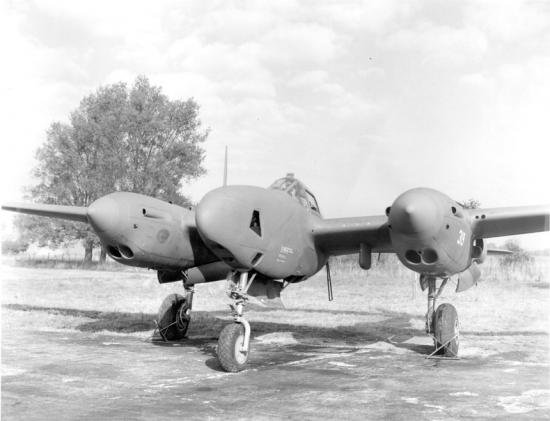
Le F-5B et ses appareils photos dans le nez. The F-5B and its cameras in the nose.
© USAF (domaine public - public domain)

Lockheed F-5B Lightning - 33 Photo Recon. Squadron / 8AF
© F3V Factory http://profilavions.canalblog.com

Lockheed F-5B-1-LO Lightning 44-68223 - GR 2/33
Antoine de St-Exupery a disparu avec cet appareil le 31 juillet 1944 au large de Marseille
Antoine de St-Exupery was killed in action with this aircraft on 31st July, 1944 off Marseille
© Patrice Gaubert http://gaubs.free.fr
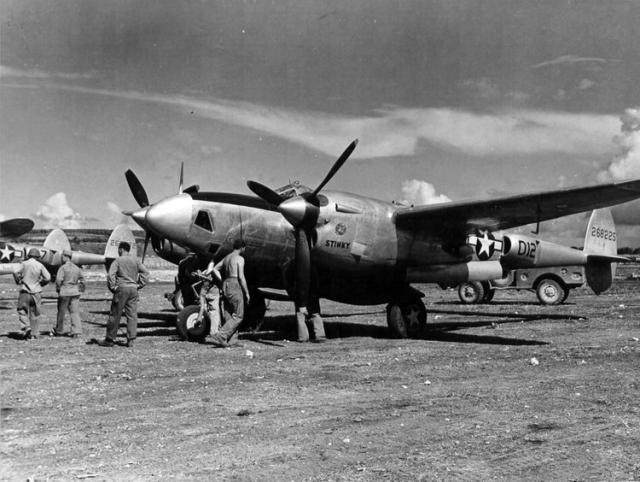
Lockheed Lightning F-5B-1-LO - s/n 42-68225
28th Photo Recon Squadron, Isley Field, Saipan,Marianas Islands, 10 juillet - July 10,1944.
© US NARA ref 342-FH-3A38550-A63727AC (domaine public - public domain)
XFO-1
Cinq F-5B-LO sont assignés à l'US Navy en Afrique du Nord.
Five F-5B-LO are sent to the US Navy in Northern Africa.
F-5C
(123 exemplaires – 123 units)
P-38H transformé en version photo. P-38H transformed in reco. version.
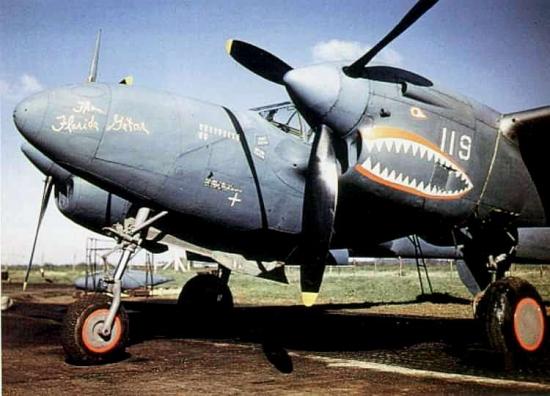
F-5C serial 42-67119 "The Florida Gator".
Appareil perdu le 24 juillet 1944 - pilote Lt. Edward W. Durst tué.
Aircraft lost on the 24th July, 1944 - pilot Lt Edward W. Durst killed.
With courtesy of http://www.littlefriends.co.uk
XF-5D
(1 exemplaire – 1 unit)
Basé sur le F-5A-10-LO, nez en plexiglas et poste d'observation. Appareil photo vertical et deux mitrailleuses calibre 12,7 mm.
Based on the F-5A-10-LO, nose made of plexiglass and observation post. Vertical camera and two 12.7 mm machine-guns.
F-5E
Version photo du P-38J. Reco. version of a P-38J.
F-5E-2-LO
(100 exemplaires – 100 units)
Version photo du P-38J-15-LO. Reco. version of a P-38J-15-LO.
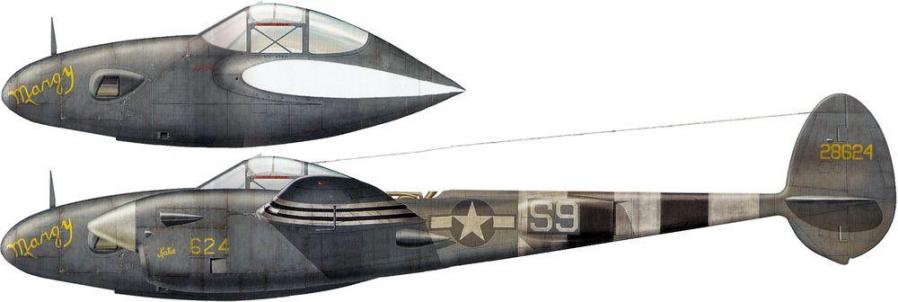
Lightning F-5E-2-LO, 42-8624 "Margy", Captain Bosworth, 34th PRS, France, été/Summer 1944
© Vincent Dhorne
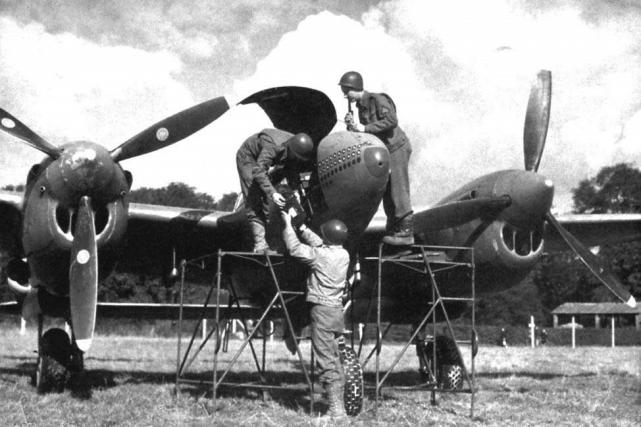
Lightning F-5E-2-LO, 9th Air Force
4 octobre 1944, chargement de pellicule. 4th October, 1944, films are loaded.
© USAF (domaine public - public domain)
F-5E-3-LO
(105 exemplaires – 105 units)
Version photo du P-38J-25-LO. Reco. version of a P-38J-25-LO.
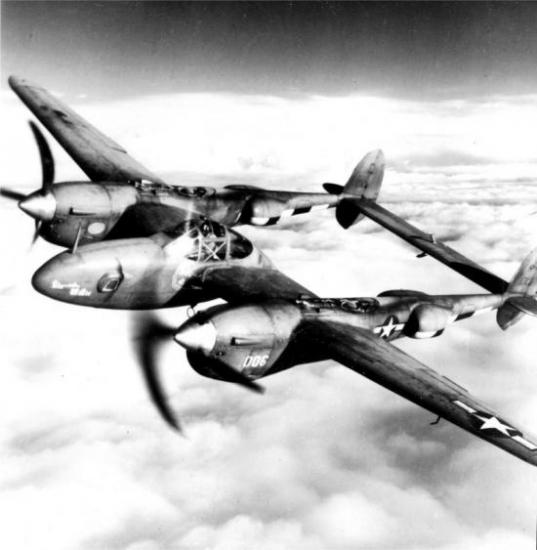
F-5E serial 43-29006 - Maj. Troy B. Mc Guire - C.O. 22 Photo Reconnaissance Squadron.
© Lt. Ellis B "Bruce" Edwards via Peggy Edwards - With courtesy of http://www.littlefriends.co.uk
F-5E-4-LO
(500 exemplaires - 500 units).
Version photo du P-38L-1-LO. Reco. version of a P-38L-1-LO.

F-5E serial 44-24225 - 22 Photo Reconnaissance Squadron.
© Nick King - With courtesy of http://www.littlefriends.co.uk.
F-5F-3-LO
Version photo du P-38L-5-LO. Reco. version of a P-38L-5-LO

Lockheed Lightning F-5F © Jean-Jacques PETIT
F-5G-6-LO
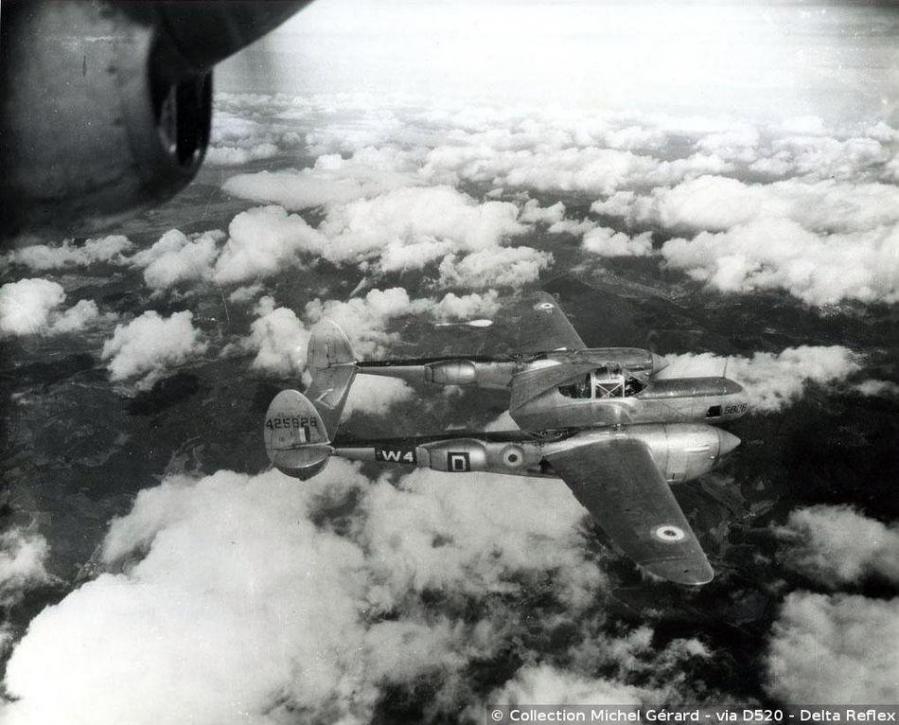
P-38 F-5G (s/n 44-25828), GR 1/33 Belfort, France 1945
© Collection Michel Gérard via Base de données Delta Reflex
Quasi identique au F-5F-3-LO, mais avec des appareils photos différents.
Almost similar to the F-5F-3-LO, but with different cameras.
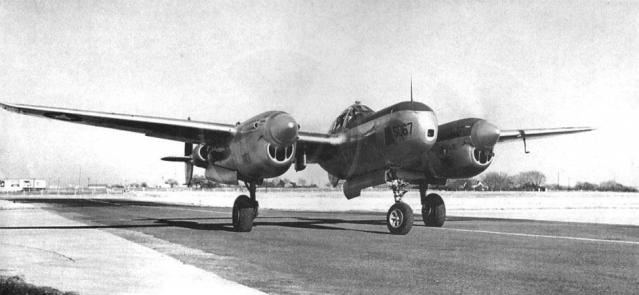
P-38 F-5G-6-LO - © USAF (domaine public - public domain)

F-5G - GR 2/33 - Fribourg 1945.
© F3V Factory http://profilavions.canalblog.com
Modèle 322 - 322 model
(243 exemplaires - 243 units).
Lightning construits pour la RAF, mais seuls trois ont été effectivement livrés. Tous les autres ont été récupérés par l'USAAF et utilisés pour l'entraînement des pilotes.
Lightnings manufactured for the RAF, but only three units were delivered. All others have been used by the USAAF for pilots training.
Modèles expérimentaux - Experimental models
"Super Lightning"
Pour répondre à la Circular Proposal 39-775, du 11 mars 1939, pour un intercepteur bimoteur à haute performance, Clarence L. “Kelly” Johnson proposa un projet d'évolution du P-38, intégrant notamment un habitacle pressurisé. Ce projet, baptisé Model 222 puis 522, proposait 2 moteurs Pratt & Whitney XH-2600 de 2200 ch avec turbocompresseur (moteur encore en développement).
In order to answer the Circular Proposal 39-775, of March 11th, 1939, for a high-performance twin-engined interceptor, Clarence L. "Kelly Johnson" proposed an evolution of P-38, integrating a pressurized cabin. This project, named Model 222 then 522, proposed 2 engines Pratt & Whitney XH-2600 of 2200 hp with turbo-compressor (engine still under development).
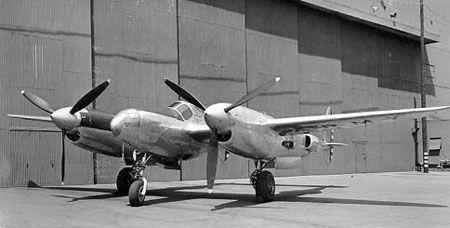
Lockheed XP-49
© US government (domaine public - public domain)
Kelly envisagea aussi le Wright R-2160 de 2300 ch pour la version de série. L'avion pourrait atteindre ainsi 800 km/h à 6 000 m. Le prototype XP-49 (s/n 40-3055) fut lancé en octobre 1939, mais suspendu en 1940 avec le déclenchement de la guerre en Europe. Carl Haddon, ingenieur projet chez Lockheed, relance le projet le 23 décembre 1940 mais avec un moteur moins puissant, le Continental XIV-1430, qui permet 737 km/h à 7600 m.
elly also thought about Wright R-2160 of 2300 hp for the series versions. The aircaft could reach 500 mph at 20 000 ft. The prototype XP-49 (s/n 40-3055) was launched in October, 1939, but suspended in 1940 with the war in Europe. Carl Haddon, project engineer at Lockheed, started the project again on December 23rd, 1940 but with another engine, the Continental XIV-1430, which allowed 460 mph at 25 000 ft.
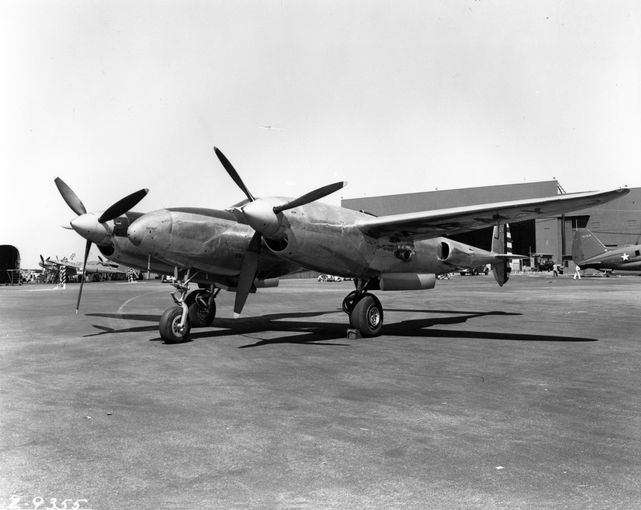
Lockheed XP-49 (s/n 40-3055), Burbank, novembre/November 1942
© US government (domaine public - public domain)
Le premier vol est effectué le 14 novembre 1942, mais le XP-49 ne dépasse pas 654 km/h. Malgré plusieurs tentatives, le projet est progressivement abandonné, le XP-49 ne se montrant pas meilleur que le P-38 J.
The maidden flight was done on November 14th, 1942, but the XP-49 did not exceed 406 mph. Despite of several attempts, the project was gradually given up ; the XP-49 was'nt better than the P-38 J.
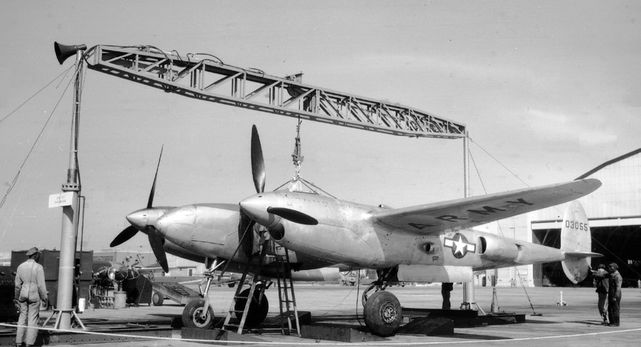
Lockheed XP-49 (s/n 40-3055)
© Bill Larkins (domaine public - public domain)
Par ailleurs, dès le 12 avril 1940, Lockheed développe un autre modèle, le Model L-121 qui devient le XP-58 ; confié à James Gerschler, adjoint de Johnson, le XP-58 était équipé du moteur Continental IV-1430 en version monoplace ou biplace, la version biplace prévoyant initialement des tourelles automatiques dans chaque poutre.
Meanwhile, from April 12th, 1940, Lockheed developped another model, the Model L-121 which became XP-58 ; managed by to James Gerschler, Johnson's right hand, the XP-58 was fitted with the engine Continental IV-1430 in single or two-seater version ; the two-seater was designed with automatic turrets in each boom.
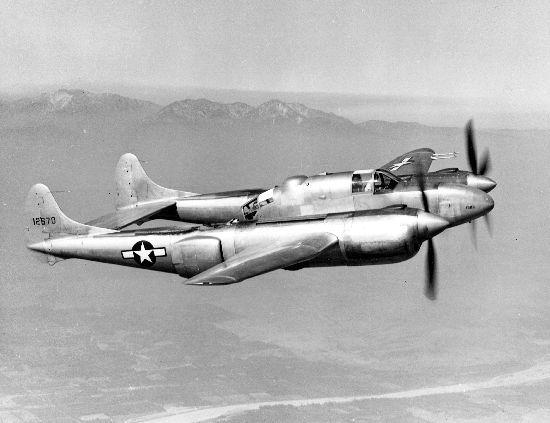
YP-58 - © USAF (domaine public - public domain)
La version monoplace sera abandonnée et les moteurs remplacés par le Pratt & Whitney XH-2600-9/11. Le prototype du XP-58 recevra le s/n 41-2670 (en interne Model 20-14).
The single version was rapidly abandoned and engines replaced by Pratt and Whitney XH-2600-9. The XP-58 prototype received the s/n 41-2670 (internal Model 20-14).
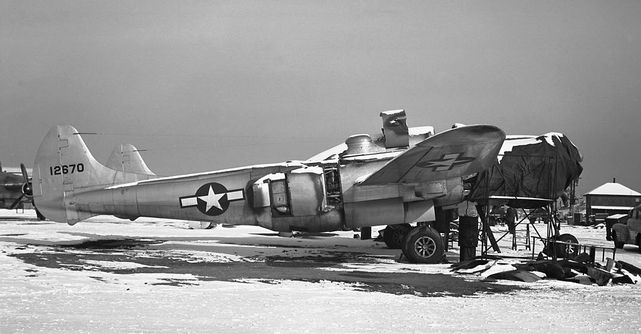
YP-58 (s/n 41-2670) - © USAF (domaine public - public domain)
Finalement, après diverses évolutions des exigences de la Material Division, le XP-58 vole pour la première fois le 6 juin 1944, avec deux moteurs Allison V-3420-11/13 de 2600 ch à Muroc, Californie, avant d'être transféré à Wright Field en octobre 1944. Le programme sera progressivement abandonné.
Finally, after various requirements evolutions of the Material Division, the XP-58 made its maiddent flight on June 6th, 1944, with two engines Allison V-3420-11/13 V-3420-11/13 of 2600 hp at Muroc, California, before being transferred at Wright Field in October, 1944. The program was gradually given up.
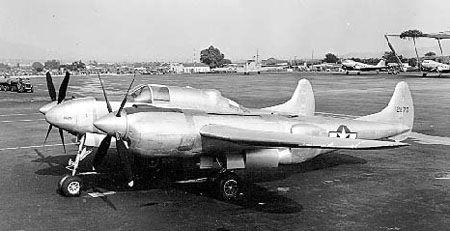
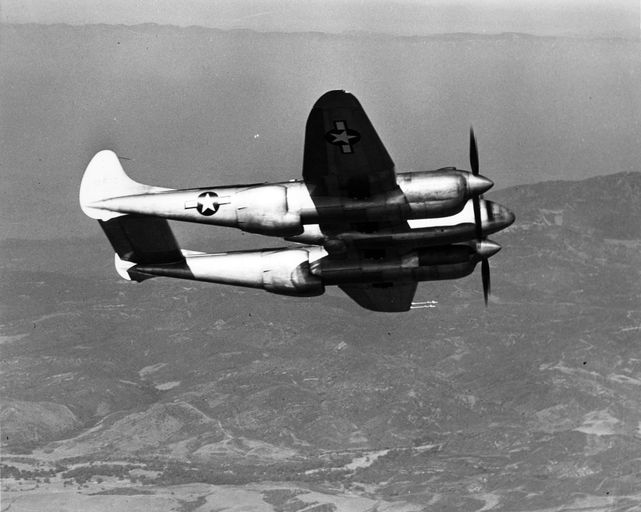
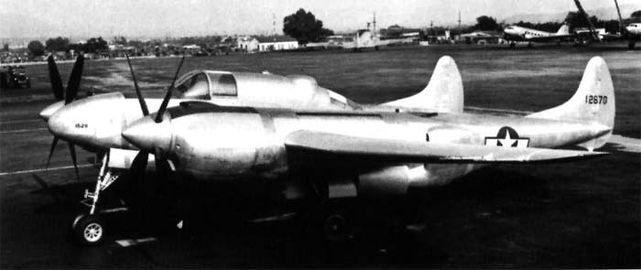
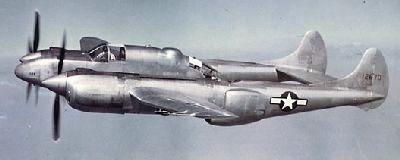

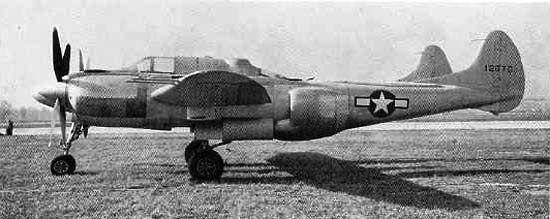
YP-58 (s/n 41-2670) - © USAF (domaine public - public domain)
P-38 avec skis - P-38 with skis
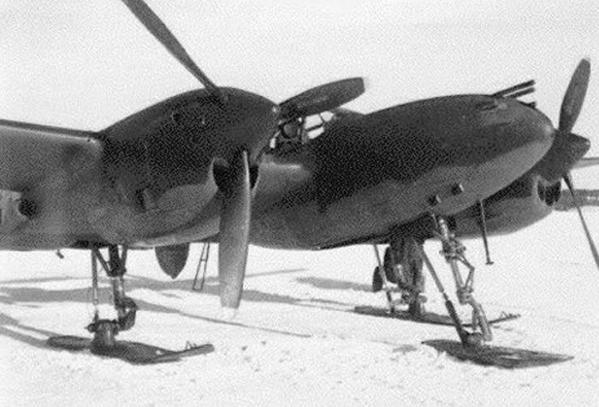
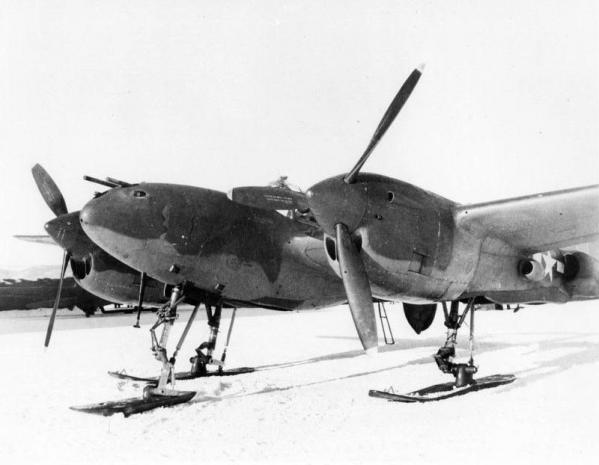
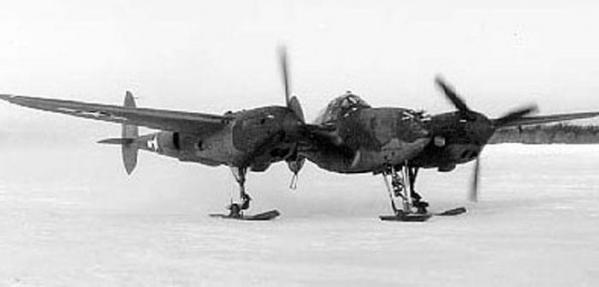
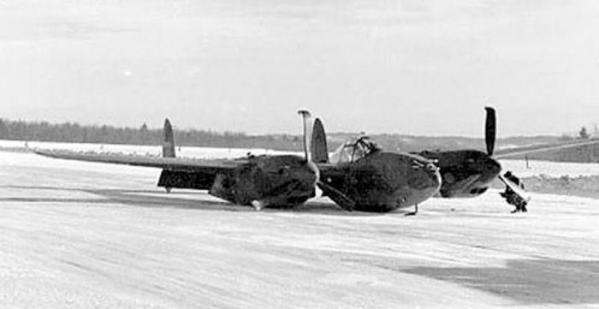
P-38G (s/n 42-13444)
avec des skis retractable (avant et après un accident) - on retractable skis (before and after gear collapsed).
© USAF (domaine public - public domain) - source : National Museum of USAF - www.nationalmuseum.af.mil.
P-38 hydravion - P-38 floatplane
Ce projet ne P-38 hydravion ne dépassa pas le stade du dessin.
This project P-38 seaplane did not go beyond the drawing stage
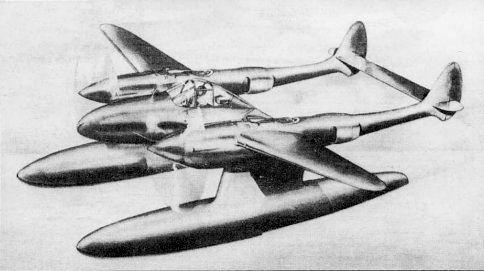
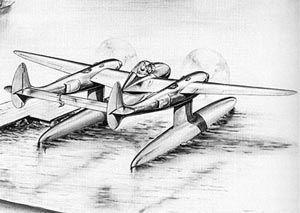
P-38 hydravion - floatplane © USAF (domaine public - public domain)
P-38 tracteur de planeur - P-38 towing glider

P-38 tractant un planeur WACO CG4-A - towing a WACO CG4-A glider
© USAF (domaine public - public domain)
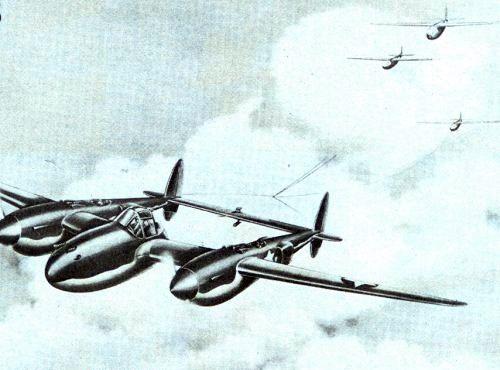
P-38 tractant des planeurs - towing gliders
Dessin source inconnue - Drawing unknown source
P-38 double cockpit - P-38 twin cockpit
Un modèle de P-38L_LO (le s/n 40-744) fut transformé pour des tests en modèles à double cockpit.
A model of P-38L-LO (s/n 40-744) was transformed for tests in a twin cockpit version.
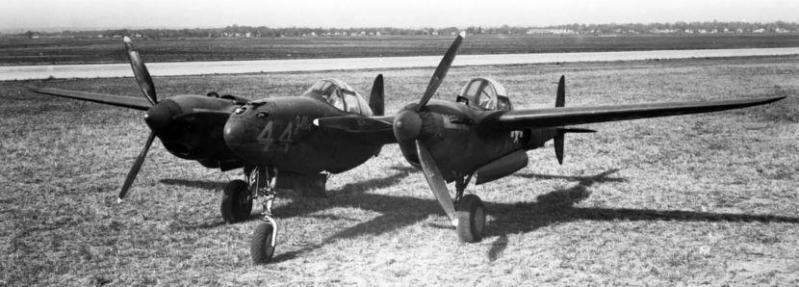
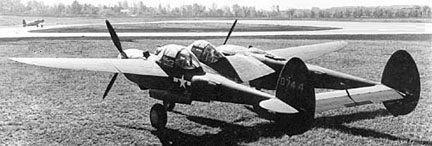
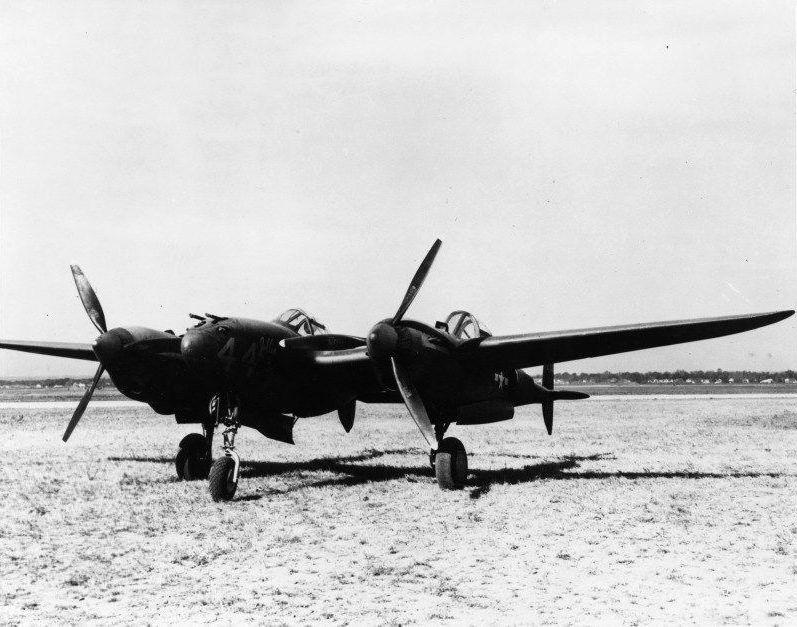
P38-L-LO 40-744 © USAF (domaine public - public domain)
P-38 ambulance et transport d'hommes - P-38 ambualnce and man transport
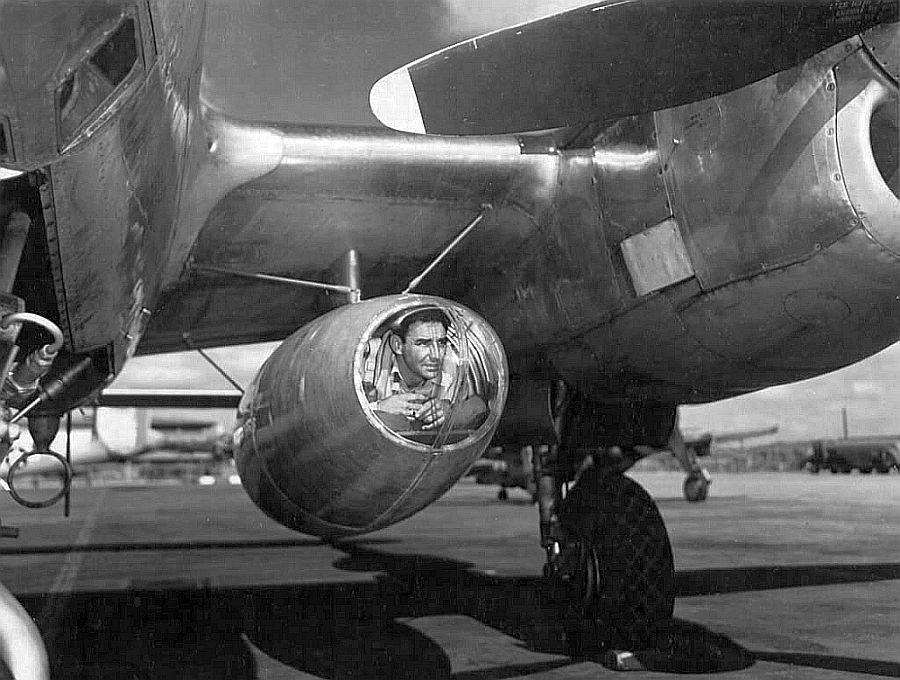
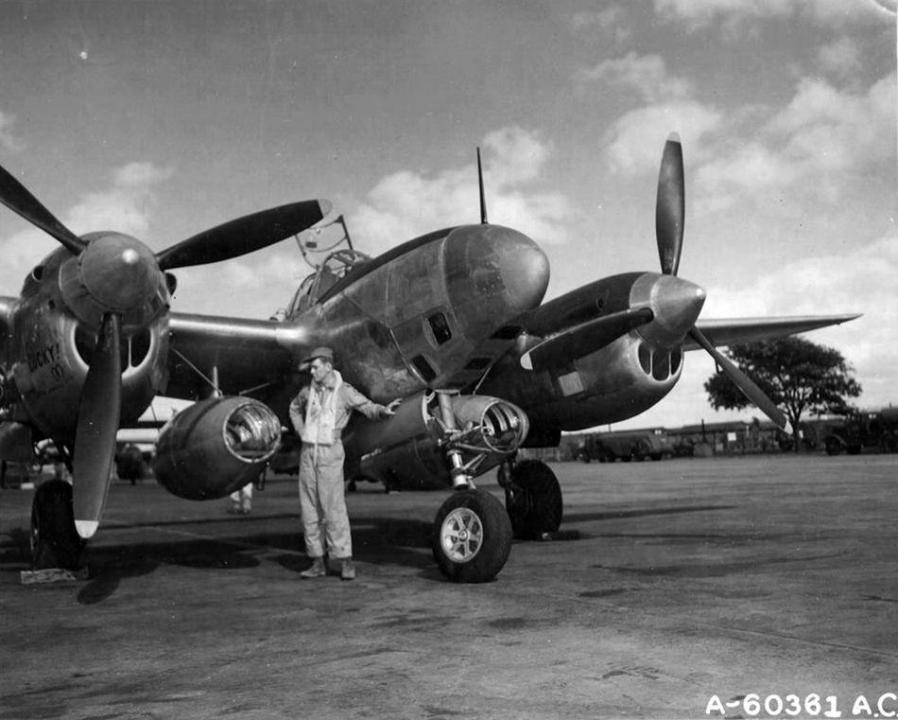
Lockheed F-5B (ou/or A ?) modifié pour le transport d'hommes - Modified for people airlifting.
© USAF (domaine public - public domain) NARA 342-FH-3A38179-A60361AC
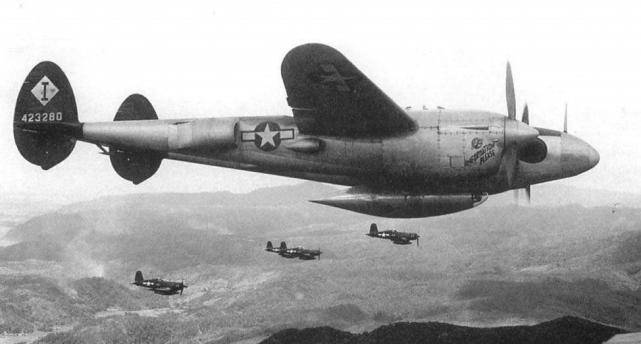
P-38 F-5F-3-LO (44-23280) "Information Please" - 28th PRS, Kushi-Take (Okinawa)
Juin 1945. Dans la nacelle sous l'aile, le lieutenant Duncan, photographe.
June 1945 - In the nacelle under the wing, lieutenant Duncan, photographer
© USAF (domaine public - public domain)
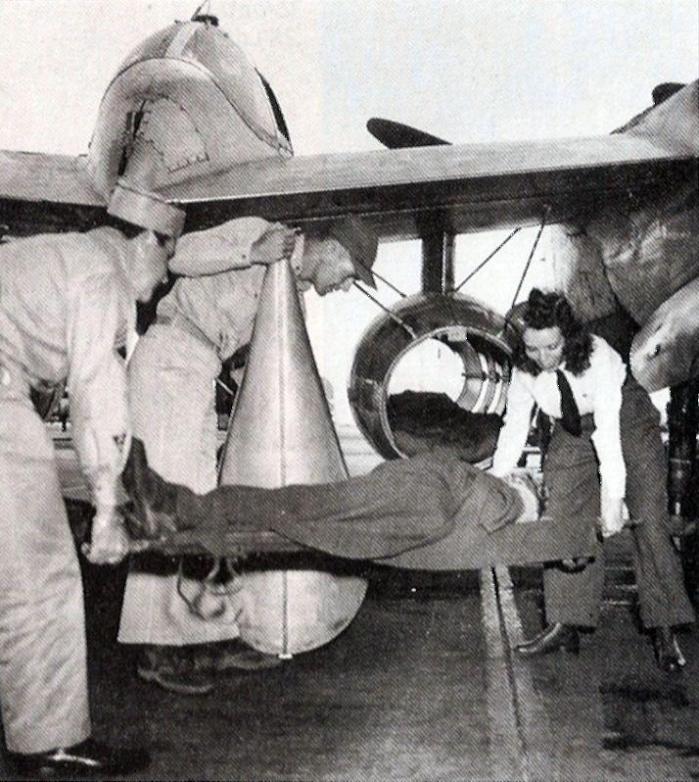
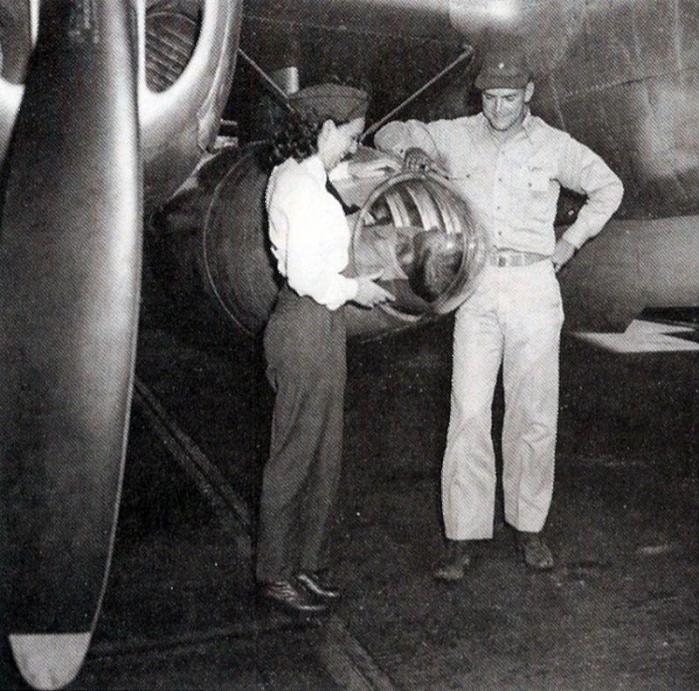
P-38 converti en ambulance aérienne, avec la 2nd Lt. Beulah Farmer - Converted to air ambulance with 2nd Lt. Beulah Farmer.
© USAF (domaine public - public domain)
Plus de 10000 avions construits !
More than 10,000 aircrafts manufactured !
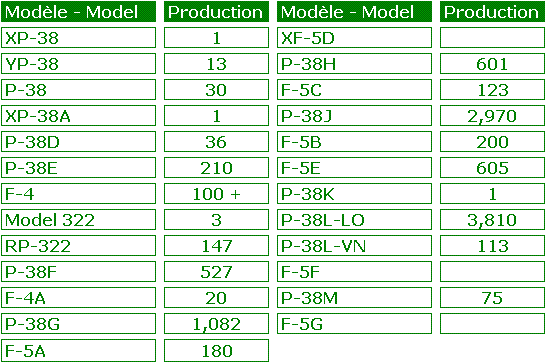
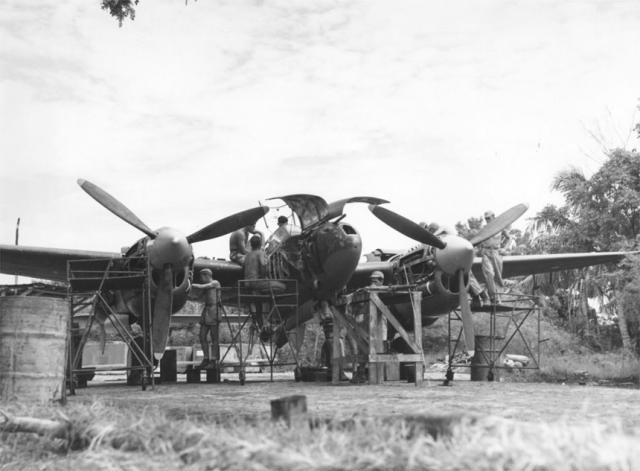
P-38 "Twin Dragon Squadron" - 459th FS, Chittagong - Inde, janvier 1945 - India January 1945
© USAF (domaine public - public domain)
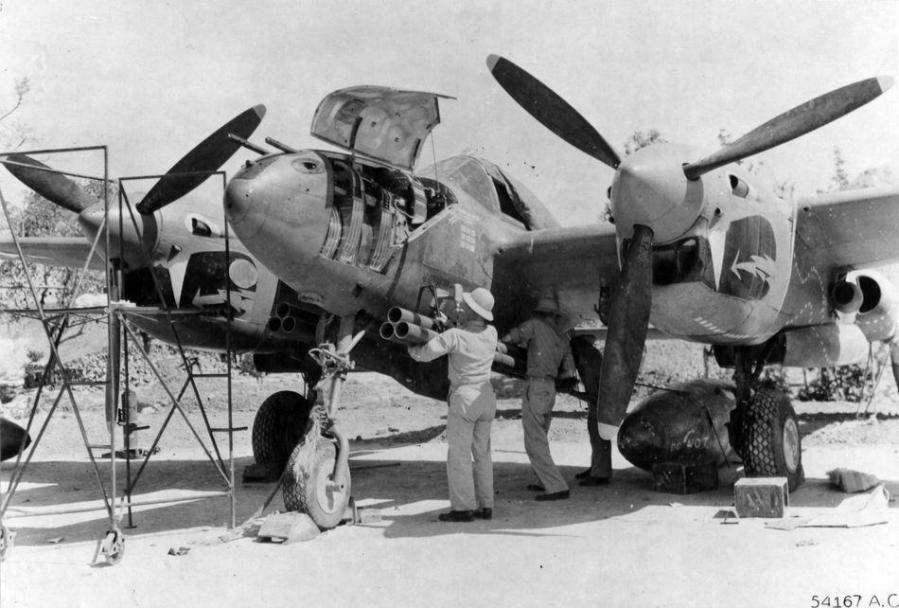
P-38J - 459th FS, 80th FG, Major Willard Webb - Chittagong - Inde - India
© USAF (domaine public - public domain) NARA 342-FH-3A33812-54167AC
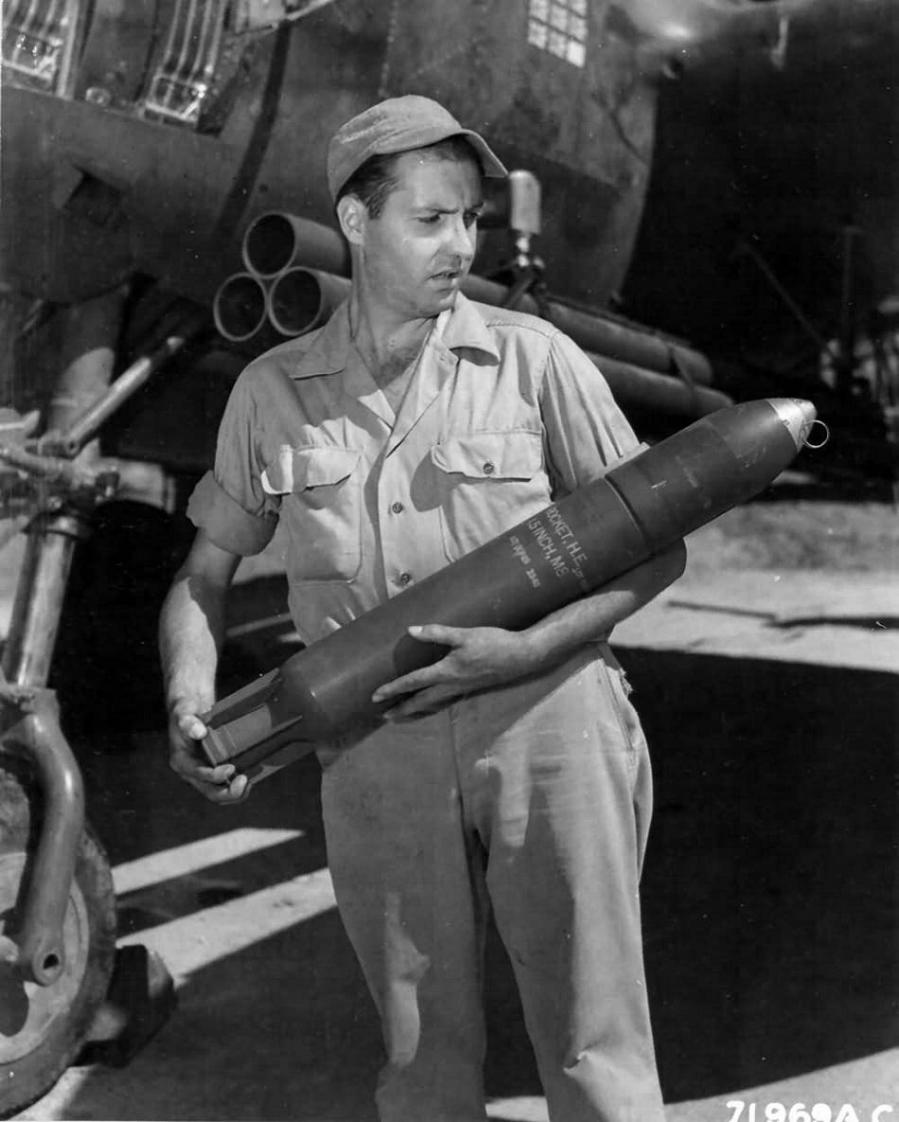
P-38J-10-LO (s/n 42-67842) - 459th FS, 80th FG, Major Willard Webb
Un armurier charge une rocket M8 (4,5 pouces) de bazooka - A mechanic loads an M8 (4.5 inch) bazooka rocket
© USAF (domaine public - public domain)
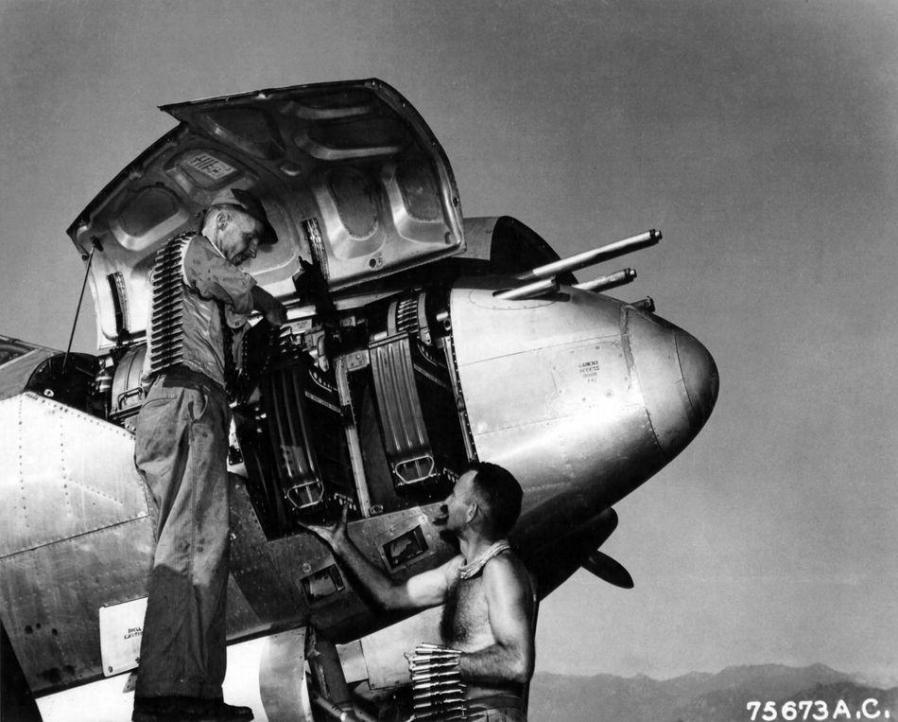
P-38 - 94th FS, 1st FG, Italie/Italy
Un armurier charge des munitons dans le nez d'un P-38 - An armorer loads ammunition in the nose of a P-38
© USAF (domaine public - public domain) NARA 342-FH-3A23066-75673AC
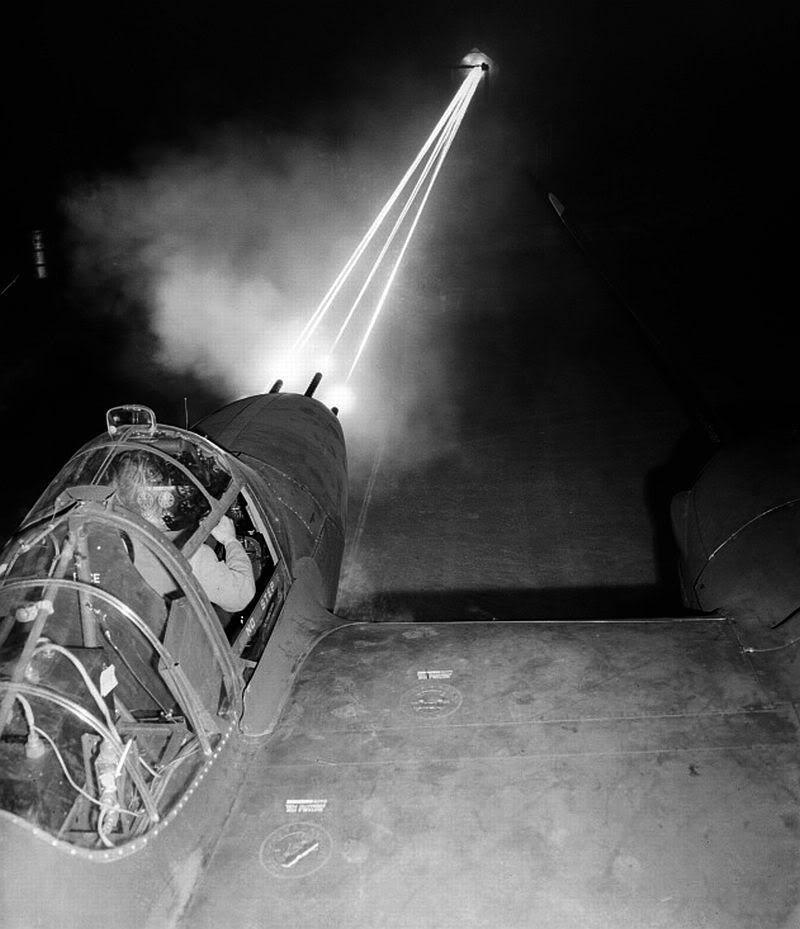
P-38 Lightning - Test de tirs de nuit - Night firing test
© USAF (domaine public - public domain)
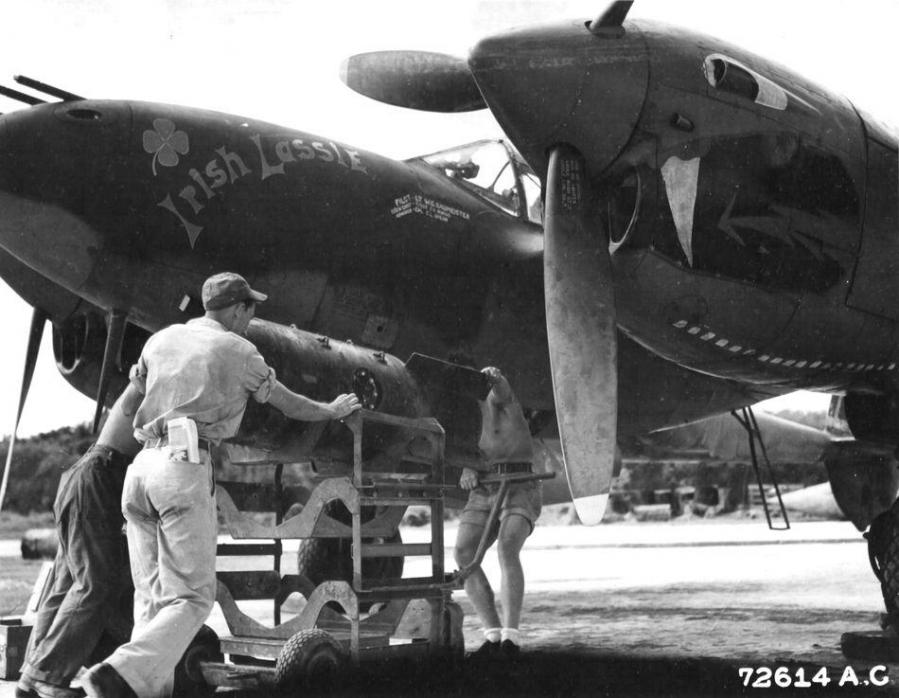
P-38J-10-LO (s/n 42-67842), 'Irish Lassie', 459th FS, 80th FG, 1st Lt. William G. Baumeister-Chittagong - Inde, été 1944 - India, Summer 1944
Des mécaniciens installent une charge de profondeur / Mechanics install a depth load
© USAF (domaine public - public domain)
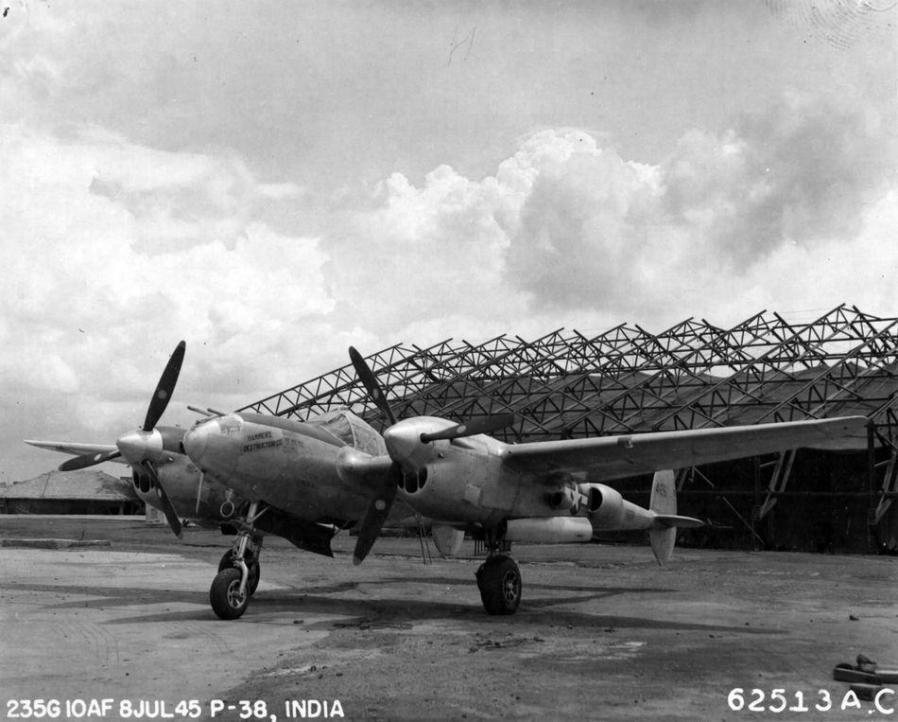
P-38 'Hammer's Destruction Company' - 90th FS, 80th FG, 1st Lt. Samuel E. Hammer - Inde, 8 juillet 1945 - India, 8th July, 1945.
© USAF (domaine public - public domain) NARA 342-FH-3A33693-62513AC
Fiche technique - Technical data
P-38L
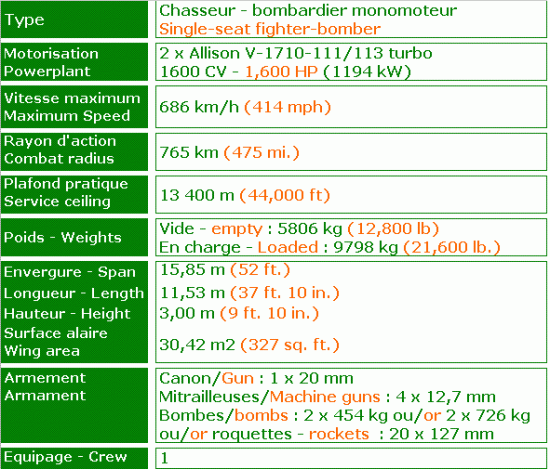
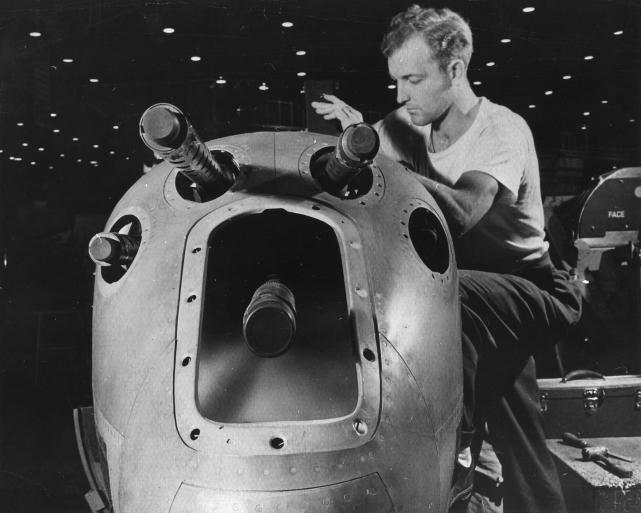
© U.S. National Archives and Records Administration - National Archives Identifier : 196367 (domaine public - public domain)
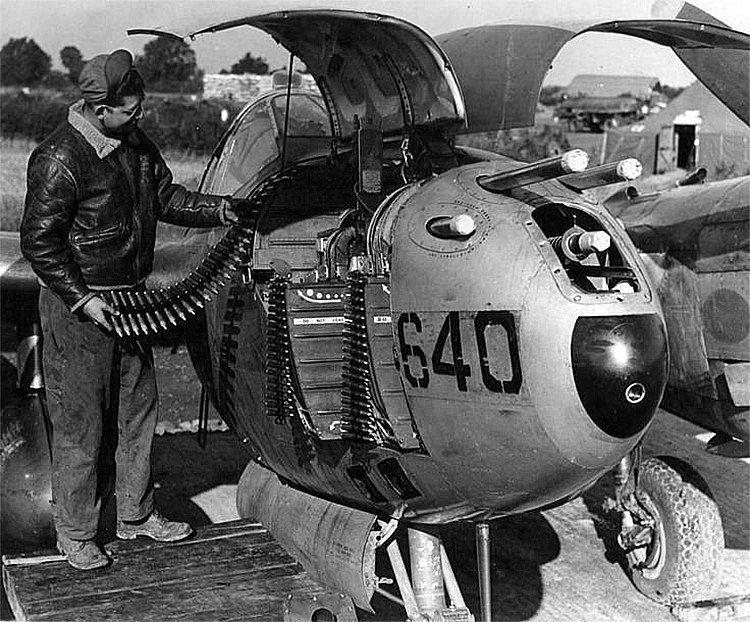
© USAF (domaine public - public domain)
Théâtres d'opération - Operational history
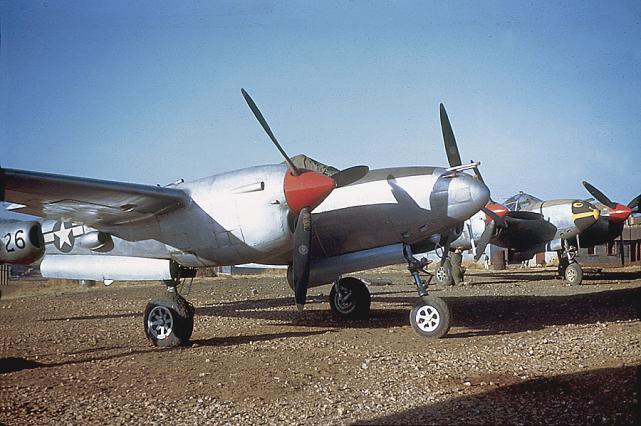
P-38 - 449th FS, Chengkung Airfield, China, 1945.
© USAF (domaine public - public domain)
La première unité à recevoir des P-38 fut le 1st Fighter Group. Après l'attaque sur Pearl Harbor, cette unité rejoignit le 14th Pursuit Group (équipé de P-38F) à Hamilton Field, Californie, pour participer à la défense de la côte ouest.
The first unit to receive P-38s was the 1st Fighter Group. After the attack on Pearl Harbor, the unit joined the 14th Pursuit Group (equipped with P-38F) in Hamilton Field, California, to provide West Coast defense.
Le début de la guerre - Entry to the war
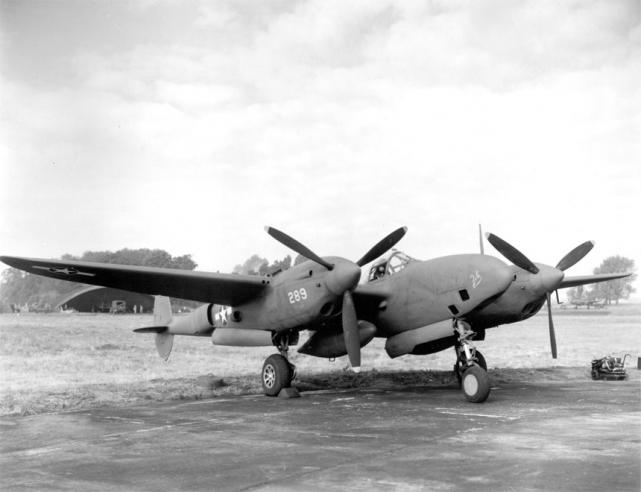
P-38 F-5A - 7th Photographic Reconnaissance Group (PRG) - Mt. Farm, Oxfordshire, Angleterre - England.
© USAF (domaine public - public domain) - Permission PD-USGOV-MILITARY-AIR FORCE.
Le premier Lightning a rejoindre le service actif fut le F-4, un P-38E dans lequel les armes furent remplacées par quatre cameras K17. Ils furent affectés au 8e Photographic Squadron en Australie le 4 avril 1942. Trois F-4 furent utilisés par l'Armée de l'Air Australienne sur ce théâtre d'opération pendant une courte période en septembre 1942. Le 29 mai 1942, 25 P-38 commencèrent à opérer depuis les îles Aléoutiennes en Alaska. Le 9 août1942, deux P-38 du 343e Fighter Group, Onzième Air Force, à l'issue d'une longue patrouille de 1600 kms, tombèrent sur une paire de Kawanishi H6K "Mavis" japonais et les détruisirent, faisant d'eux les premiers avions japonais à être abattus par des Lightning.
The first Lightning to see active service was the F-4 version, a P-38E in which the guns were replaced by four K17 cameras. They joined the 8th Photographic Squadron out of Australia on 4 April 1942. Three F-4s were operated by the Royal Australian Air Force in this theater for a short period beginning in September 1942. On 29 May 1942, 25 P-38s began operating in the Aleutian Islands in Alaska. On 9 August 1942, two P-38Es of the 343rd Fighter Group, Eleventh Air Force, at the end of a 1,000 mile (1,600 km) long-range patrol, happened upon a pair of Japanese Kawanishi H6K "Mavis" and destroyed them, making them the first Japanese aircraft to be shot down by lightnings.
Le théâtre Européen et Méditerranéen
European and mediterranean theaters
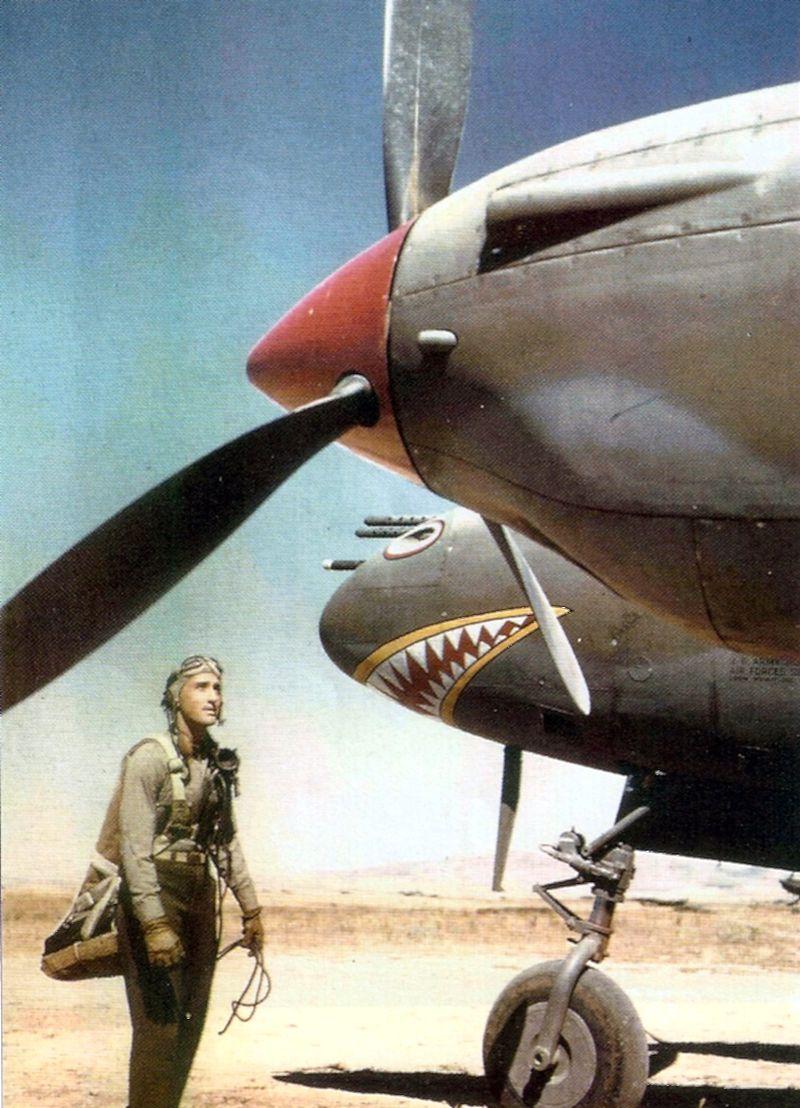
Lockheed P-38F Lightning 37th FS 14th FG, James Holingsworth, Youks-les-Bains (Algérie - Algeria), 1943
© USAF (domaine public - public domain)
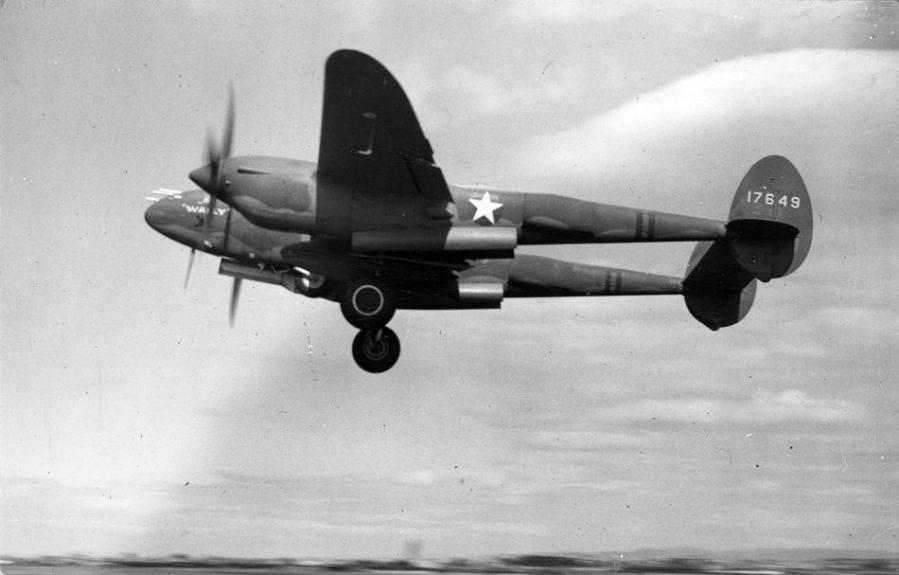
Lockheed P-38F-1 Lightning WALLY' (41-7649), 48th FS, 14th FG, CO. Major W.C. Walles, Youks-les-Bains (Algérie - Algeria), fin/late 1942
Photo FRE 10039 © IWM - www.americanairmuseum.com
En juillet 1942, il fut décidé d'envoyer des P-38 en Angleterre via la route Nord, comme par exemple les P-38F-1 du 27th FS - 1st FG. Les P-38 du 71ème Fighter Squadron furent envoyés à Goxhill (Lincolnshire). Certaines escadrilles demeurèrent en Islande pour effectuer des missions défensives au dessus de l'Atlantique (notamment le 50ème FS du 14ème FG qui fut réaffecté au 342ème Composite Group qui assistait les P-40C du 33ème FS).
In July 1942, it was decided to send P-38s in England via the Northern route, such P-38F-1s of 27th FS - 1st FG. The P-38s of the 71st Fighter Squadron were sent at Goxhill (Lincolnshire). Some Squadrons remained in iceland for defenseive patrols over the Atlantic (like the 50th FS of 14th FG which was reassigned to the 342nd Composite group to assist P-40Cs of the 33rd FS).
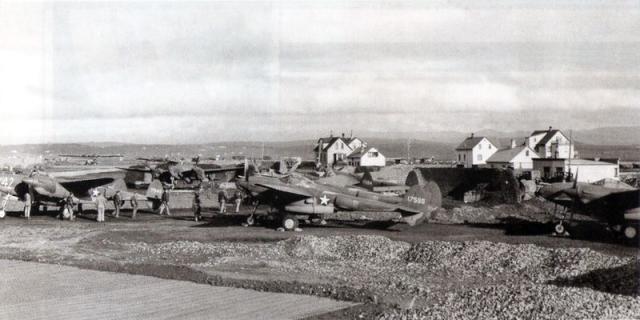
P-38-F-1 - 27th FS, 1st FG - 06/06/1942
En escale en Islande avant de rejoindre l'Angleterre.
Stopping in Iceland before reaching Englabnd.
© USAF (domaine public - public domain)
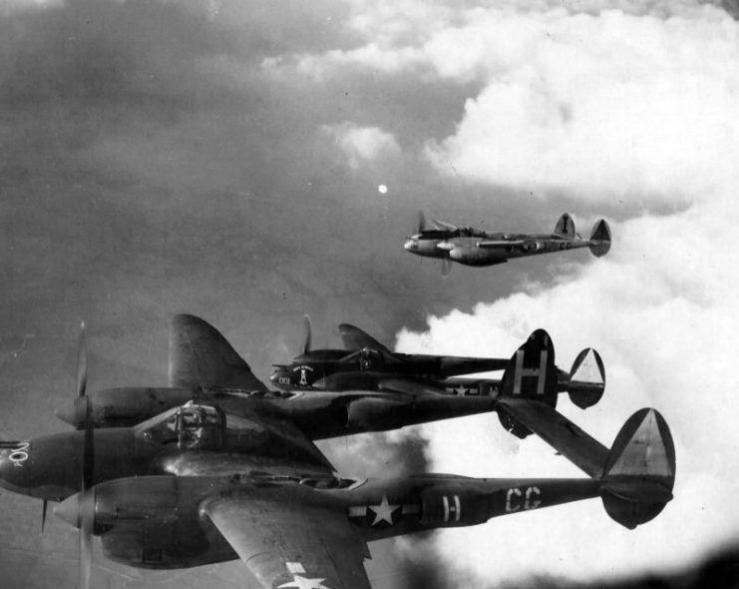
Lockheed P-38 Lightning, 38th FS, 55TH FG
En vol sur le Sud de la France - Flying over Southern France
© USAF (domaine public - public domain)
Le 14 août 1942, le 2nd Lieutenant Elza Shahan du 27ème Fighter Squadron et le 2nd Lieutenant Joseph Shaffer du 33ème Squadron opérant depuis l'Islande abattirent un Focke-Wulf Fw 200 "Condor" sur l'Atlantique. Shahan dans son P-38F abattit le Condor; Shaffer, pilotant un P-39 ou P-40 C, avait déjà incendié un moteur. C'était le premier avion de la Luftwaffe détruit par l'USAAF.
On 14 August 1942, 2nd Lieutenant Elza Shahan of the 27th Fighter Squadron, and 2nd Lieutenant Joseph Shaffer of the 33rd Squadron operating out of Iceland shot down a Focke-Wulf Fw 200 "Condor" over the Atlantic. Shahan in his P-38F downed the Condor; Shaffer, flying either a P-39 or a P-40 C, had already set an engine on fire. This was the first Luftwaffe aircraft destroyed by the USAAF.
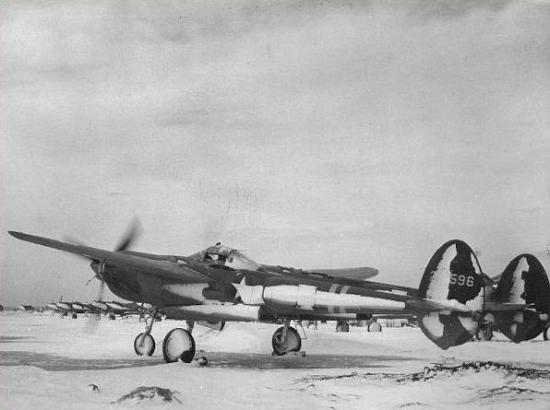
P-38-F-5-LO (42-12596) - 50th Fighter Squadron - 1942 (Islande - Iceland).
© USAF (domaine public - public domain)
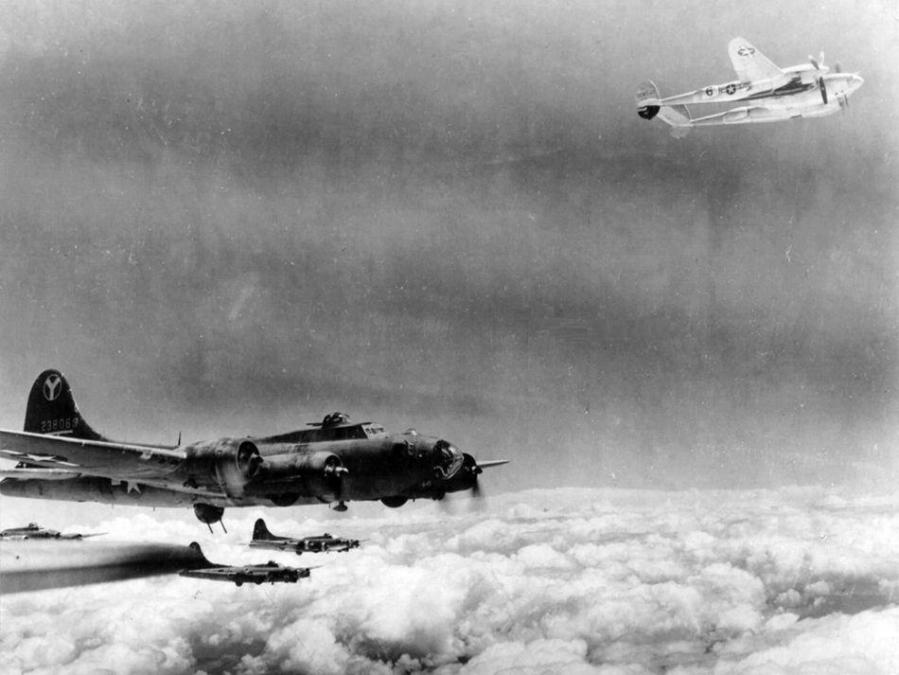
Lockheed P-38J Lightning, 27th FS, 1st FG
Moteur droit en panne (il perd de l'huile), sous la protection de B-17G du 2nd BG, 15th AF au dessus de Bleckhammer, Allemagne le 7 juillet 1944
Right engine failed (loosing oil), under the protection of B-17G of the 2nd BG, 15th AF above Bleckhammer, Germany on July 7, 1944
© USAF (domaine public - public domain)
Après 347 sorties sans avoir rencontré l'ennemi, les 1er, 14ème et 82ème Fighter Groups furent transférés à la 12ème Air Force en Afrique du Nord pour l'Opération Torch. Le 19 Novembre 1942, des Lightning escortèrent des Forteresses Volantes B-17 pour un raid sur Tunis. Le 5 avril 1943, 26 P-38F du 82ème détruisirent 31 avions ennemis, gagnant ainsi leur surnom de "Gabelschwanzteufel" - " Diable à queue fourchue". Mais le 25 août 1943, 13 P-38 furent abattus en une seule sortie par les Bf 109 de la Jagdgeschwader 53 sans obtenir une seule victoire. Le 2 septembre, dix P-38 furent abattus, contre une seule victoire, l'as aux 67 victoires Franz Schiess (qui était aussi le meilleur « tueur de Lightning » de la Luftwaffe avec 17 détruits).
After 347 sorties with no enemy contact, the 1st, 14th and 82nd Fighter Groups were transferred to the 12th Air Force in North Africa for Operation Torch. On 19 November 1942, Lightnings escorted B-17 Flying Fortresss on a raid over Tunis. On 5 April 1943, 26 P-38Fs of the 82nd destroyed 31 enemy aircraft, earning the German nickname "der Gabelschwanzteufel" - the "Fork-Tailed Devil". But on 25 August 1943, 13 P-38s were shot down in a single sortie by Jagdgeschwader 53 Bf 109s without achieving a single kill. On 2 September ten P-38s were shot down, in return for a single kill, the 67-victory ace Franz Schiess (who was also the leading "Lightning" killer in the Luftwaffe with 17 destroyed).
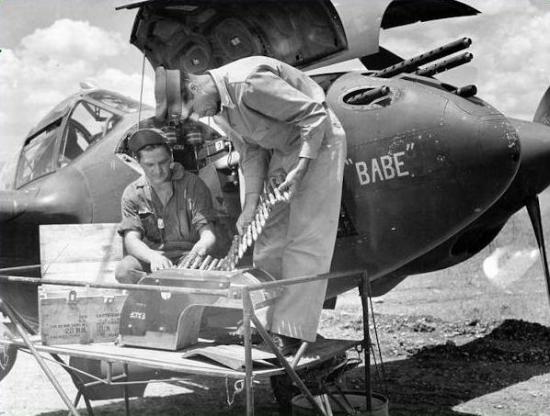
P-38 - 14th Fighter Group - 1943 (Afrique du Nord - Northern Africa).
© USAF (domaine public - public domain)
Les P-38 participèrent également aux combats pour la libération de la Corse en septembre et octobre 1943. Le 3 octobre, des Bf 109 G-6 du III./JG 77 affrontent les P-38G du 37th FS/14th FG. Le 2/Lt Donald L. Clarck revndique une victoire, toutefois non reconnue par les allemands.
P-38 also participated in the fights for the liberation of Corsica in September and October, 1943. On October 3rd, Bf 109 G-6 of the III./ JG 77 faced P-38G of the 37th FS/14th FG. 2 / Lt Donald L. Clarck claimed a victory, however not recognized by German.
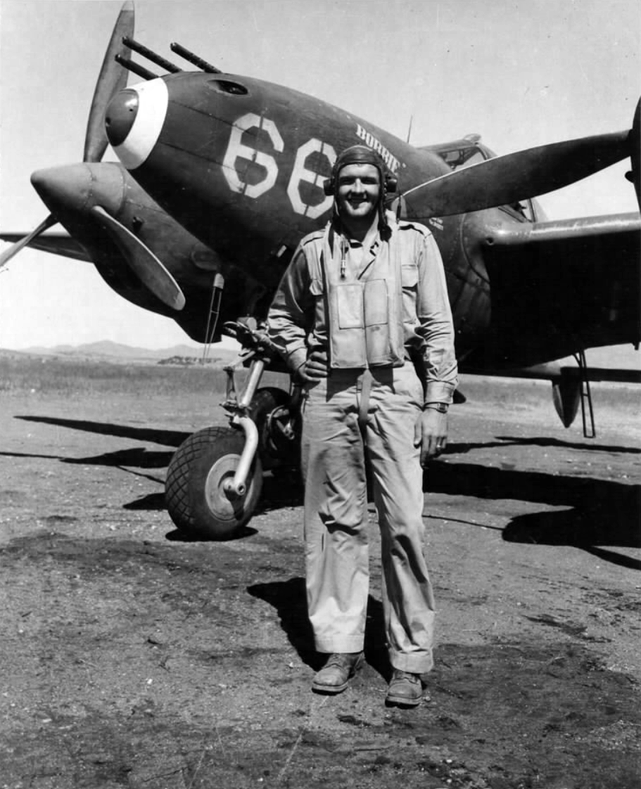
P-38G "Bobbie" - 37th FS/14th FG - 1943 - Lt Robert E. Gardner
Participa aux combats du 3 octobre - Participated to the 3rd October fights.
© U.S. National Archives and Records Administration - (domaine public - public domain)

P-38G "Tommie's / Lucky Penny" - 48th FS/14th FG - Lt Sidney W. Weatherford
Septembre 1943 - September 1943.
© Dekker Art Work - Thierry Dekker http://dekkerartwork.over-blog.com/
Le 3 mars 1944, les premiers chasseurs allies à atteindre Berlin lors d'une mission d'escorte (en fait ils ne trouvèrent jamais les B-17 qui firent demi-tour à Hambourg) étaient des P-38H du 55ème FG, conduits par le Lieutenant Colonel Jack Jenkins. Les expériences sur l'Allemagne avaient démontré le besoin d'avions d'escorte à long rayon d'action pour protéger les opérations de bombardements lourds de la Huitième Air Force.
On March 3, 1944, the first Allied fighters to reach Berlin on an escort mission (in fact they never met the B-17s who turned back at Hamburg) were P-38H of 55th FG, led by Lieutenant Colonel Jack Jenkins. Experiences over Germany had shown a need for long-range escort fighters to protect the Eighth Air Force's heavy bomber operations.
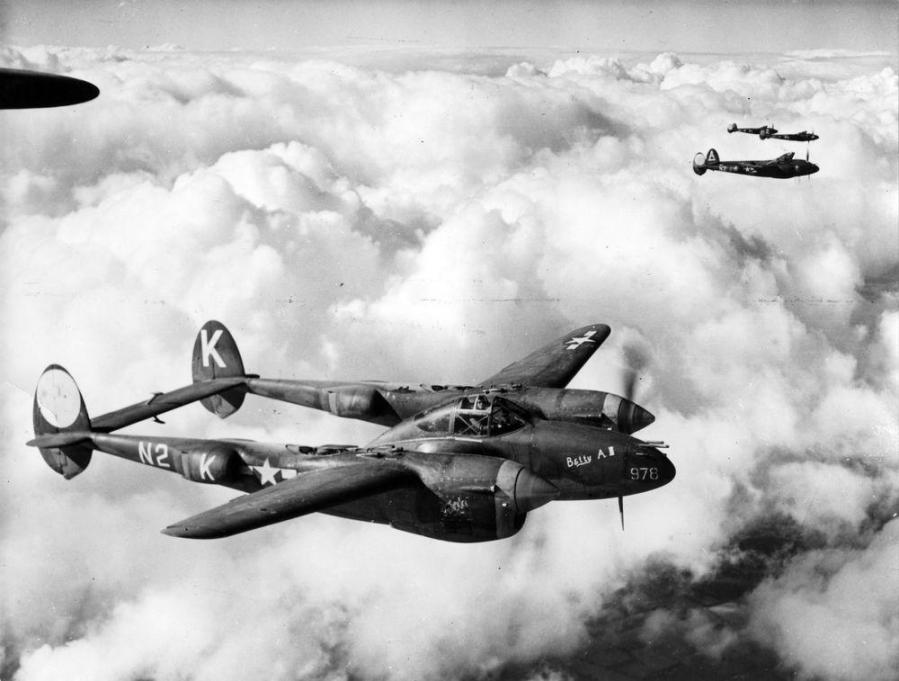
Lockheed P-38J Lightning - 364th FG,
dont le 42-67978 N2-K du 383rd FS, surnommé "Betty A III" à droite et "Mim" à gauche.
including 42-67978 N2-K of 383rd FS, nicknamed "Betty A III" on the right and "Mim" on the left.
Photo FRE10101 © IWM - www.americanairmuseum.com
Les P-38H du 55ème Fighter Group furent transférés à la 8ème AF en Angleterre en septembre 1943 et furent rejoint peu après par les 20ème, 364ème et 479ème Fighter Groups.
The P-38Hs of the 55th Fighter Group were transferred to the 8th AF in England in September 1943, and were joined by the 20th, 364th and 479th Fighter Groups soon after.
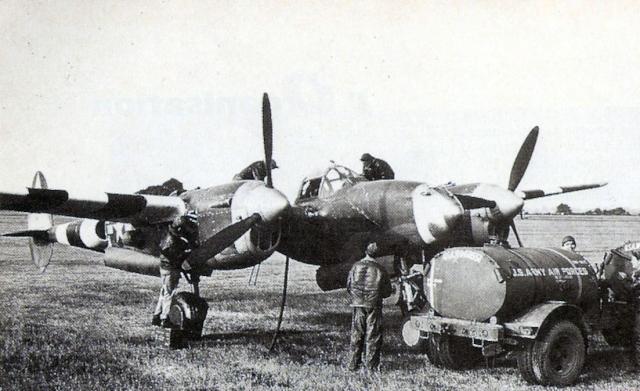
P-38 Lightning - 20th Fighter Group
© USAF (domaine public - public domain)
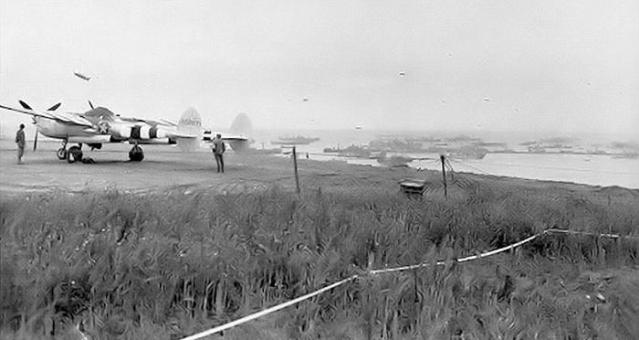
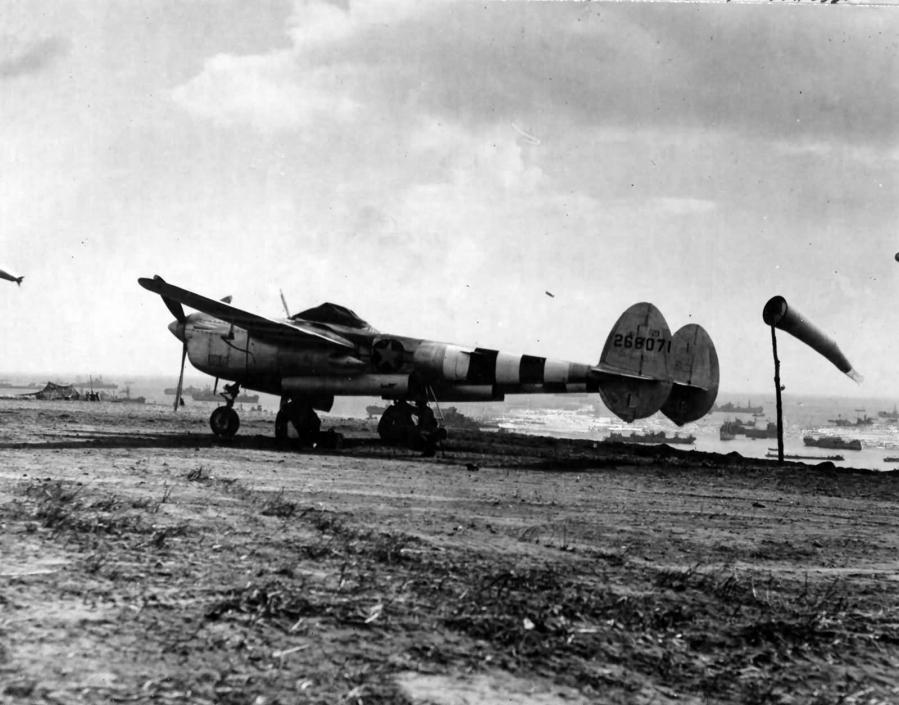
P-38J Lightning (s/n 42-68071), 392nd FS, 367th FG, Saint-Pierre-du-Mont Airfield
14 juin 1944, le 1er P-38J à avoir atterri en France - 14th June, 1944, the 1st P-38J which landed in France
© USAF (domaine public - public domain)
Grâce à sa forme distinctive qui permettait d'éviter les erreurs de reconnaissance et les feux amis, le Lieutenant Général James Harold "Jimmy" Doolittle, Commandant de la Huitième Air Force, choisit de piloter un P-38 pendant l'invasion de la Normandie afin d'assister personnellement aux progrès de l'offensive aérienne au dessus de la France. Doolittle affirma que c'était "l'avion volant le plus doux du ciel".
Because its distinctive shape was less prone to cases of mistaken identity and friendly fire, Lieutenant General James Harold "Jimmy" Doolittle, Commander Eighth Air Force, chose to pilot a P-38 during the Invasion of Normandy so that he could personally assess the progress of the air offensive over France. Doolittle said that it was "the sweetest flying plane in the sky".

Lockheed P-38J-25-LO (s/n H5-A - 44-23677) 'Little Buckaroo', 392nd FS, 367th FG, 9th AF.
Pilote : Sqn. Co. Maj. Robert C. Rogers, France, août 1944.
Pilot : Sqn. Co. Maj. Robert C. Rogers, France, August 1944.
© Zaur Eylanbekov - www.foxbatfiles.com
Un rôle peu connu du P-38 sur le théâtre européen fût celui de chasseur-bombardier pendant l'invasion de la Normandie et l'avance Alliée en France et en Allemagne. Assigné au IX° Tactical Air Command, les P-38-J du 370ème Fighter Group ont initialement effectué des missions depuis l'Angleterre, bombardant des installations radar, des défenses ennemies, des concentrations de troupes et des tours de canons antiaériens.
A little-known role of the P-38 in the European theater was that of fighter-bomber during the invasion of Normandy and the Allied advance across France into Germany. Assigned to the IX Tactical Air Command, the 370th Fighter Group and its P-38-Js initially flew missions from England, dive-bombing radar installations, enemy armor, troop concentrations, and flak towers.
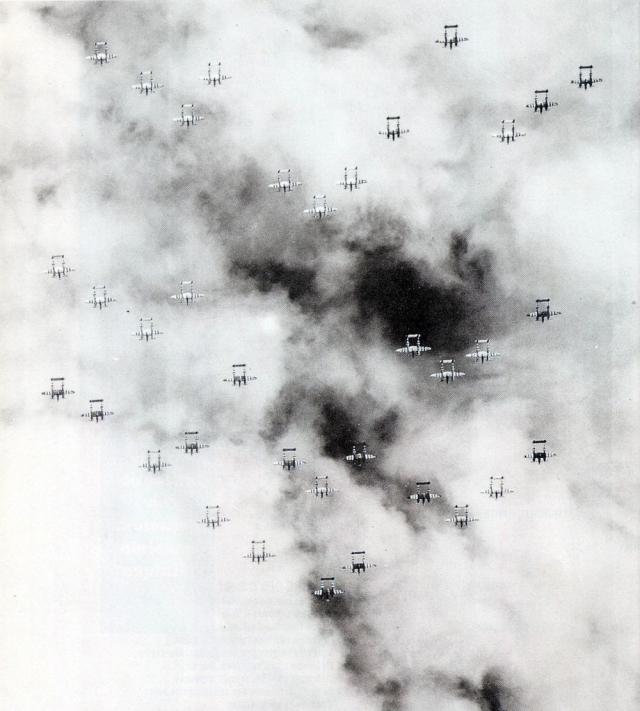
P-38 Lightning
Vol en formation par escadrilles de 4 avions en "finger four"
4 aircrafts squadrons flying in "finger four".
© USAF (domaine public - public domain)

Lockheed P-38J-15 (s/n 43-28393), 20th FG.
Lt. Col. Cy Wilson, commandant du 20th FG, King's Cliffe, Royaume-Uni, fin juin 1944.
Le code "KI-W" est couvert par les bandes de débarquement
Lt. Col. Cy Wilson, Commanding Officer of 20th FG, King's Cliffe, UK, late June, 1944.
The code "KI-W" is covered by invason stripes
© Dekker Art Work - Thierry Dekker http://dekkerartwork.over-blog.com/

Lockheed P-38J-15 (s/n 42-104287), 38th FS, 55th FG.
Wormingford, Royaume-Uni, juillet1944. Le code "CG-I" est couvert par les bandes de débarquement
Wormingford, UK, July, 1944. The code "CG-I" is covered by invason stripes
© Dekker Art Work - Thierry Dekker http://dekkerartwork.over-blog.com/
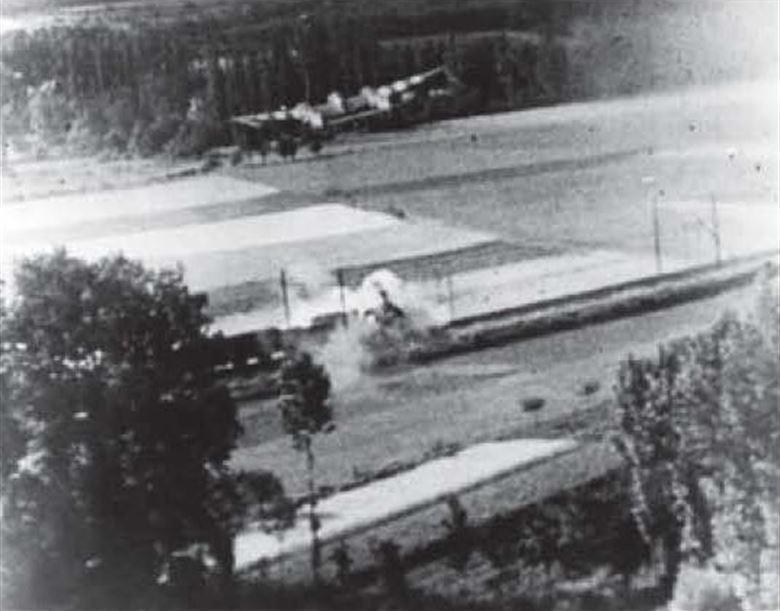
Lockheed P-38
Attaque de train en 1944 - Attacking a train in 1944
© USAF (domaine public - public domain)
Le Group Commander du 370ème FG, Howard F. Nichols, et une de ses escadrilles de Lightning P-38 détruisirent le quartier général du Field Marschall Günther von Kluge en juillet 1944.
The 370th's group commander Howard F. Nichols and a squadron of his P-38 Lightnings blasted Field Marshal Günther von Kluge's headquarters in July 1944.
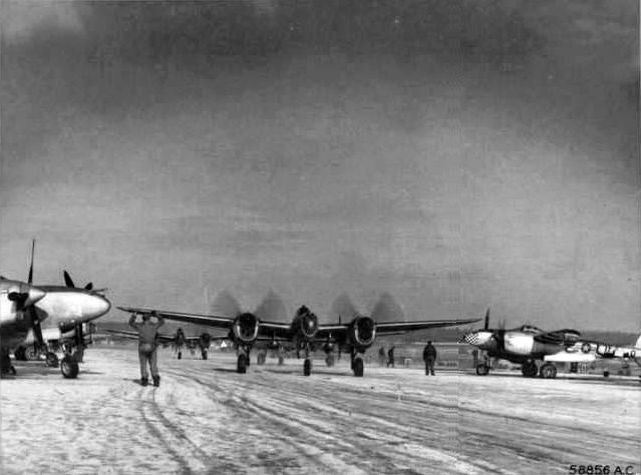
P-38 Lightning - 370th FG
Florennes, Belgique, fin 1944 - Florennes, Belgium, late 1944.
© USAF (domaine public - public domain)
A partir du 20 juillet 1944, le 370ème opéra depuis Cardonville (Advanced Landing Ground ALG A-3), en France, des missions d'attaque au sol et frappa des positions armées, des concentrations de troupes, des dépôts de matériels et des chars près de Saint Lo en juillet et dans le secteur Falaise-Argentan en août 1944.
From July 20th, 1944, the 370th operated from Cardonville (Advanced Landing Ground ALG A-3), France, flying ground attack missions hitting gun emplacements, troops, supply dumps, and tanks near St Lo in July and in the Falaise-Argentan area in August 1944.
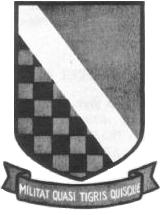
Emblème du 370th Fighter Group.
Emblem of 370th Fighter group.
© USAF (domaine public - public domain)
Le 370ème participa à des missions d'attaques au sol dans toute l'Europe jusqu'en février 1945, quand l'unité fût transformée sur P-51 Mustang.
The 370th participated in ground attack missions across Europe until February 1945, when the unit was transitioned to the P-51 Mustang.
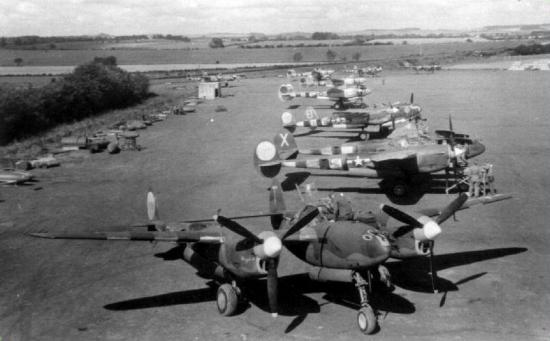
P-38-J - 402nd Fighter Squadron - 370th Fighter Group - Andover (Angleterre - England).
© USAF (domaine public - public domain)
Sur le théâtre Méditerranéen, des pilotes italiens durent faire face aux P-38 dès la fin de 1942 et considérèrent cet avion comme un formidable adversaire même comparé au Spitfire. Globalement, le P-38 fut utilisé avec succès sur l'ETO (European Territory of Operation), quoique l'avion ait subi des pannes de moteur régulières dans les premiers mois en raison de surchauffe.
In the Mediterranean Theater, Italian pilots started to face P-38s from late 1942 and considered the type a formidable foe even compared to the Spitfire. Overall, the P-38 performed well in the ETO, though the aircraft suffered regular engine failures in the first months of deployment due to overheating.

Lockheed P-38L-1-LO (s/n 44-24370), 71th FS, 1st FG.
Italie, 1944 - Italy, 1944.
© Thomas A. Tullis - TULLIS AVIATION ART Ltd - www.tullisart.com
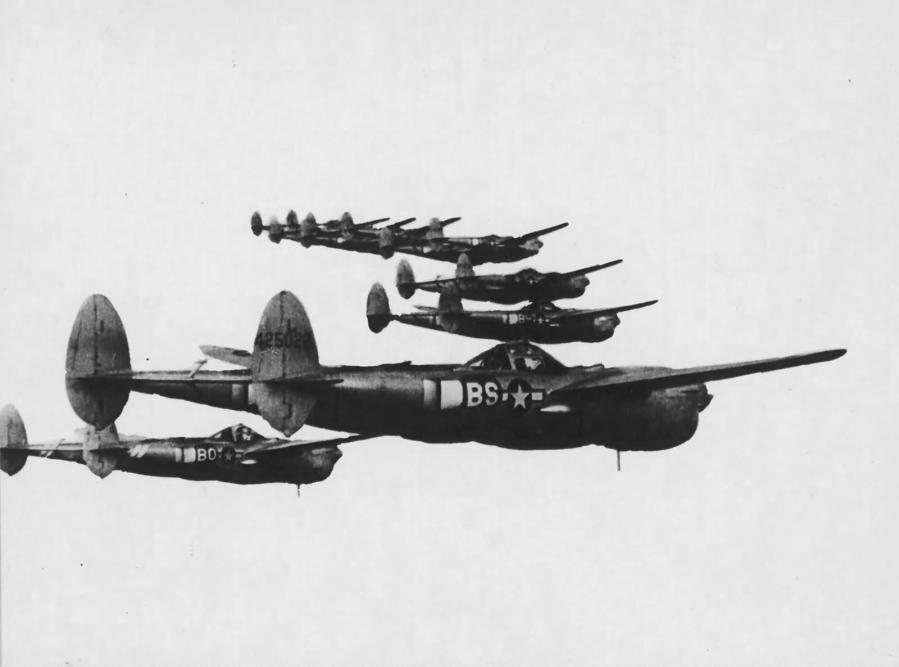
Lockheed P-38L, 96th FS, 82nd FG.
Italie, 1944 - Italy, 1944.
© USAF (domaine public - public domain)
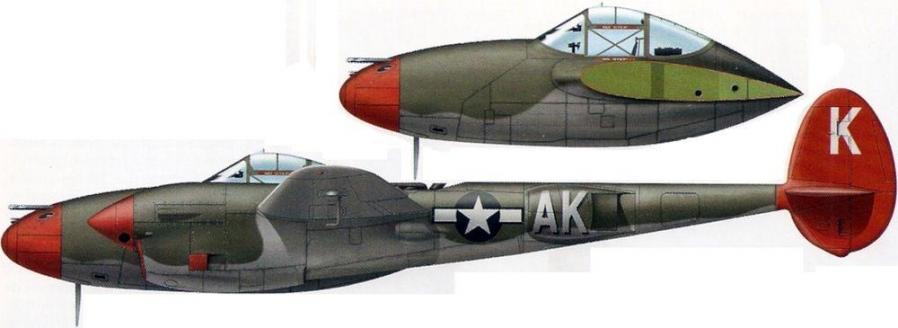
Lockheed P-38-J - 95th FS, 82nd FG,
Vincenzo, Italie, novembre 1944 - Italy, November 1944.
© Jean-Marie Guillou
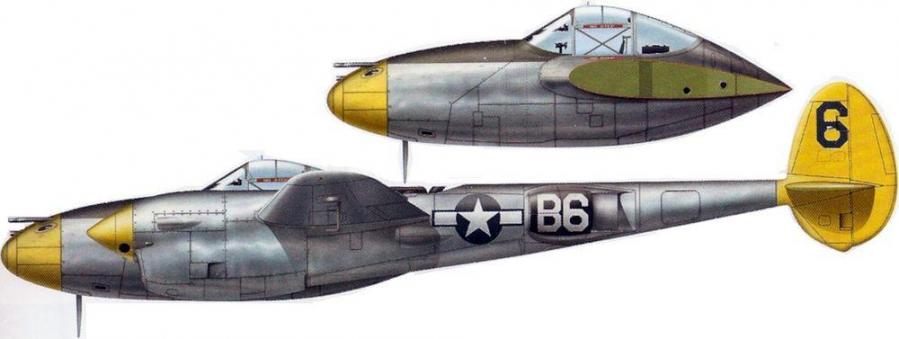
Lockheed P-38-L - 96th FS, 82nd FG,
Vincenzo, Italie, novembre 1944 - Italy, November 1944.
© Jean-Marie Guillou
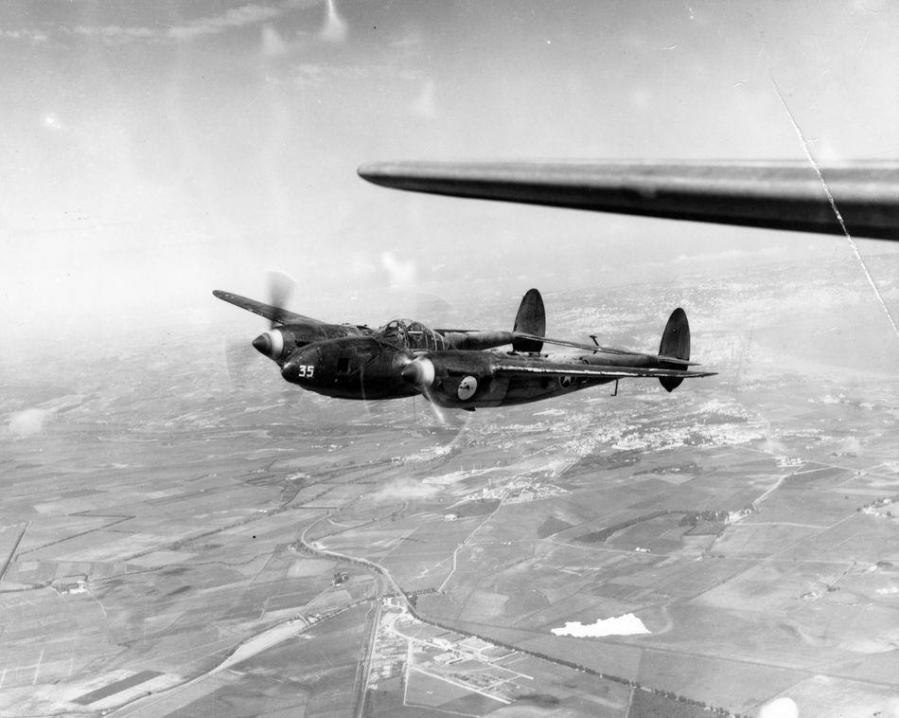
Lockheed F-5A Lightning 90th Photographic Reconnaissance Wing, 12th Air Force - Italie/Italy
Photo FRE10109 © IWM - www.americanairmuseum.com
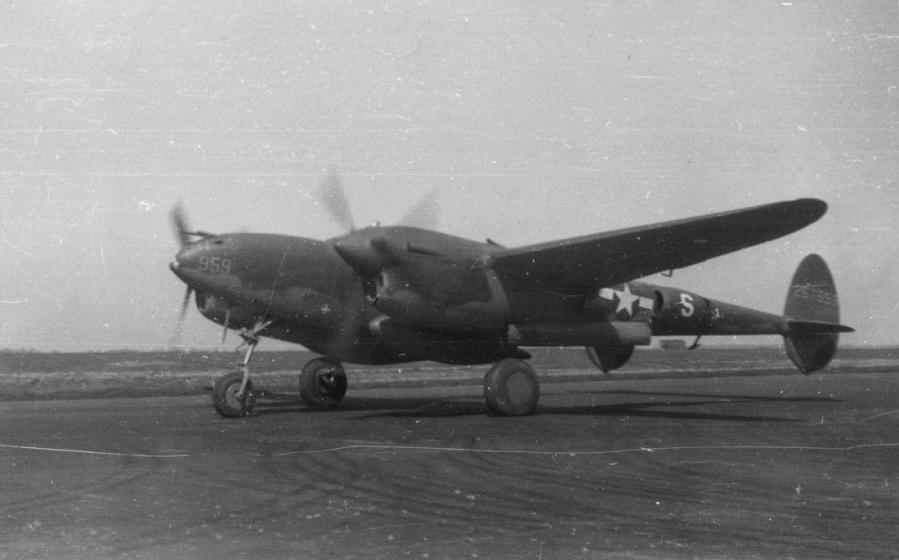
Lockheed P-38J, 95th FS, 82nd FG.
Initialement au 20th FG - Formerly to the 20th FG.
© IWM (Roger Freeman Collection - FRE 2410) - www.americanairmuseum.com
Beaucoup de problèmes de l'avion furent cependant résolus avec l'introduction du P-38J ; toutefois, avant septembre 1944, tous les groupes de Lightning de la Huitième Air Force sauf un furent convertis en Mustang P-51. La 8ème AF continua néanmoins avec succès des missions de reconnaissance avec des versions F-5. Sur l'ETO, les P-38 effectuèrent 130 000 sorties avec un niveau de perte global de 1,3% (contre 1,1% pour les P-51).
Many of the aircraft's problems were solved with the introduction of the P-38J; however, by September 1944, all but one of the Lightning groups in the Eighth Air Force had converted to the P-51 Mustang. The 8th AF continued to successfully conduct reconnaissance missions using the F-5 variant. In the ETO, P-38s made 130,000 sorties with a loss of 1.3% overall (versus 1.1% for the P-51s).
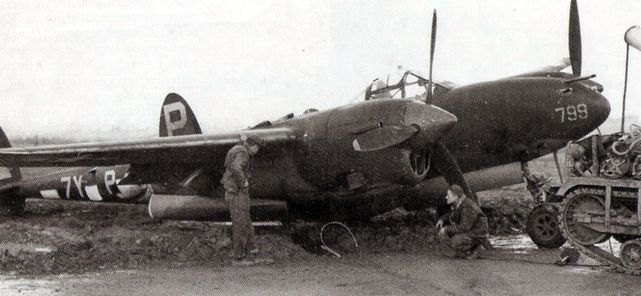
P-38 - 1944, Belgique - Belgium.
© USAF (domaine public - public domain)
Un P-38 aux couleurs italiennes
A P-38 under italian colors

Lockheed P-38F - Lt. Col. Angelo Tondi - 1943.
© Dekker Art Work - Thierry Dekker http://dekkerartwork.over-blog.com/
Quelques P-38 tombèrent aux mains d'unités allemandes et italiennes et furent évalués (au Centre Expérimental de Guidonia près de Rome) et même utilisés en combat. Le 12 juin 1943, un P-38 F de l'USAAF (peut-être s/n 42-68274 mais non confirmé) se posa par erreur à Capoterra, près de Cagliari (peut-être le 2nd Lt Dwight Hartle du 3rd PRG bien que le P-38 capturé semble être du 1st FG avec un code LM + ?).
A small number of P-38s fell into the hands of German and Italian units and were subsequently tested (in Guidonia Experimental center near Roma) and used in combat. On 12th June, 1943, a P-38 F from l'USAAF (perhaps s/n 42-68274 but not confirmed) landed by mistake at Capoterra, near Cagliari (perhaps 2nd Lt Dwight Hartle of 3rd PRG despite the captured P-38 semt to belong to 1st FG with a code LM + ?).
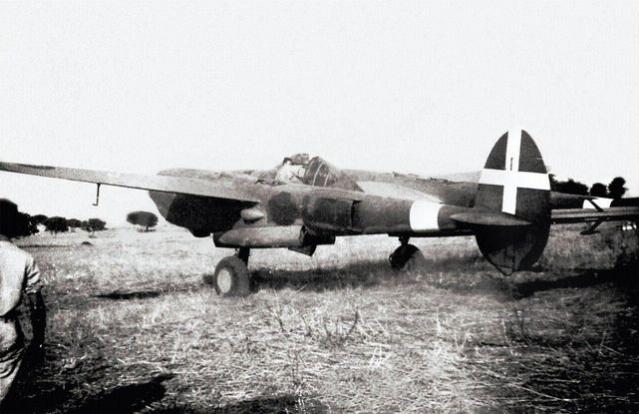
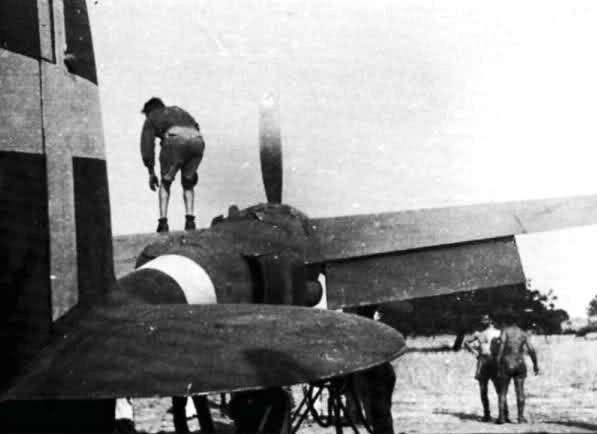
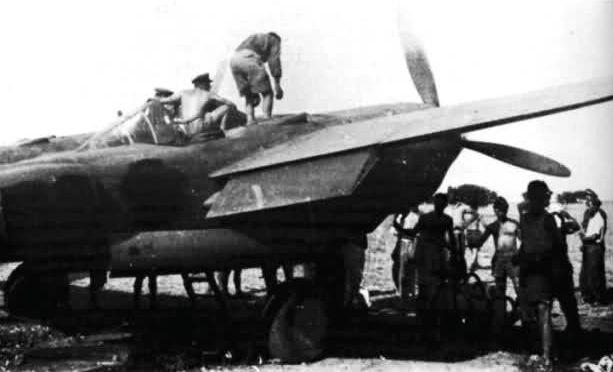
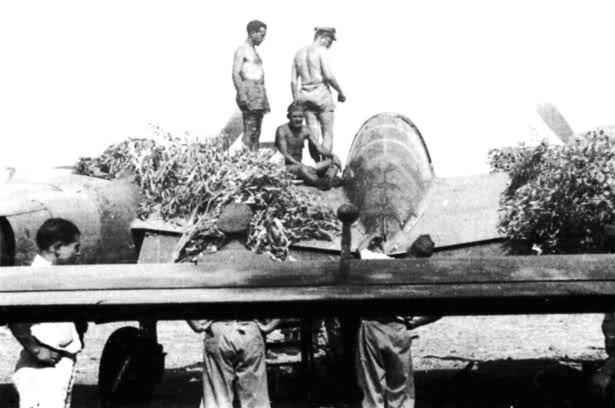
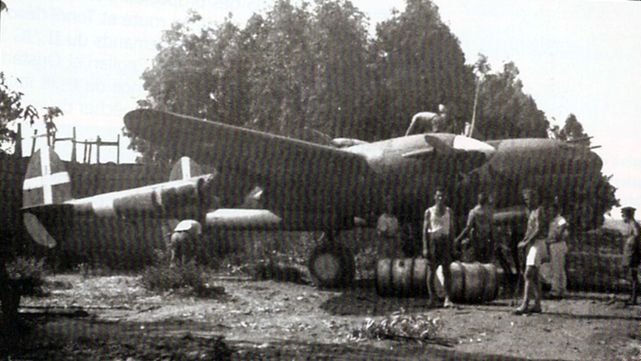
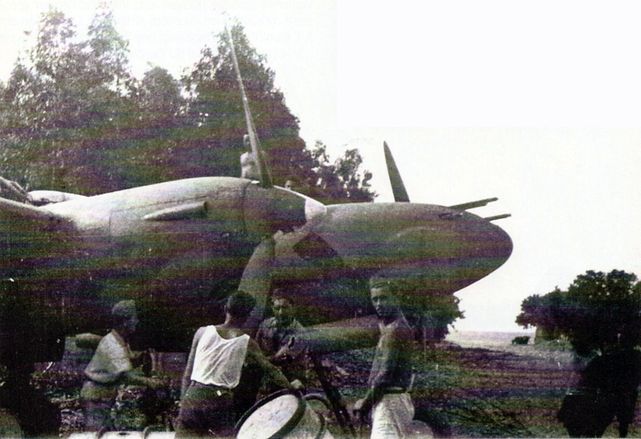
Lockheed P-38F
Capturé par les Italiens à Capoterra, Sardaigne.
Captured by the Italians at Capoterra, Sardinia.
Photo : auteur et source inconnus - author and source unknown
Le Colonel Angelo Tondi (Commandant du 1e Reparto Aeromobili Terrestri du 1° Centro Sperimentale) et le mécanicien Aldo Stagliano furent envoyés à Capoterra pour essayer puis ramener l'appareil à Guidonia.Des marques italiennes furent rapidement peintes et Tondi s'envola pour Guidonia. Pendant le vol, il largua par erreur le toit de la verrière.
Colonel Angelo Tondi (Commander of the 1st Reparto Aeromobili Terrestri from 1st Centro Sperimentale) and the mechanic Aldo Stagliano were sent at Capoterra to test and bring back the aircraft to Guidonia. Italian markings were rapidly painted and Tondi took off for Guidonia. During the flight, he released by mistake the top of the canopy.
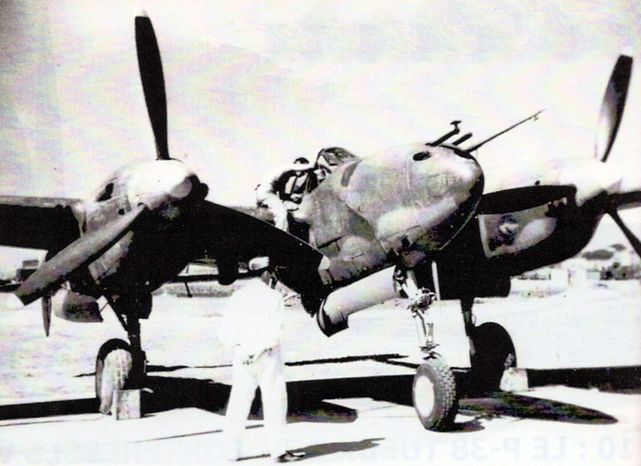
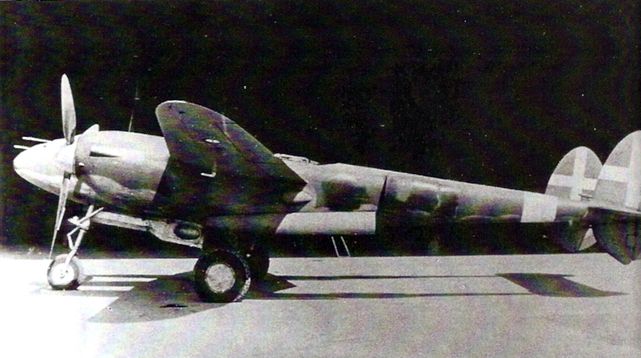
Lockheed P-38F, Guidonia
Photo : auteur et source inconnus - author and source unknown
Le 11 août 1943, deux vagues de B-17 du 301st Bombardment Group bombardèrent la gare de Terni et la vlle d'Ombrie. Vers 11h, sur le chemin du retour, le P-38 du Colonel Tondi et un Macchi MC 205 du Capitano Franco Benato, attaquèrent le premier groupe de B-17. Suivant les différents témoignages, le P-38 effectua entre 2 et 6 attaques et il abbattit l'avion de queue, le B-17F-95-BO (s/n 42-30307) "Bonnie Sue" du 419th BS, piloté par le 1st Lt Albert Fensel.
On 11 August, 1943, two groups of B-17 from 301st Bombardment Group attacked the railway station at Terni and the city of Ombrie. On the way back, at 11 am, the P-38 of Colonel Tondi and a Macchi MC 205 flown by Capitano Franco Benato, attacked the first group of B-17s. According to various testimonies, the P-38 made from 2 to 6 attacks and shot down the tail-end aircraft, the B-17F-95-BO (s/n 42-30307) "Bonnie Sue" from 419th BS, flown by 1st Lt Albert Fensel.
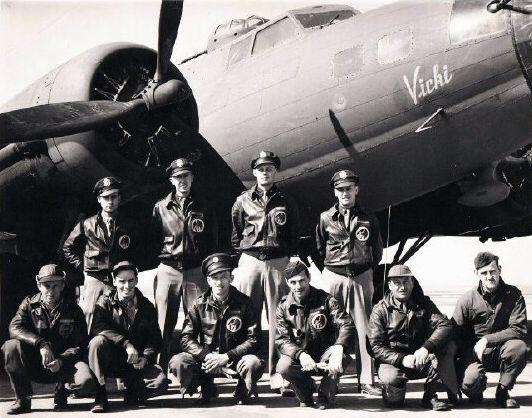
Boeing B-17F-95-BO (s/n 42-30307) "Bonnie Sue" (right) "Vicki" (Left)
Debout G à D / Back Row L to R : F/O Bobbie Follet - Lt. Richard Jamerson - Lt. Pete Robeck - Lt. Albert J. Fensel.
Accroupis G à D / Front Row L to R: Sgt. Jack Ledford - Sgt. Bill Cummings - Sgt. Robert Kennedy - S/Sgt. Rod Robinson - S/Sgt Martin Poler - Sgt. Charles Bange.
Photo : auteur et source inconnus - author and source unknown
Le reste de l'équipage était : 2nd Lt Bobbie Follet (co-pilote), 2nd Lt Richard Jameson (navigateur), 2nd Lt Peter Robeck (bombardier), S/Sgt Martin Poler (mécanicien), Sgt Robert Kennedy (mitrailleur latéral), S/Sgt Rodman Robinson (radio), Sgt William Cummings (mitrailleur ventral), Sgt Jack Ledford (mitrailleur de queue) et Sgt Charles Bange (mitrailleur latéral). Sept parachutes furent comptabilisés mais seulement trois membres d'équipage furent repêchés par un Catalina (Jameson, Robeck, Ledford). Un autre B-17F-85-BO (s/n 42-30093) du 419th BS (Pilote : 1st Lt Silvestri - Co-pilote : 2nd Lt Franck J. Jowdy) fut endommagé et se posa en campagne en territoire Tunisien. L'équipage fut indemne.
The rest of the crew was : 2nd Lt Bobbie Follet (co-pilot), 2nd Lt Richard Jameson (navigator), 2nd Lt Peter Robeck (bombardier), S/Sgt Martin Poler (engineer), Sgt Robert Kennedy (waist gunner), S/Sgt Rodman Robinson (radio operator), Sgt William Cummings (ball turret), Sgt Jack Ledford (tail gunner) et Sgt Charles Bange (waist gunner). Seven parachutes were seen but only three members of the crew were rescued by a Catalina (Jameson, Robeck, Ledford). Another B-17F-85-BO (s/n 42-30093) from 419th BS (Pilot : 1st Lt Silvestri - Co-pilot : 2nd Lt Franck J. Jowdy) was damaged and made a forced landing in the Tunisian territory. The crew was safe.
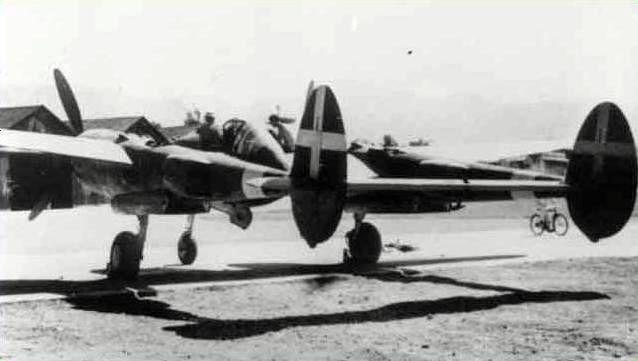
Lockheed P-38F
© Signor Gianpiero - source : 1st Fighter Association - www.1stfighter.com
Le P-38 fut probablement transféré entre le 10 et le 18 septembre 1943 à Rechlin en Allemagne par le Feldwebel Heinz Girnth (9./JG 53) et fut codé T9 + XB. Il rejoignit un autre P-38 codé T9+MK (ex- P-38F5E du Lt. Martin Monti s/n 44-23725).
The P-38 was probably transferred between the 10th and 18th September, 1943 to Rechlin in Germany by Feldwebel Heinz Girnth (9./JG 53) and was coded T9 + XB. He joined another P-38 coded T9+MK (ex-P-38F5E of Lt. Martin Monti s/n 44-23725).
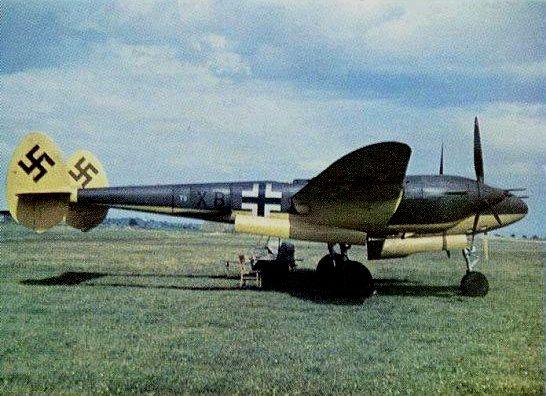
Lockheed P-38F "T9+XB"
Photo : auteur et source inconnus - author and source unknown

Lockheed P-38F "T9+XB"
auteur inconnu - author unknown - source : wings palette
Le P-38 de Martin James Monti
Martin James Monti's P-38
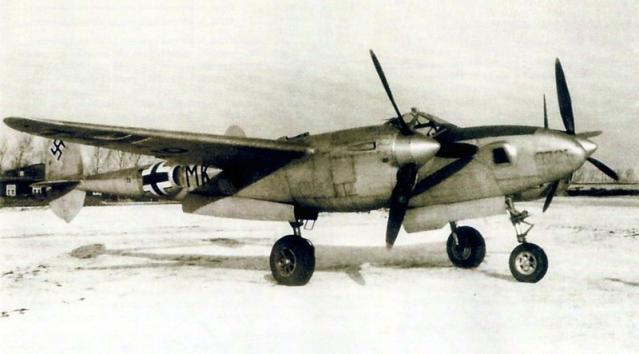
Lockheed P-38F-5E "T9+MK"
Photo : auteur et source inconnus - author and source unknown
Né à Saint-Louis dans le Missouri le 24 octobre 1921, M.J. Monti est le fils d'un couple d'immigrés italo-allemands. Admirateur d'Hitler et de Mussolini, c'est un fervent antisémite et anticommuniste. Il fréquente le pasteur radical d'extrême droite Charles Coughlin. Il s'engage dans l'USAAF en novembre 1942. Il apprend à piloter en 1943 - 1944 et se qualifie sur P-39 et P-38. Basé à Karachi, il affiche son souhait de rejoindre le 82nd FG en Italie. Le 2 octobre 1944, il embarque sans permission à bord d'un Curtiss C-46 Commando pour Le Caire, puis sur d'autre avions de transport pour rejoindre la Libye depuis l'Egypte, et enfin l'Italie du Sud. Il "emprunte" une Jeep à Naples pour se rendre à Foggia où il rencontre le Général Clarence "Curly" Edwinson, patron du 82nd FG.
Born in Saint-Louis, Missouri, on October 24th, 1921, M.J. Monti was the son of a couple of Italian-German immigrants. Admirer of Hitler and Mussolini, he was anti-Semite and anti-Communist. He met the extreme right-wing radical pastor Charles Coughlin. He enlisted in the USAAF in November, 1942. He learnt flying in 1943-1944 and qualified on P-39 and P-38. Based in Karachi, he showed his wish to join the 82nd FG in Italy. On October 2nd, 1944, he boarded without permission a Curtiss C-46 Commando for Cairo, then other transport aircrafts to join Libya since Egypt, and finally Southern Italy. He "borrowed" a Jeep in Naples to go to Foggia where he met General Clarence "Curly" Edwinson, commander of the 82nd FG.

Lockheed P-38F "T9+MK"
auteur inconnu - author unknown - source : wings palette
Edwinson le renvoie. Il retourne vers Naples mais fait une pause à la base de Pommigliano, près de Naples. Le 13 octobre 1944 au matin, il y repère des avions du 354th Air Service Squadron, parmi lesquels un Lockheed F-5E flambant neuf, mais dont la fiche "1A" indique des problèmes mécaniques nécessitant des tests de contrôle. Monti se présente alors comme pilote d'essai au 354th Air Service Squadron et il s'envole à 12h30 à bord du F-5.
Edwinson sent him back. He returned towards Naples but stopped by the base of Pommigliano, near Naples. On October 13th, 1944, in the morning, he spotted aircrafts of the 354th Air Service Squadron, and among them a brand new Lockheed F-5E, with a "1A" card indicating mechanical problems requiring control tests. Monti identified himself as a test pilot at the 354th Air Service Squadron and took off at 12:30 am with the F-5.
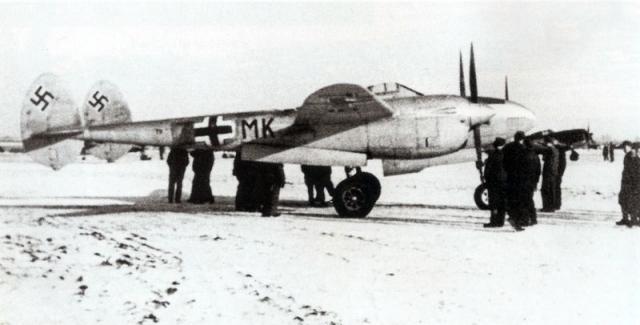
Lockheed P-38F-5E "T9+MK"
Photo : auteur et source inconnus - author and source unknown
Vers 15h00, il se pose à Milan-Linate et est capturé par les italiens. L'avion est rapidement camouflé en bout de piste. Quelques jours plus tard, le Tenente Brini, de l'Aeronautica Nazionale Repubblicana, convoie le F-5 à Villafranca, près de Vérone, où il sera sera repeint en jaunes avec marquages allemands.
At about 3:00 pm, he landed at Milan-Linate and was captured by the Italians. The aircraft was quickly hidden at the end of the runway. A few days later, the Tenente Brini, of the Aeronautica Nazionale Repubblicana, flew the F-5 at Villafranca, near Verona, where it was repainted in yellow color with German markings.
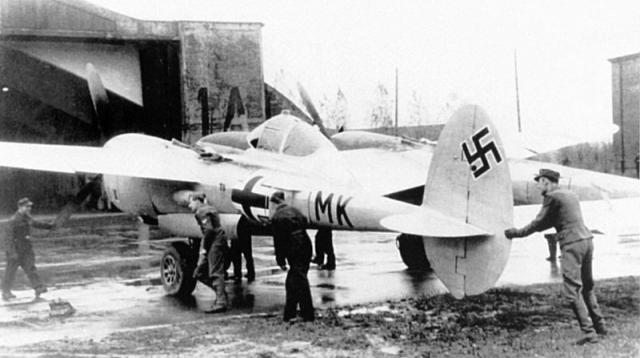
Lockheed P-38F-5E "T9+MK"
Photo : auteur et source inconnus - author and source unknown
Puis il sera livré aux allemands, au centre d'essai Erprobungstelle Rechlin, puis au "Rosarius Zirkus". Monti rejoindra quant à lui un bureau berlinois de propagandistes de la SS, formé d'Américains et de Britanniques. Il prendra le pseudonyme de "Captain Wiethaupt". Il avait essayé mais en vain de rejoindre au préalable la Luftwaffe. En avril 1945, il s'enfuit vers le nord de l'Italie mais est arrêté par des partisans communistes qui le livreront aux Américains. Il passe en cour martiale en 1946 pour désertion et "vol de matériel d'une valeur de plus de 50 dollars" !
He was then given to the Germans, and sent to the test center Erprobungstelle Rechlin, then to the "Rosarius Zirkus". Monti joined an office of SS propagandist in Berlin, composed of Americans and British. He adopted the pseudonym of "Captain Wiethaupt". He had tried but unsuccessful to join the Luftwaffe. In April, 1945, he escaped in northern Italy but was arrested by communist partisans who handed him over the Americans. He was court-martialled in 1946 for desertion and "theft of equipment worth over 50 dollars"!
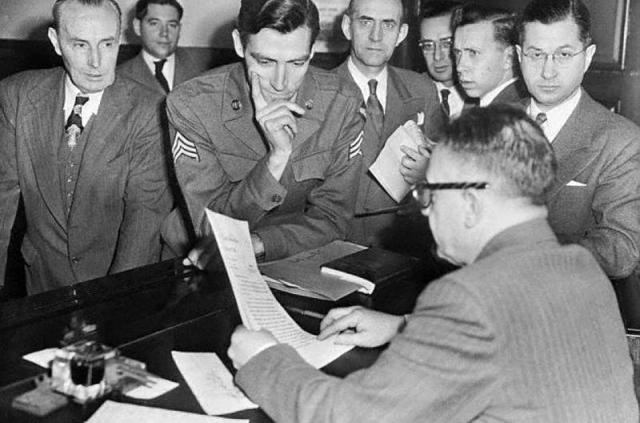
Martin James Monti
A son second procès - During his second trial
Photo : auteur et source inconnus - author and source unknown
Sans état d'âme, Monti invoque qu'il avait "emprunté" l'avion pour se battre, mais que touché par la Flak il avait été capturé, et avait ensuite réussi à s'évader. Le doute lui profitant, Monti est finalement condamné à 15 ans de prison pour absence injustifiée et vols, et sera grâcié en 1947 à condition de s'engager dans l'US Army comme simple soldat. Mais le FBI, qui a continué l'enquête, l'arrête en janvier 1948. Il sera jugé entre autre pour trahison et risquera la peine de mort ; plaidant coupable, il est condamné à 25 ans de prison et 10 000 dollars d'amende. Il sortira finalement en 1960 et mourut en 2000 dans l'anonymat.
Without complex, Monti said that he had "borrowed" the aircraft to fight, but that he was hit by the Flak, had been captured, and had then managed to escape. With the benefit of the doubt, Monti was finally sentenced to 15 years of imprisonment for unjustified absence and thefts, and was pardoned in 1947 on the condition of enlisting in the US ARMY as single private. But the FBI, which continued the investigation, arrested him again in January, 1948. He was judged for treason and was risking the death penalty ; pleading guilty, he was sentenced to 25 years of imprisonment with a 10,000 dollars' fine. He came out finally in 1960 and died unknown in 2000.
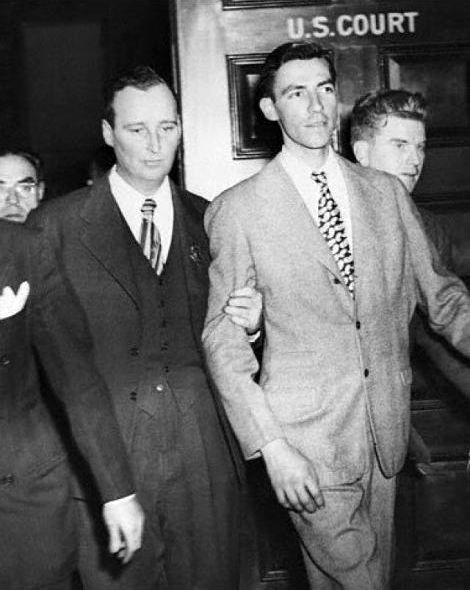
Martin James Monti
A son second procès - During his second trial
Photo : auteur et source inconnus - author and source unknown
Le théâtre Pacifique - Pacific theater
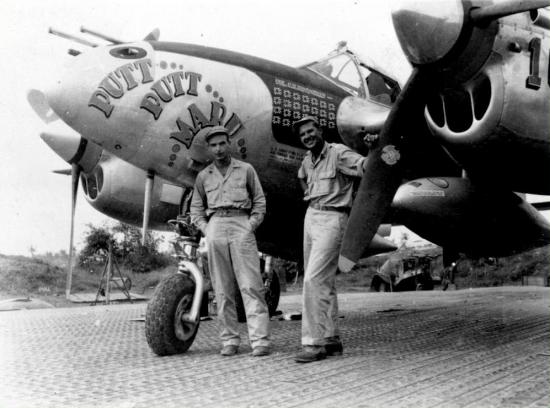
P-38-J - Col. Mac Donald and Al Nelson(Pacifique - Pacific).
© USAF (domaine public - public domain)
Le P-38 a été utilisé très largement avec succès sur le théâtre Pacifique : il a été crédité de la destruction de plus d'avions japonais que tout autre avion de chasse de l'USAAF. Bien que le P-38 ne puisse pas prendre le dessus sur le Mitsubishi A6M le Zéro et sur la plupart des autres avions de chasse japonais, sa vitesse et sa vitesse ascensionnelle donnait le choix aux pilotes américains de se battre ou de foncer et sa puissance de feu concentrée était plus mortelle pour les avions de guerre japonais légèrement blindés que pour les allemands.
The P-38 was used most extensively and successfully in the Pacific theatre : it was credited with destroying more Japanese aircraft than any other USAAF fighter. While the P-38 could not out-maneuver the Mitsubishi A6M Zero and most other Japanese fighters, its speed and rate of climb gave American pilots the option of choosing to fight or run, and its focused firepower was even more deadly to lightly-armored Japanese warplanes than to the Germans'.
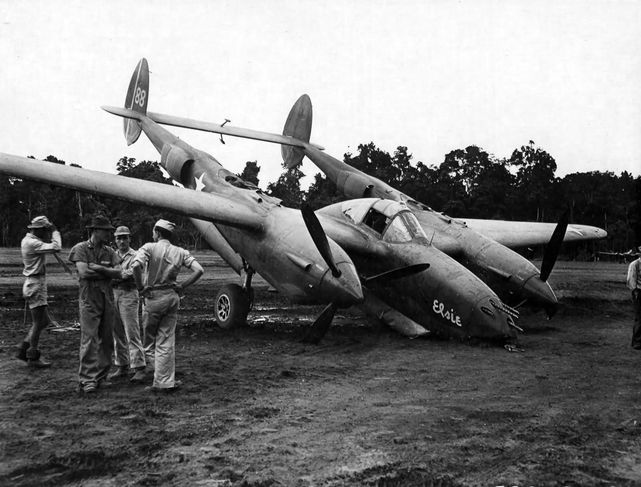
P-38-F "88" - Dobodura Nouvelle-Guinée, 5 avril 1943 - New-Guinea, 5th April, 1943.
© USAF (domaine public - public domain)
Le flot concentré et parallèle de balles permettait une victoire aérienne à une distance beaucoup plus longue qu'avec des avions de chasse équipés d'armes dans les ailes. Il est donc ironique que Dick Bong, ayant le plus haut score de as américains de la Deuxième Guerre mondiale (40 victoires uniquement sur P-38), volait directement sur ses cibles pour s'assurer qu'il les avait frappées, allant dans certains cas jusqu'à voler au travers des débris de sa cible.
The concentrated, parallel stream of bullets allowed aerial victory at much longer distances than fighters carrying wing guns. It is therefore ironic that Dick Bong, the highest scoring World War II American air ace (40 victories solely in P-38s), would fly directly at his targets to make sure he hit them, in some cases flying through the debris of his target.
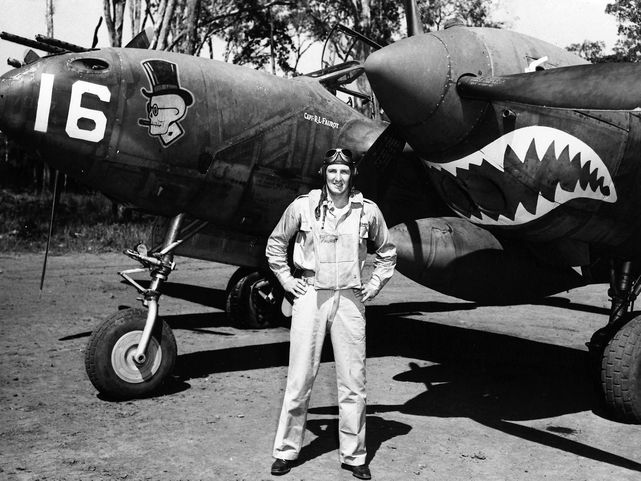
P-38F-5-LO - (42-12633 ou/or 42-12623) Schwimmer Air Base "14 mile", Laloki, Nouvelle-Guinée - New Guinea
Captain Robert L. Faurot
Premier pilote à remporter une victoire dans le Pacifique
.First pilot claiming an airkill inf Pacific
©2007 MFA Productions LLC Image in the Public Domain
Du 2 au 4 mars 1943, les P-38 assurèrent la couverture supérieure de la Cinquième Air Force et des bombardiers et avions d'assaut australiens pendant la Bataille de la Mer de Bismarck, une défaite écrasante pour les japonais. Deux as sur P-38 du 39ème Fighter Squadron furent tués le deuxième jour de la bataille : Bob Faurot et Hoyt "Curley" Eason (un vétéran avec cinq victoires qui avaient formé des centaines de pilotes, incluant Dick Bong).
On 2-4 March 1943, P-38s flew top cover for Fifth Air Force and Australian bombers and attack-planes during the Battle of the Bismarck Sea, a crushing defeat for the Japanese. Two P-38 aces from the 39th Fighter Squadron were killed on the second day of the battle: Bob Faurot and Hoyt "Curley" Eason (a veteran with five victories who had trained hundreds of pilots, including Dick Bong).
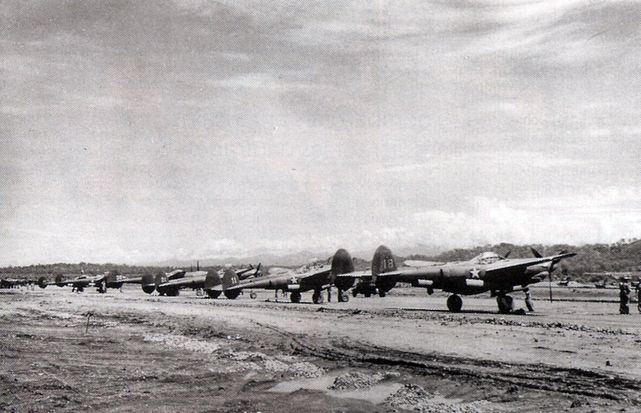
P-38 F - 39th FS/35th FG - 17-mille airfield - Port Moresby - Mars 1943 - March 1943.
© USAF (domaine public - public domain)
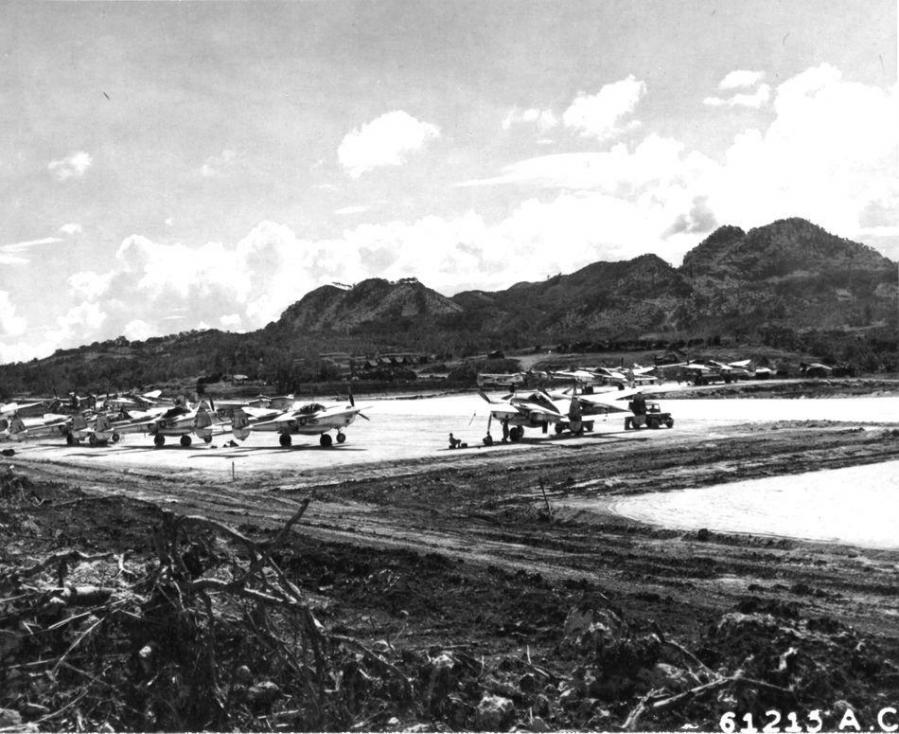
Lockheed F-4 & F-5E - 8th Photo Recon Sq Motabu airstrip, Okinawa
© USAF NARA 342-FH-3A04038-61215AC (domaine public - public domain)
Isoroku Yamamoto
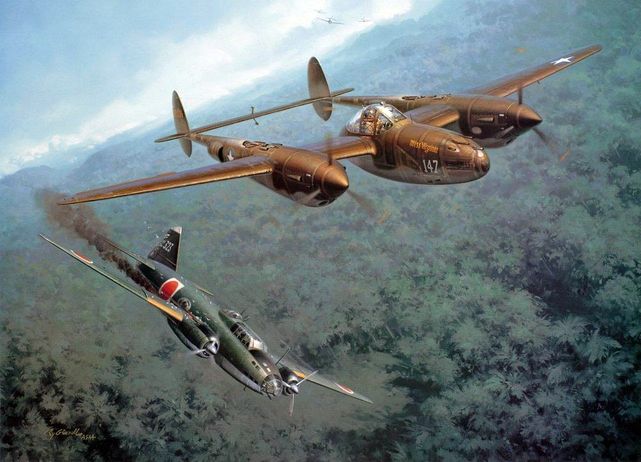
"Mission Accomplished"
Lockheed P-38G - 1st Lt. Lt. Rex T. Barber, 339th FS, 347th FG, 13th AF
18 avril 1943, Bougainville - 18th April, 1943, Bougainville
© Roy GRINNELL - www.roygrinell.com
Le Lightning participa à l'une des opérations les plus célèbres du théâtre du Pacifique : la fin, le 18 avril 1943, de l'Amiral Isoroku Yamamoto, l'architecte de la stratégie navale du Japon dans le Pacifique dont l'attaque de Pearl Harbor. Quand les services du déchiffrage américain ont découvert qu'il s'envolerait pour l'Île de Bougainville afin de faire une inspection du front, 16 Lightning P-38G équipés de réservoirs supplémentaires (339ème FS, 347ème FG, 13ème Air Force) furent envoyés en mission d'interception longue distance, parcourant 435 miles (700 km) à partir de Guadalcanal à des altitudes de 10-15 pieds (3-15 m) au dessus de l'océan pour éviter les détections.
The Lightning figured in one of the most significant operations in the Pacific theater: the interception, on 18 April 1943, of Admiral Isoroku Yamamoto, the architect of Japan's naval strategy in the Pacific including the attack on Pearl Harbor. When American code breakers found out that he was flying to Bougainville Island to conduct a front-line inspection, 16 P-38G Lightnings equipped with drop tanks (339th FS, 347thth Air Force) were sent on a long-range fighter-intercept mission, flying 435 mi (700 km) from Guadalcanal at heights from 10-50 ft (3-15 m) above the ocean to avoid detection.
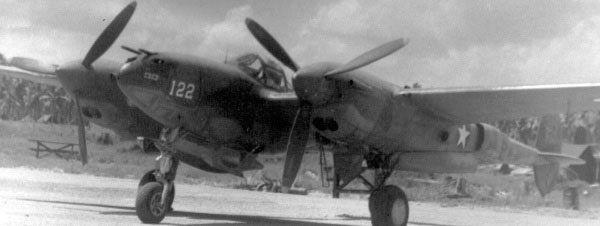
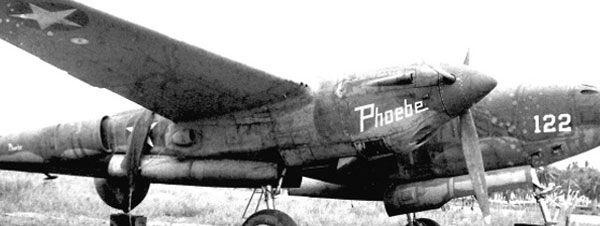
P-38G-13-LO “Phoebe” s/n 43-2338 - Thomas G. Lanphier
© USAF (domaine public - public domain)
Les Lightning tombèrent sur les deux Mitsubishi G4M "Betty" de Yamamoto et six Zéros d'escorte juste comme ils arrivaient. Le premier Betty (abattu par Thomas G. Lanphier et Rex T. Barber) s'écrasa dans la jungle et le second s'abîma en mer près de la côte. Deux Zéros furent également revendiqués par les chasseurs Américains contre la perte d'un P-38 (Lt. Raymond K. Hine). Les Japonais retrouvèrent le corps de Yamamoto sur le site du crash dans la jungle le jour suivant.
The Lightnings met Yamamoto's two Mitsubishi G4M "Betty" and six escorting Zeros just as they arrived. The first Betty crashed in the jungle and the second ditched near the coast. Two Zeros were also claimed by the American fighters with the loss of one P-38 (Lt. Raymond K. Hine). Japanese searchers found Yamamoto's body at the jungle crash site the next day.
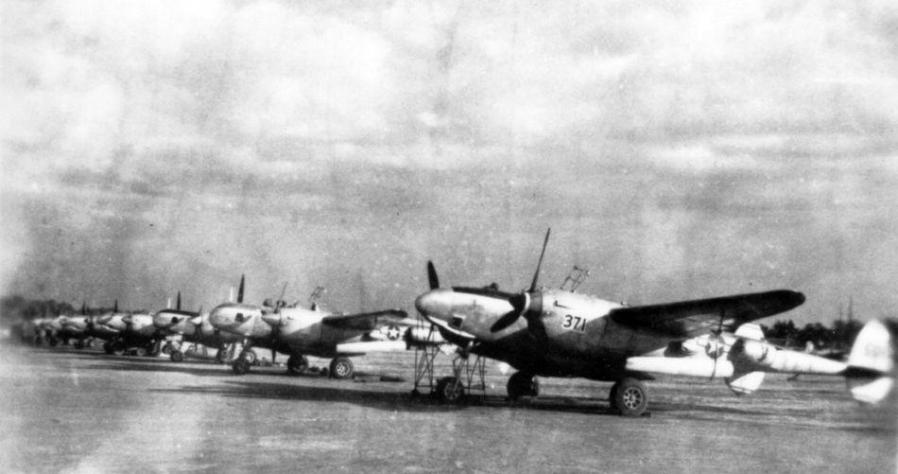
P-38 F-5F ('371') & F-5G - 8th PRS, Chofu (Japon, fin 1945 - Japan, late 1945)
© San Diego Air and Space Museum archives
Sur le théâtre du Pacifique, les P-38 abattirent plus de 1800 avions japonais, avec plus de 100 pilotes qui devinrent des as en abattant au moins cinq ennemis.
In the Pacific theater, the P-38 downed over 1,800 Japanese aircraft, with more than 100 pilots becoming aces by downing five or more enemy.

Lockheed P-38-H-5-LO (s/n 42-67008), 459th FS, 80th FG.
Inde, 1944 - India, 1944.
© Thomas A. Tullis - TULLIS AVIATION ART Ltd - www.tullisart.com

Lockheed P-38-G - Detachment B, 6th Night Fighter Squadron, Carey Field,
Guadalcanal (Iles Salomon), été 1943 - Guadalcanal (Solomon Islands), Summer 1943.
© Jean-Marie Guillou
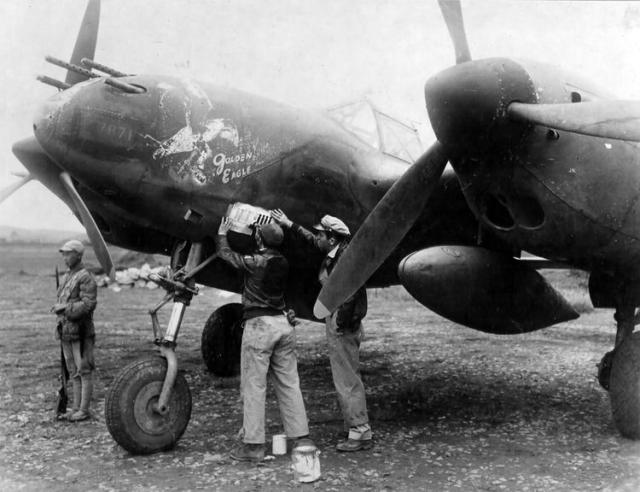
Lockheed P-38-G - 42-13437 “The Golden Eagle”, Capt Billie Beardsley, 51st FG, 449th FS
© USAF (domaine public - public domain)
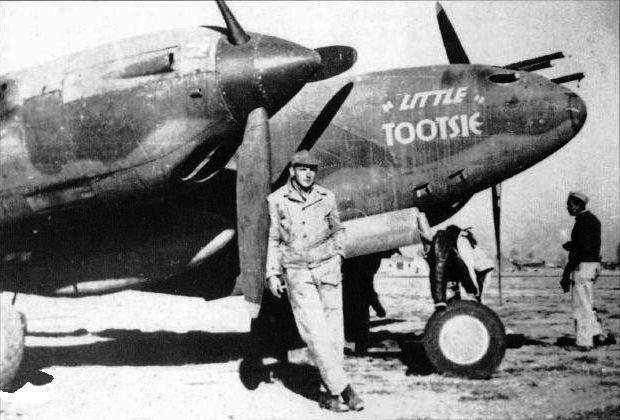
Lockheed P-38-G - “Little Tootsie”, 51st FG, 449th FS - Chine, été 1943 - China, Summer 1943
© USAF (domaine public - public domain)
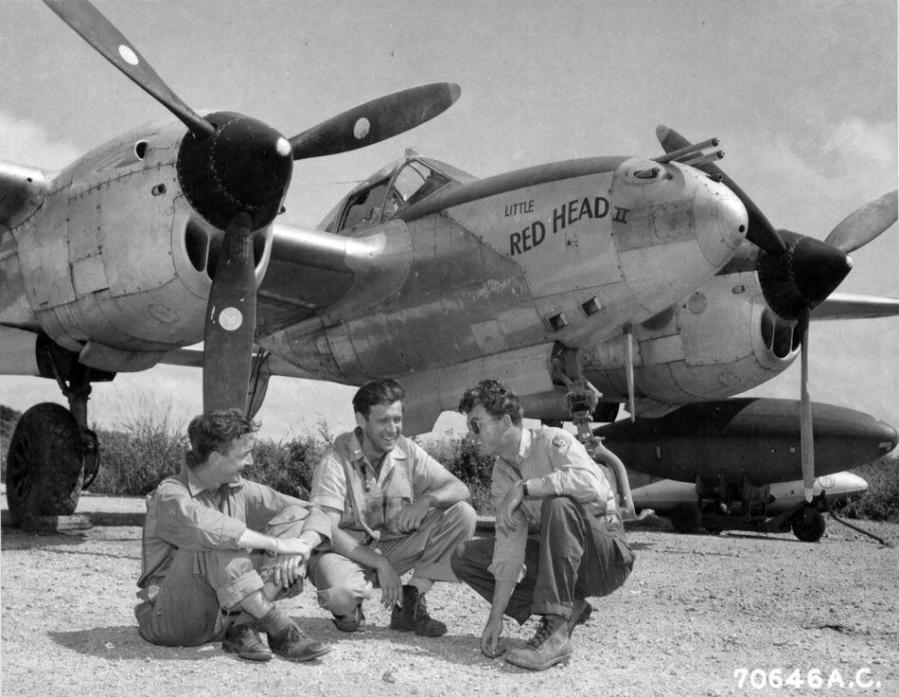
Lockheed P-38-L (s/n 44-240089) - “Little Red Head II”, 73rd FS, 318th FG
1st Lt . Owen R. McCaul (à droite - right), 1st Lt. Robert L. Shepard (à gauche - left), 2nd Lt. Gerald L. "Jerry" Heagney (au centre - center)
Saïpan, Iles Mariannes, 25 novembre 1944 - Saipan, Marianas Islands, 25th November 1944
© USAF (domaine public - public domain) NARA 342-FH-3A39031-70646AC
P-38 britannique - British P-38
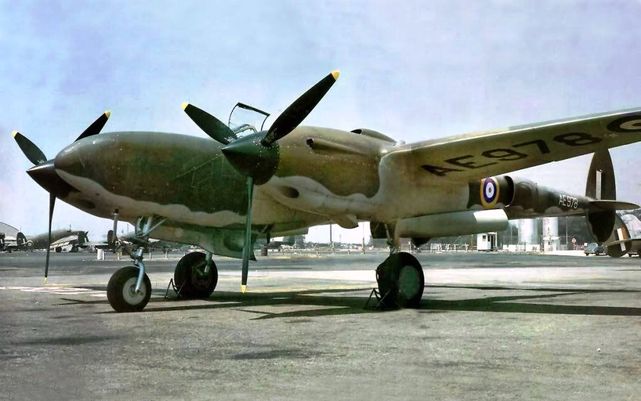
Lightning Mk I (AE978)
aux couleurs britanniques - under british colors
Photo : auteur inconnu - author unknown
Les anglais s'intéressèrent au Lockheed P-38 qu'ils baptisèrent d'abord "Atlanta" avant de finalement choisir "Lightning" comme les américains. En avril 1940, une commission d'achat franco-britannique fut envoyée aux USA et signa un contrat pour la livraison de 800 Lockheed L-322 (dont 417 prévus pour la France), version export du P-38. Le 18 mai, la commande fut revue à 667 appareils et le reste en pièces de rechange.
The English were interested by the Lockheed P-38 that they named at first "Atlanta" before choosing finally "Lightning" like the Americans. In April, 1940, a French-British purchase commission was sent in the USA and signed a contract for the delivery of 800 Lockheed L-322 (including 417 units for France), the export version of P-38. On May 18th, the order was modified in 667 units and the rest in spare parts.
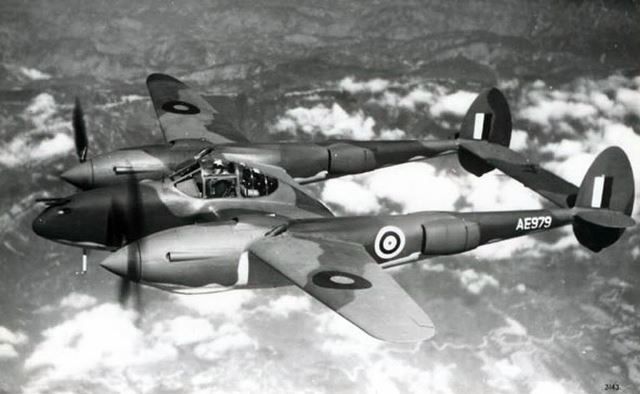
Lightning Mk I (AE979)
Photo UPL 19877 © IWM - www.americanairmuseum.com
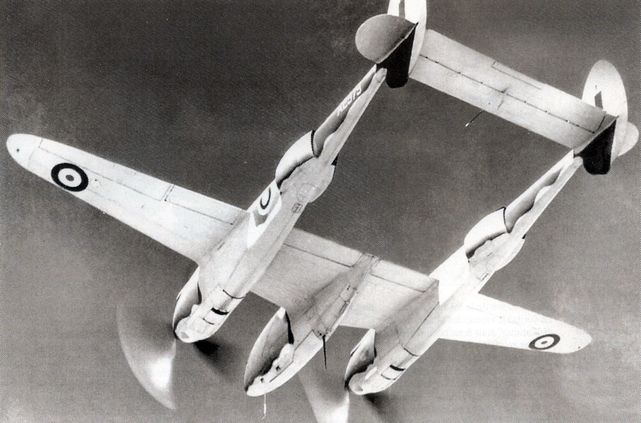
Lightning Mk I (AE979)
Photo : auteur inconnu - author unknown
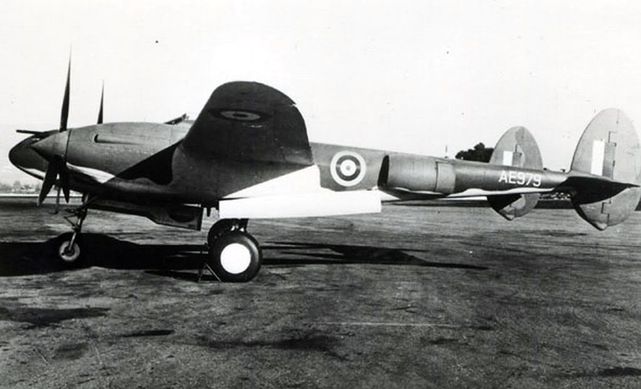
Lightning Mk I (AE979)
Photo UPL 19876 © IWM - www.americanairmuseum.com
 Les livraisons devaient débuter mi-septembre 1941. La version pour la France s'appelait 322-F (Model 322-61-03) et celle pour le Royaume-Uni 322-B (Model 322-61-04). Les différences portaient sur les instruments (système métrique pour la France), la manette des gaz (inversée), la radio et l'armement (fourni par les français). Pour diverses raisons, il fut choisi également le moteur Allison V-1710-C15 mais sans turbo-compresseur ce qui conféra au Lightning 322 le surnom de "Castrated Lightning".
Les livraisons devaient débuter mi-septembre 1941. La version pour la France s'appelait 322-F (Model 322-61-03) et celle pour le Royaume-Uni 322-B (Model 322-61-04). Les différences portaient sur les instruments (système métrique pour la France), la manette des gaz (inversée), la radio et l'armement (fourni par les français). Pour diverses raisons, il fut choisi également le moteur Allison V-1710-C15 mais sans turbo-compresseur ce qui conféra au Lightning 322 le surnom de "Castrated Lightning".
The deliveries had to begin in the middle of September, 1941. The version for France was called 322-F (Model 322-61-03) and the version for the United Kingdom 322-B (Model 322-61-04). The differences concerned instruments (metric system for France), the throttle control (reversed), the radio and the armament (supplied by French). For some reasons, the engine Allison V-1710-C15 was also chosen but without turbo-compressor which conferred to Lightning 322 the nickname of "Castrated Lightning".
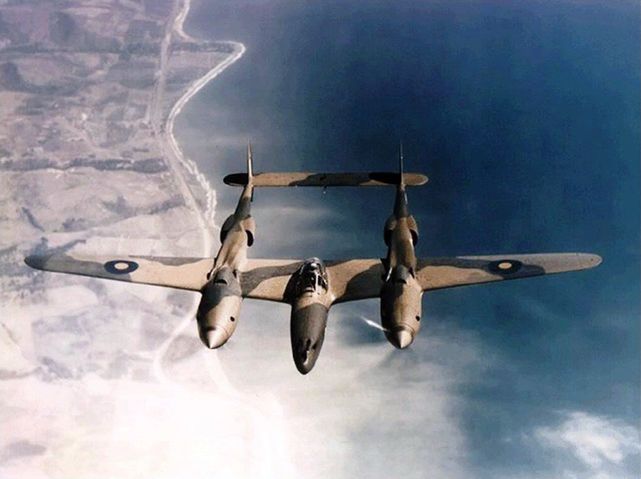
Lightning Mk I
Photo UPL 19882 © IWM - www.americanairmuseum.com
A la défaite française de juin 1940, les anglais reprirent les commandes françaises. L'évolution du conflit fit évoluer les exigences britanniques, qui demandèrent finalement les turbo-compresseurs, mais aussi des réservoirs de carburant auto-obturants, des blindages et pare-brise pare-balles. Au final, le contrat fut revu en juillet 1941 et proposa une livraison de 143 Lightning Mk I (322-B initiaux) puis 524 Mk II équipés de moteurs Allison V-1710-F5L et F5R (sens de rotation inversé) avec turbo-compresseurs (similaires aux P-38E de l'USAAF).
After the French defeat of June, 1940, English kept the French order. The evolution of the war changed the British requirements, who finally asked for turbo-compressors, but also for self-sealing tanks, armor platings and bulletproof windscreen. At the end, the contract was modified in July, 1941 and proposed a delivery of 143 Lightning Mk I (initial 322-B) followed by 524 Mk II fitted with Allison V-1710-F5L and F5R engines (reversed rotation) with turbo-compressors (similar to the P-38E of the USAAF).

Lightning (AE979)
Artiste inconnu - artist unknown
Un pilote de la RAF essaya un premier 322-B à Burbank à partir de septembre 1941 et son rapport fut mitigé. Les britanniques exclurent donc de réceptionner des Lightning sans turbo-compresseur. Les relations entre la RAF et Lockheed se durcirent et la commande fut annulée.
A RAF pilot tested the first 322-B at Burbank from September, 1941 and his report was mixed. The British thus refused to get Lightnings without turbo-compressor. The relations between the RAF and Lockheed became harder and the order was cancelled.
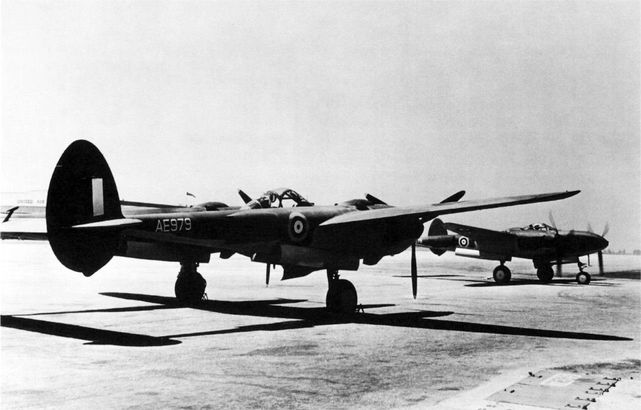
Lightning Mk I (AE979 & AE978)
Photo UPL 19875 © IWM - www.americanairmuseum.com
En réalité, les britanniques préféraient profiter de la loi lend-lease de mars 1941 pour ne pas financer leur commande. Pourtant, Lockheed continua la production de Mk I et les entreposa, espérant obtenir le paiement de ces avions par les Britanniques.
In fact, the British preferred to take advantage of the lend-lease law decided in March, 1941 instead of financing by their own their order. Nevertheless, Lockheed did not stop the production of Mk I and stored them, expecting to obtain the payment of these aircrfats by the British.
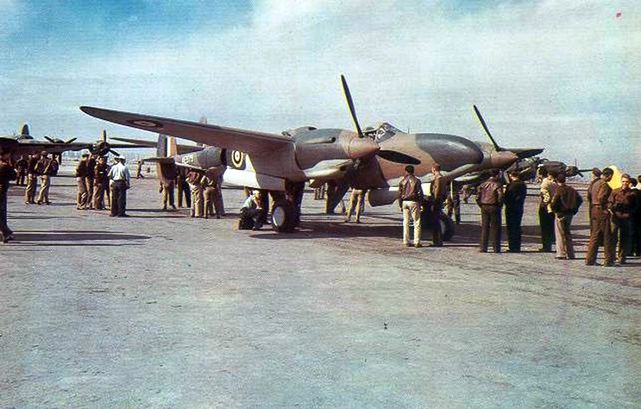
Lightning Mk I (AE979)
Photo UPL 19874 © IWM - www.americanairmuseum.com
 Le premier Lightning Mk I (AE978) fut livré en décembre 1941 ; a priori il resta aux USA. Le AE979 fut repris par les américains en tant que RP-322. 3 Lightning Mk I, codes AF105, AF106 et AF107 (108 selon une autre source), furent envoyés pour évaluation en Angleterre en mars 1942.
Le premier Lightning Mk I (AE978) fut livré en décembre 1941 ; a priori il resta aux USA. Le AE979 fut repris par les américains en tant que RP-322. 3 Lightning Mk I, codes AF105, AF106 et AF107 (108 selon une autre source), furent envoyés pour évaluation en Angleterre en mars 1942.
The first Lightning Mk I (AE978) was delivered in December, 1941 ; she probably remained in USA. The AE979 was recovered by the americans as RP-322. 3 Lightning Mk I, codes AF105, AF106 and AF107 (108 according to another source) were sent for evaluation in England on March, 1942.

Lockheed RP-322 (AF207)
Chico airfield (Californie - California) - Fin 1942 - Late 1942
© Pierre André Tilley
Un avion (AF105) fut réceptionné par la société Cunliffe-Owen Aircraft Limited (à Swaythling) puis envoyé à l'Aircraft & Armament Experimental Establishment (A&AEE) à Boscombe Down, le second (AF106) directement à l'A&AEE, et le troisième au Royal Aircraft Establishment (RAE) à Farnborough. Les essais furent peu concluants, et les avions, non payés, furent renvoyés aux USA.
One unit (AF105) was received by the Cunliffe-Owen Aircraft Limited company (located at Swaythling) and then sent to Aircraft & Armament Experimental Establishment (A&AEE) at Boscombe Down, the second unit (AF106) was directly sent to the A&AEE, and the third one to the Royal Aircraft Establishment (RAE) in Farnborough. The tests were inconclusive, and the aircrfats, unpaid, were sent back in the USA.
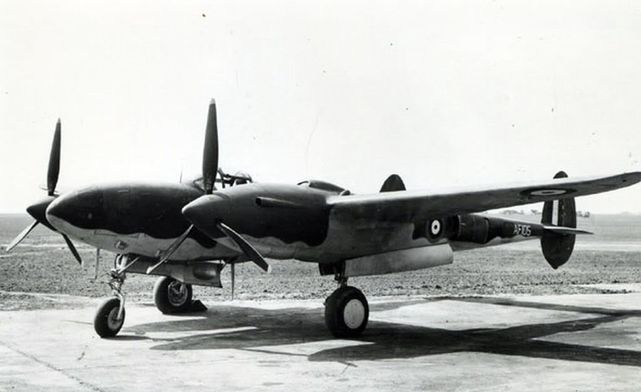
Lightning (AF105)
Photo : auteur inconnu - author unknown
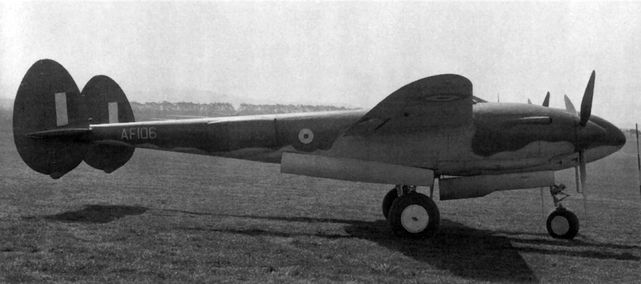
Lightning Mk I (AF106)
Photo UPL 19880 © IWM - www.americanairmuseum.com
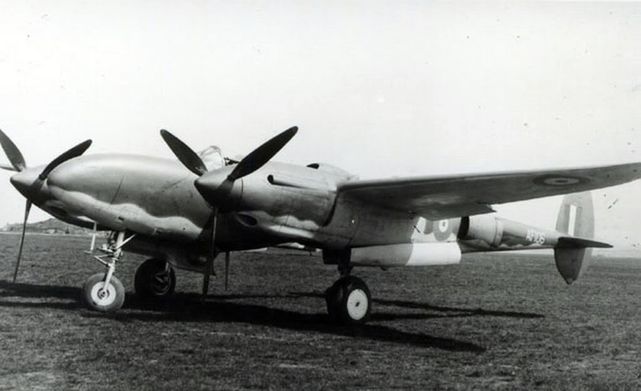
Lightning Mk I (AF106)
Photo UPL 19879 © IWM - www.americanairmuseum.com
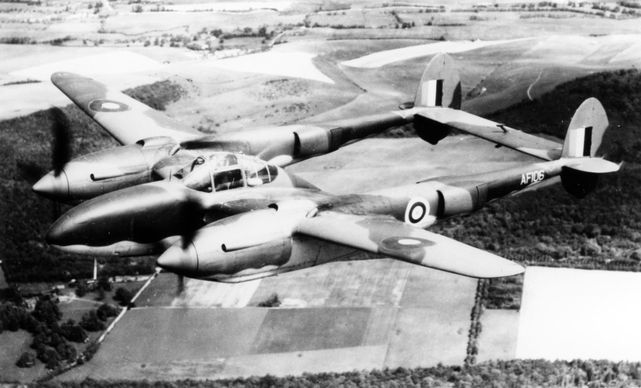
Lightning Mk I (AF106)
Photo : auteur inconnu - author unknown
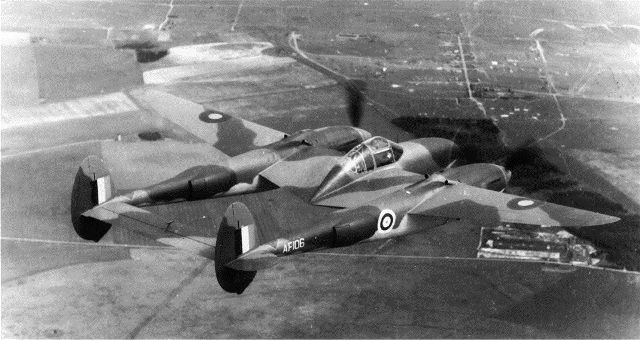
Lightning Mk I (AF106)
Photo UPL 19881 © IWM - www.americanairmuseum.com

Lightning (AF106) © Vincent Dhorne
L'entrée en guerre des USA permit de débloquer la situation : les Mk I fabriqués et stockés furent repris par l'USAAF et affectés à l'entraînement des pilotes sous le nom de P-322, et conservèrent le camouflage et le matricule RAF.
The entry of the USA in World War solved the situation : the Mk Is manufactured and stored were taken by the USAAF and allocated to the pilots training under the name of P-322. They kept the RAF camouflage and numbers.
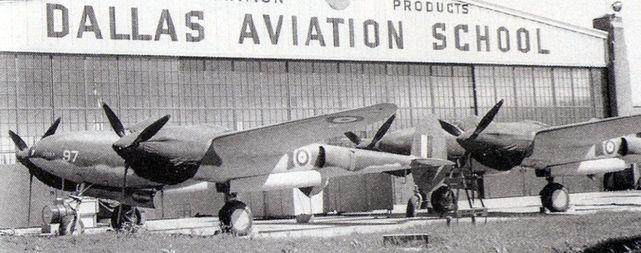
Lightning Mk I
Photo : auteur inconnu - author unknown
Un Lockheed Lightning Mk II (AF221) fut fabriqué mais resta aux USA pour des tests d'armement. De la commande initiale britannique, les 523 appareils restant furent construits comme P-38F (149 exemplaires) et P-38G (374 exemplaires) pour l'USAAF.
One Lockheed Lightning Mk II (AF221) was manufactured but remained in the USA for armament tests. Out of the initial British order, 523 remaining aircrafts were built as P-38F (149 units) and P-38G (374 units) for the USAAF.

Lightning (AF221)
Essais de torpille - Torpedo tests
© Lockheed
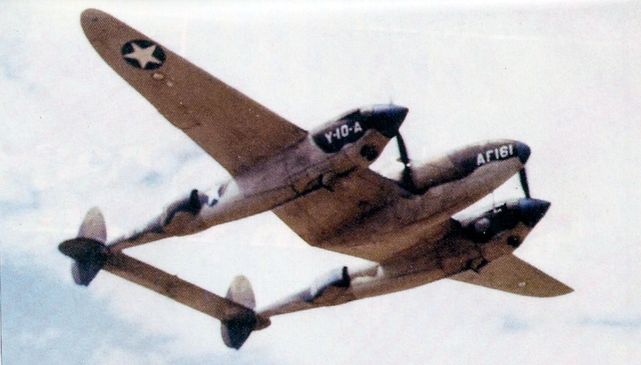
Lightning (AF161)
© USAF (domaine public - public domain)
En 1944, le n°5 Group du Bomber Command est commandé par l'Air Commodore Sharp. Basé à Coningsby, il pilotait un P-47 qu'il échangea contre le P-38J-20 s/n 44-23517. Ce dernier fut utilisé pour des missions d'escorte ou de marquage (on ne sait pas exactement) avec des Lancaster, piloté par le Squadron Leader Owen. Il fut plus tard modifié en biplace et équipé d'un nez transparent. Il finira dans le dépôt de Lichfield. Le 6 août 1944, un second P-38 arrive à Coningsby pour des tests : le P38L-1 44-24360, appelé "PB-38", modifié pour être équipé d'un nez transparent.
In 1944, the 5th Group of Bomber Command was leaded by the Air Commodore Sharp. Based in Coningsby, he flew a P-47 that he exchanged for a P-38J-20 s/n 44-23517. This one was used for escort or marking missions (we do not know exactly) with Lancasters, flown by the Squadron Leader Owen. She was then modified into a twinseat version and fitted with a transparent nose. She finished in the depot of Lichfield. On August 6th, 1944, a second P-38 arrived at Coningsby for tests : the P38L-1 44-24360, nicknamed " PB-38 ", was modified to be fitted with a transparent nose
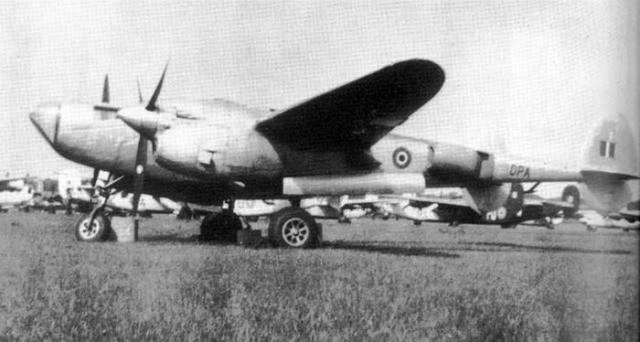
Lightning P38J-20 44-23517 - Lichfield, 1945
Photo UPL 19741 © IWM - www.americanairmuseum.com

Lightning P38J-20 44-23517 - Lichfield, 1945
© Pierre André Tilley
Quelques anecdotes - Single stories
Un P-38 pour deux - A P-38 for two !
Le 4 août 1944, 43 Lightning P-38 du 82nd FG décollent du terrain satellite n°11 (sur environ 30 terrains) de Foggia pour une mission d'attaque (Frantic 4) de la base aérienne de Focsani (Roumanie) à environ 100 kms au nord de Ploesti. Parmi ces P-38, Dick Andrews vole dans la section du leader, le Colonel William Litton, commandant de la mission à la tête du 96th FS. Un autre pilote, Dick Willsie, vole dans une section de queue. Les P-38 devaient attaquer à basse altitude au travers d'une flak intense. Dick Willsie sentit des projectiles toucher son avion. Son moteur gauche fut touché et il mit aussitôt l'hélice en drapeau. Volant sur le moteur droit, il mitrailla un Me 109 puis un Me 323 qui explosa.
On August 4th, 1944, 43 Lightning P-38 of 82nd FG took off from the Foggia satellite airfield # 11 (out of approximately 30 airfields) for an attack (mission Frantic 4) of the Focsani air base (Romania) at about 60 miles north of Ploesti. Among these P-38, Dick Andrews flew in the section of the leader, Colonel William Litton, commanding the mission at the head of 96th FS. Another pilot, Dick Willsie, flew in a rear section. The P-38s were to attack at low altitude through an intense flak. Dick Willsie felt projectiles hitting his plane. His left engine was hit and he feathered the propeller. Flying on the right engine, he machine-gunned a Me 109 then a Me 323 which exploded.
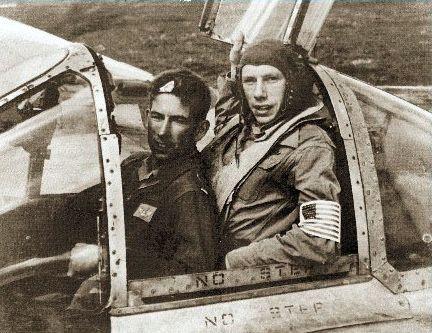
Dick Willsie & Dick Andrews
Photo : auteur inconnu - author unknown
Mais son moteur droit fut également touché et Willsie annonça à la radio qu'il allait devoir se crasher. Dick Andrews, qui avait épuisé ses munitions, lui répondit : "trouve-moi un terrain plat et je viens te chercher". Willsie se posa sur le ventre dans un champ. Andrews effectua une première passe mais ne réussit pas à se poser ; il remonta, fit un virage et revint se poser à proximité de Willsie. Willsie avait posé une charge explosive sur son avion qui explosa. Puis il courut vers l'avion d'Andrews pendant que d'autres P-38 les protégeaient en tirant sur les troupes proches. Andrews sortit de son avion, jeta son parachute, attrapa la main de Willsie et lui demanda de piloter.
But his right engine was also hit and Willsie announced with the radio that he was going to crash. Dick Andrews, who had exhausted his ammunition, answered him : "Pick a good field and I will come in after you.". Willsy landed on the belly in a field. Andrews tried to land a first time but failed ; he overshot, went around and landed again not far from Willsie. Willsie had placed an explosive charge on his plane which exploded. Then he run towards Andrews' plane while other P-38s protected them by shooting on enemy troops. Andrews went out of his plane, threw his parachute away, caught Willsie's hand and asked him to fly the aircraft.
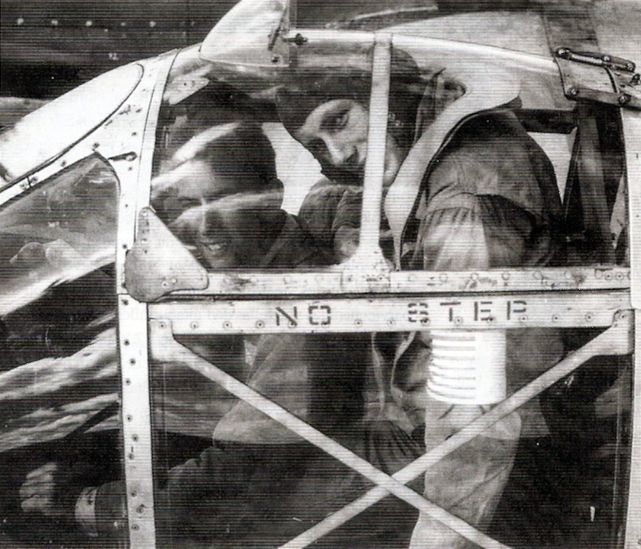
Dick Willsie & Dick Andrews - © Dick Andrews
Les deux hommes s'installèrent difficilement dans le cokpit et Willsie, tant bien que mal, réussit à décoller et frôla des arbres à moins de deux mètres. Comme Andrews avaient jeté ses cartes avec son parachute (!), ils utilisèrent une carte routière de la trousse de survie pour se diriger et rejoignirent Poltava (Ukraine) en deux heures et demi. Richard C. "Stumpy" Hollinger, technicien envoyé par Lockheed à Poltava, fut surpris de voir descendre deux pilotes de l'avion. Andrews fut décoré de la Silver Star pour cet acte de bravoure.
The two men settled with difficulty in the cokpit and Willsie hardly took off and flew very close of the trees at less than two meters. As Andrews had thrown his cards with his parachute (!), they used a road map found in the survival kit to reach Poltava (Ukraine) within two hours and half. Richard C. “Stumpy” Hollinger, a technician sent by Lockheed to Poltava, was surprised to see two pilots getting out of the aircraft. Andrews earned the Silver Star for this act of bravery.
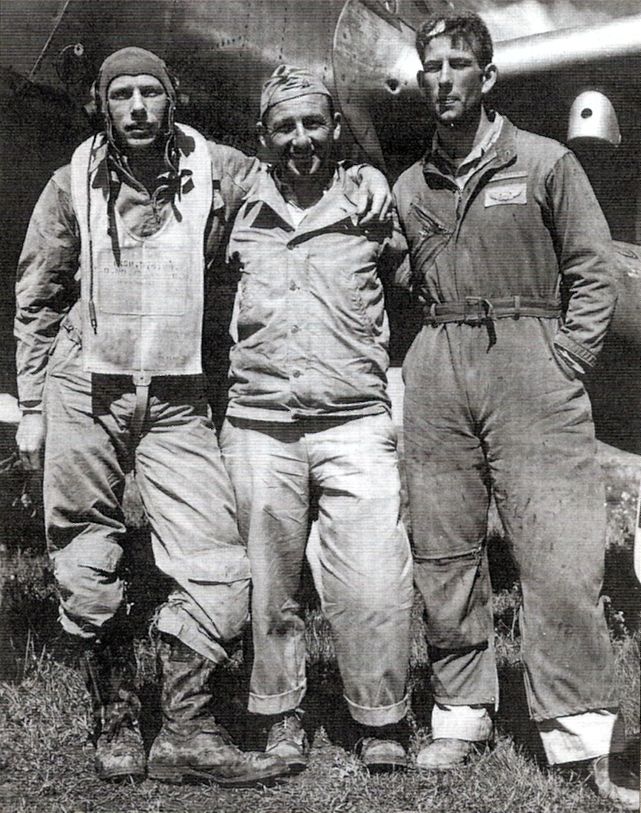
Dick Andrews, "Stumpy" Hollinger & Dick Willsie - © Dick Andrews
Un P-38 peut en cacher un autre !
A P-38 can hide another !
Le 9 novembre 1942, le capitaine James Harman a facilité, sans le savoir, l'évasion de Jack Milton Ilfrey du Portugal. Jack Ilfrey, pilotant le P-38F # 41-7587 et ayant perdu un réservoir supplémentaire lors d'une mission, fut obligé de se poser à Lisbonne, ne pouvant rejoindre l'Afrique du Nord. Interrogé par les portugais sur son avion dans un bâtiment de l'aéroport, ceux-ci lui demande ensuite, après avoir refait le plein de l'avion, de leur faire un "amphi-cabine", en particulier le capitaine Costa Macedo, pilote "polyvalent" de l'Aeronàutica Militar, qui s'assoit sur l'aile du P-38.
On November 9th, 1942, captain James Harman facilitated, without knowing it, Jack Milton Ilfrey's escape of Portugal. Jack Ilfrey, who was flying the P-38F # 41-7587 and who had lost an auxiliary tank during a mission, was obliged to land in Lisbon : he could not reach Northern Africa. After having questioned Ilfrey about his plane in a building in the airport area, the Portuguese asked him, after they had refueled the aircraft, to explain the cabin functionning, especially captain Costa Macedo, a "multi-purpose" pilot of Aeronàutica Militar, who sat on the P-38's wing.
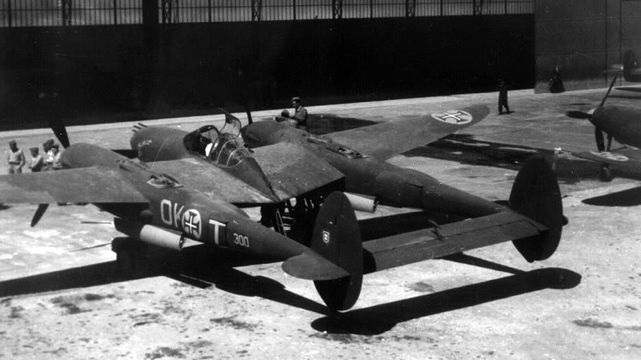
Lockheed P-38G-1-LO (42-12738, c/n 222-7172), Esquadrilha OK, Ota, 1944
auteur inconnu - author unknown
A ce moment là, James Harman, sur un second P-38, se pose à Lisbonne, avec un moteur en panne. Profitant de l'agitation, Ilfrey lance le moteur, dont l'hélice projette Macedo au sol, traverse le terrain et décolle. James Harman sera interné à Elvas, tandis que son P-38 (s/n 42-12738) deviendra le P-38 "300" avec le code OK+T (une autre source indique qu'il s'agirait plutôt du P-38F 41-7627 du Capitaine J. "Jim" A. Harmon).
Suddenly, James Harman, on a second P-38, landed in Lisbon, because of a failed engine. Taking advantage of the suprise, Ilfrey started the engine. The wind of the propeller pushed Macedo on the ground and Ilfrey crossed the airfield and took off. James Harman was interned to Elvas, and his P-38 (s/n 42-12738 ) was transformed in P-38 "300" coded OK+T (another source indicates that it could have rather been the P-38F s/n 41-7627 of Captain J. "Jim" A. Harmon).
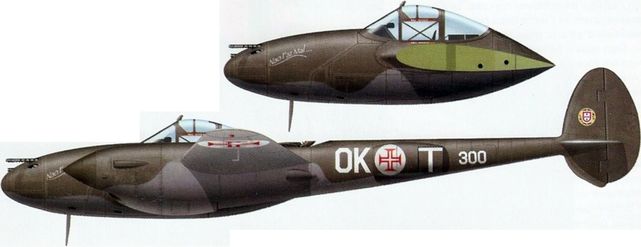
Lockheed P-38G-1-LO (42-12738, c/n 222-7172), Esquadrilha OK, Ota, 1944
© Jean-Marie Guillou
P-38 chinois - Chinese P-38s
La Chine reçu 15 P-38J et P-38L ainsi que, après la guerre, une quantité similaire de F-5E et F-5G.
China received 15 P-38Js and P-38Ls and, postwar, a similar number of F-5Es and F-5Gs.
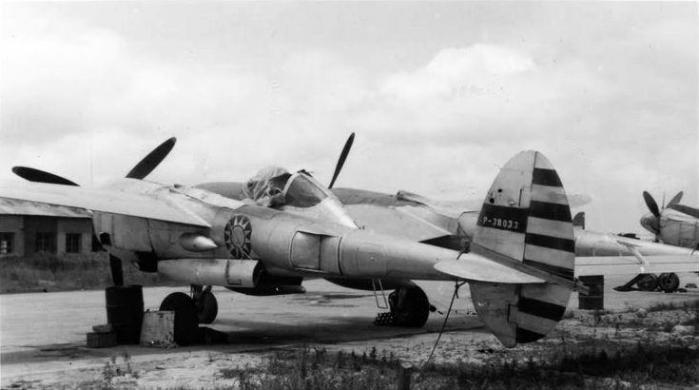
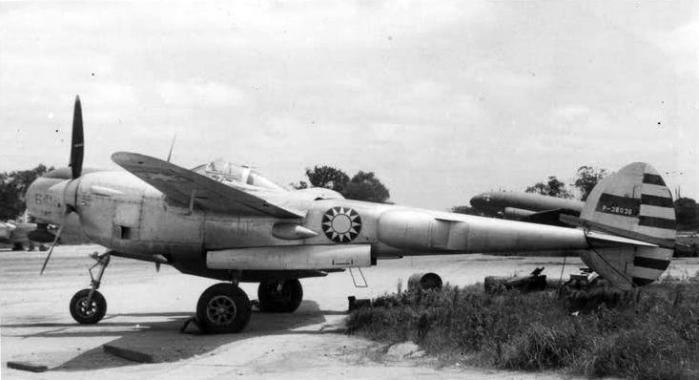
Lockheed P-38 Lightning - Armée de l'Air chinoise - Chinese Air Force
Photos source inconnue
Les as sur P-38 - P-38's aces
